By Daniel Schwartz / VII
In December 2019 it will be forty years since the Soviet invasion of Afghanistan. The country has been torn apart by foreign political and military meddling as well as internal strife ever since. The challenges of sustainable peace in Afghanistan cannot be overestimated.
What follows is a story not about troops in battle, but of a country and its people, locked in history.
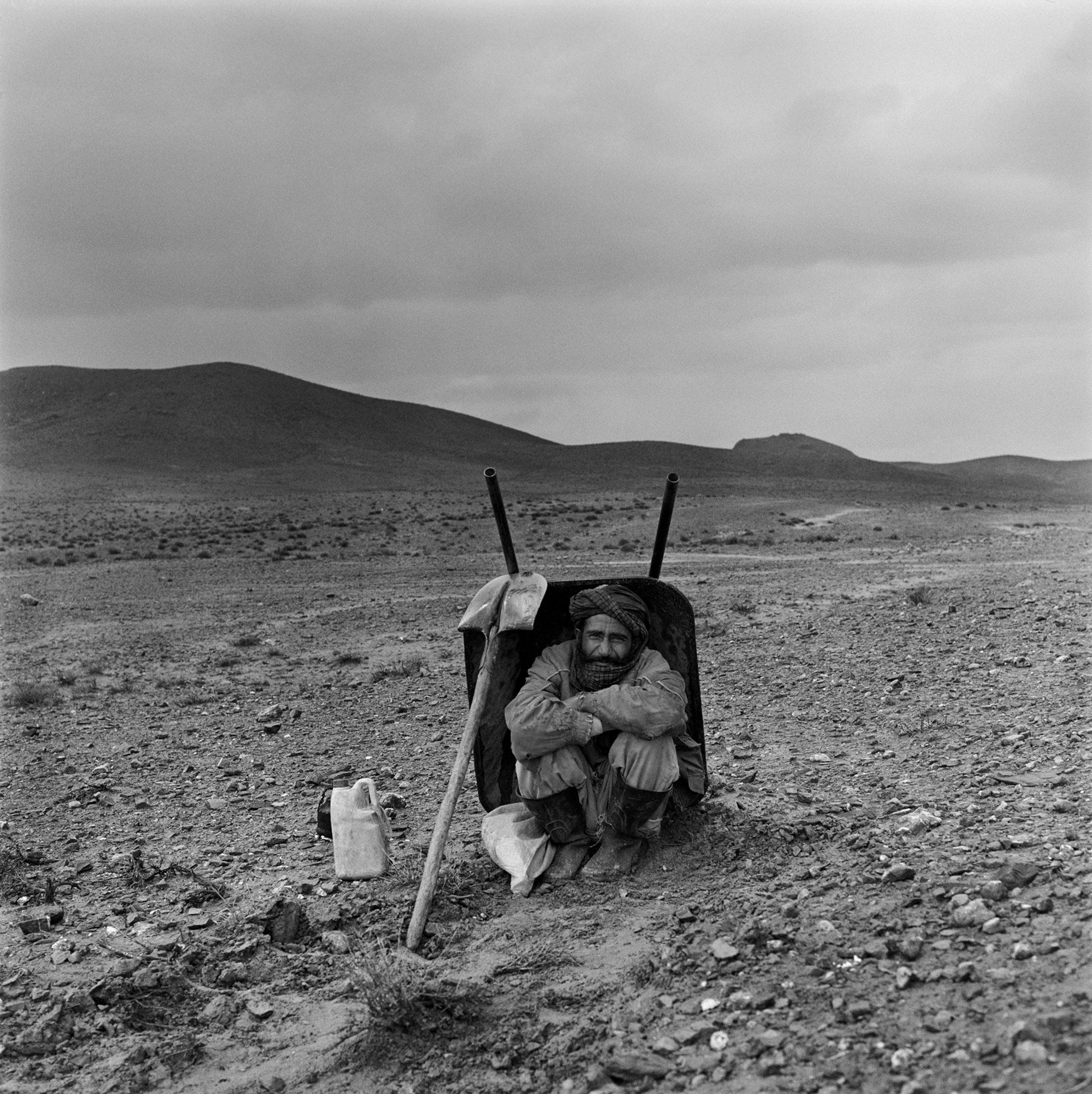
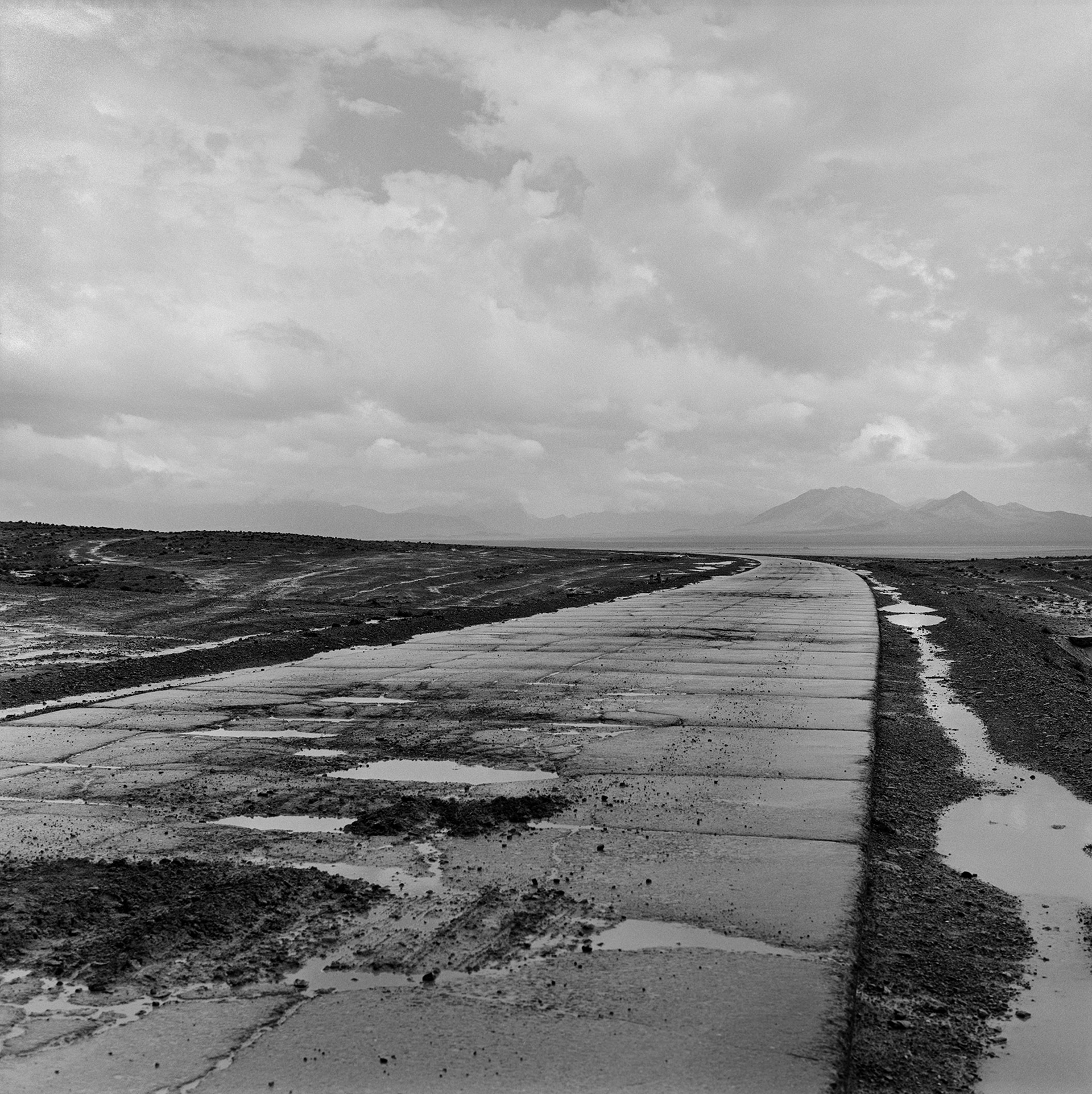
A man waits for a thunderstorm to pass on the “Betonka.” He fills the potholes with mud and gravel, a service for which he receives small donations from drivers. Farah Province, Afghanistan. 27 March, 2001.
Built by the Soviets in the 1950s and suitable for tanks, the north-western part of the Afghan ring- road—called the “Betonka”—connects Herat and Kandahar. The band of concrete slabs weathered three decades of war much better than the American tarmac in the south.
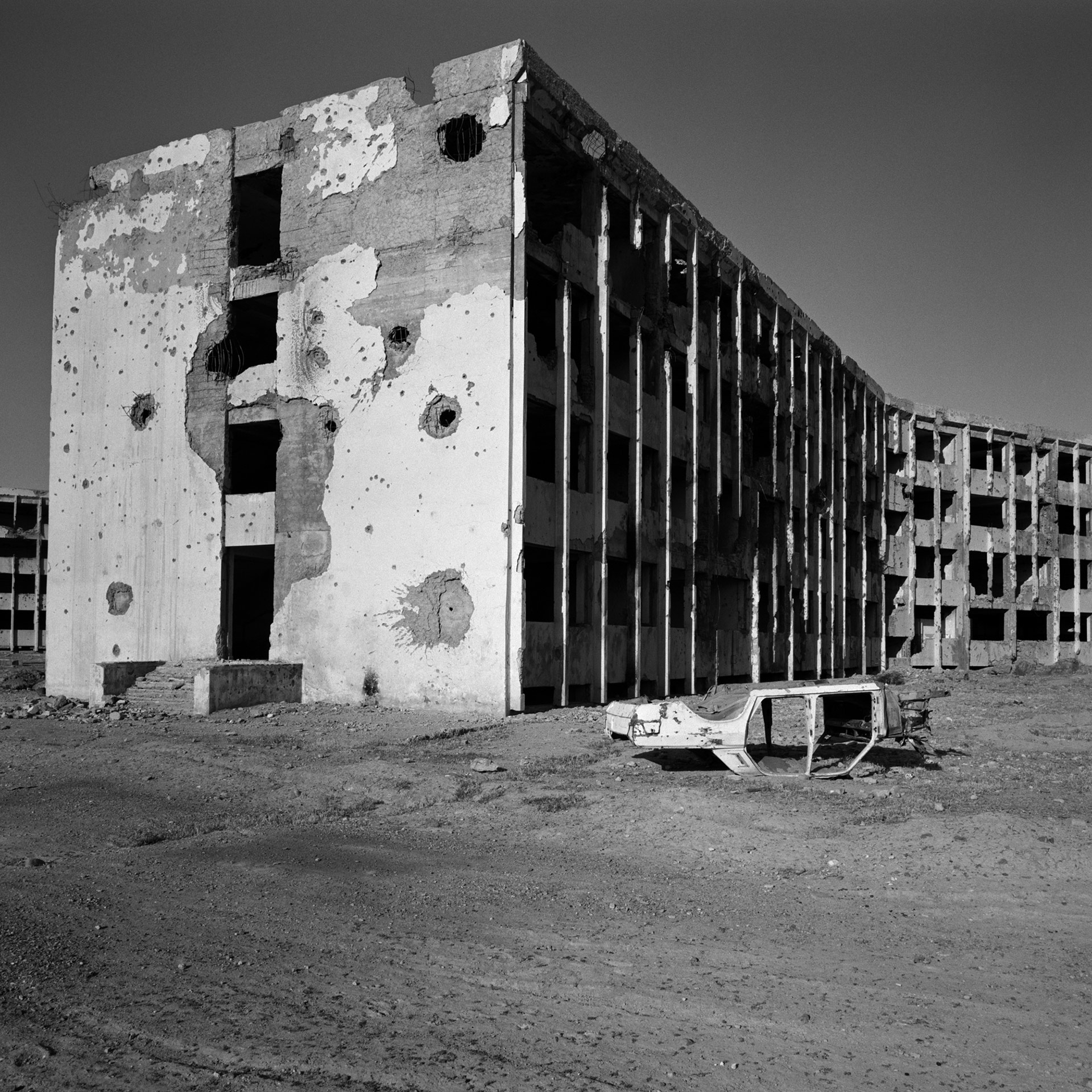
Ruins of a former government building on Darulaman Avenue. Kabul, Afghanistan. 21 June 1998.
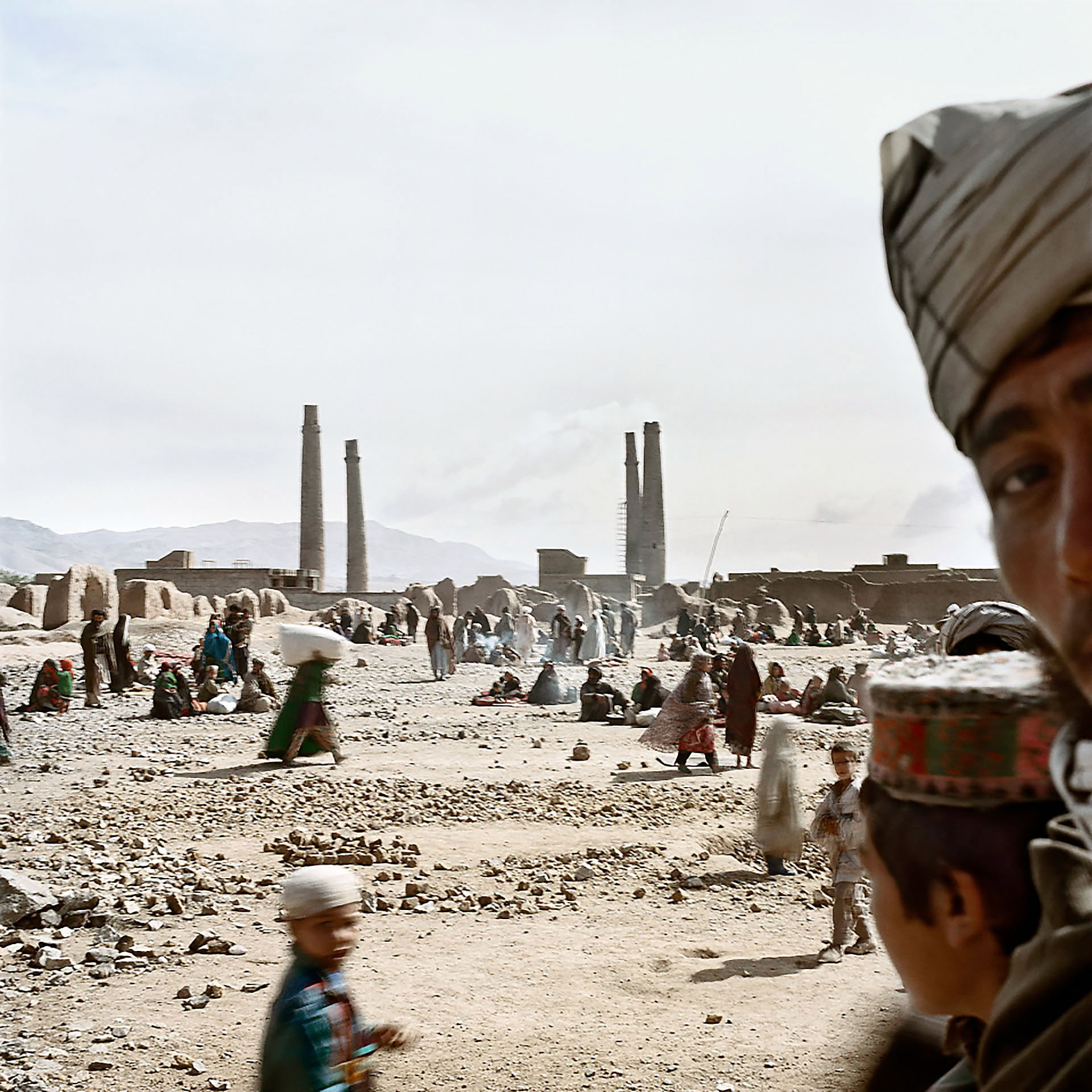
Groups of internally displaced persons from the drought-stricken north-western province of Badghis in a transit camp under the last four minarets of the Timurid-era musulla. The complex was built in 1417 under Queen Gowhar Shahd, wife of Tamerlane’s son, Shah Rukh. From here, the displaced will be brought to Maslak Camp in the desert to the west of the city. Herat, Afghanistan. 28 March 2001.
To facilitate a report on the worst drought in thirty years that had forced four million people to leave their homes, the Taliban leadership in Kandahar agreed that, contrary to its normal policy, I should be allowed to photograph those in distress.
The cumulative effect of three rainless years, the extreme cold of the previous winter, and the war in the north-east had made a humanitarian disaster inevitable. The Taliban leadership and World Food Program repeatedly asked the international community for help. But with its refusal to extradite Osama bin Laden, the Taliban regime effectively sealed the Emirate of Afghanistan’s isolation. One consequence of the UN sanctions against it was a ban on Ariana flights, which in turn impeded the transport of relief goods and desperately needed medical supplies. While the sanctions forbade members of the international community, the EU and ASEAN from providing any help at all, whether economic or military, the Northern Alliance, the Taliban’s opponent, continued to enjoy the support of Russia and Iran.
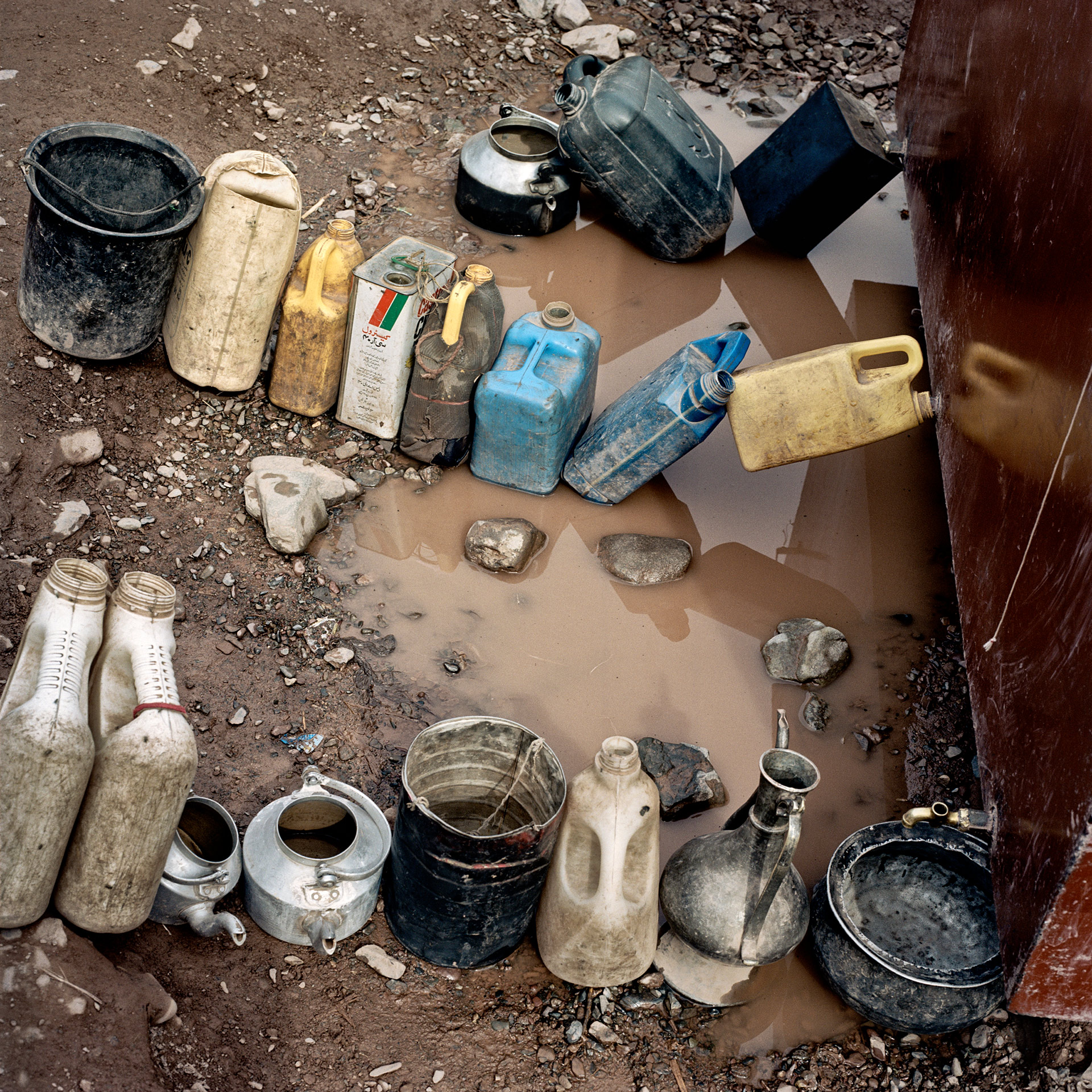
Children have lined up canisters and pots ready for the truck that will deliver water to a tank in the sprawling Jalozai Camp for Afghan refugees. Peshawar, Pakistan. 19 March 2001.
By the end of 2001 there were over four million Afghan refugees in Pakistan. The first wave had begun during the Soviet-Afghan War in the late 1970s; the second was triggered by the civil war which broke out in 1992. As of 2016 the UNHCR has repatriated over 4.3 million Afghans, most of them Pashtuns.
By 2017 insecurity and military operations had turned 2.61 million Afghans into refugees and internally displaced a further 1.84 million. (Neta C. Crawford, “Costs of War. Human Cost of the Post-9/11 Wars. Lethality and the Need for Transparency,” Nov. 2018, Watson Institute, Brown University. Source: UNHCR. Global Trends: Forced Displacement in 2017)
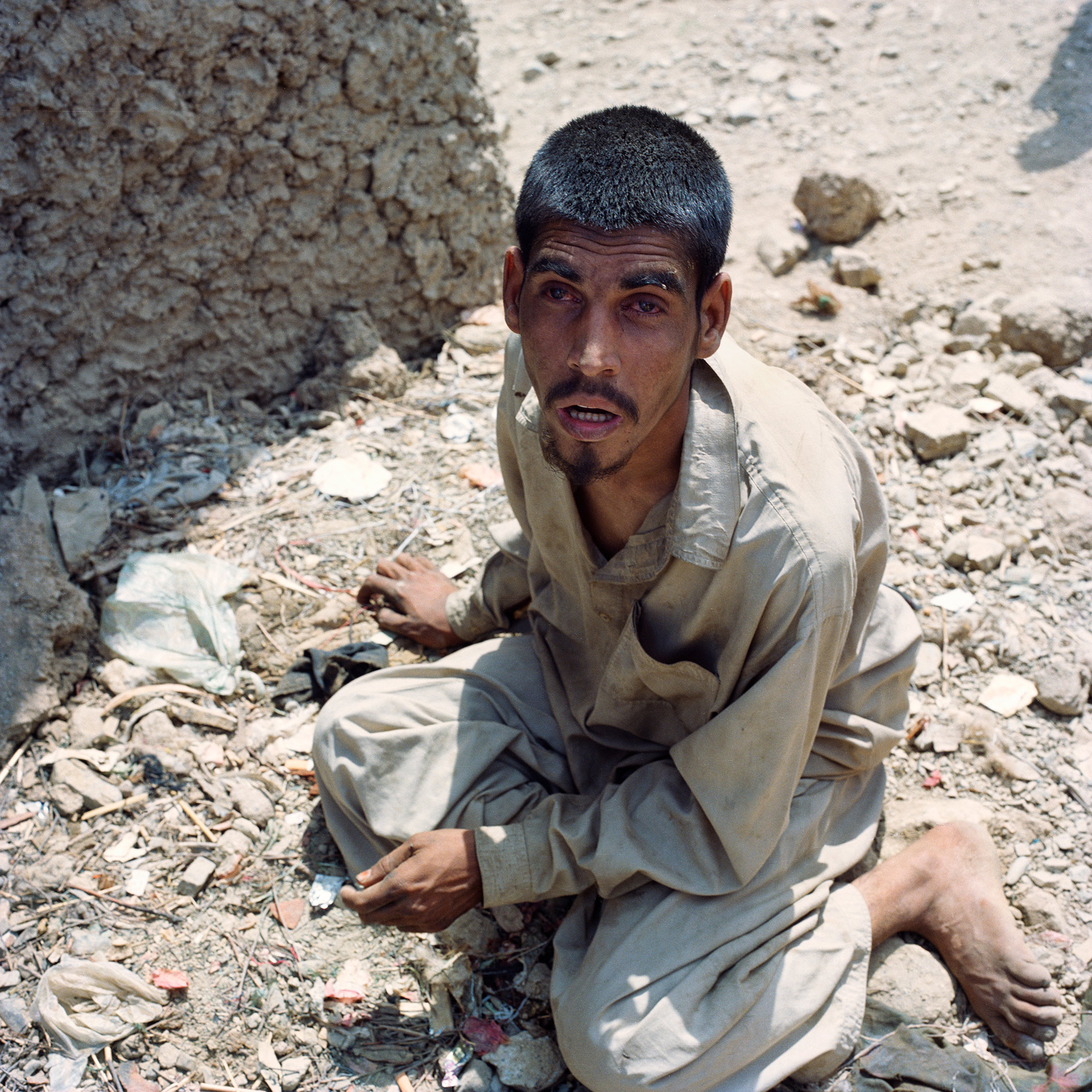
A mentally disabled man in the Jalozai Camp for Afghan refugees, Peshawar, Pakistan. 18 March 2001.
By the end of 2001 there were over four million Afghan refugees in Pakistan. The first wave had begun during the Soviet-Afghan War in the late 1970s; the second was triggered by the civil war which broke out in 1992. Since 2016 the UNHCR has repatriated over 4.3 million Afghans, most of them Pashtuns.
By 2017 insecurity and military operations had turned 2.61 million Afghans into refugees and internally displaced a further 1.84 million. (Neta C. Crawford, “Costs of War. Human Cost of the Post-9/11 Wars. Lethality and the Need for Transparency,” Nov. 2018, Watson Institute, Brown University. Source: UNHCR. Global Trends: Forced Displacement in 2017)
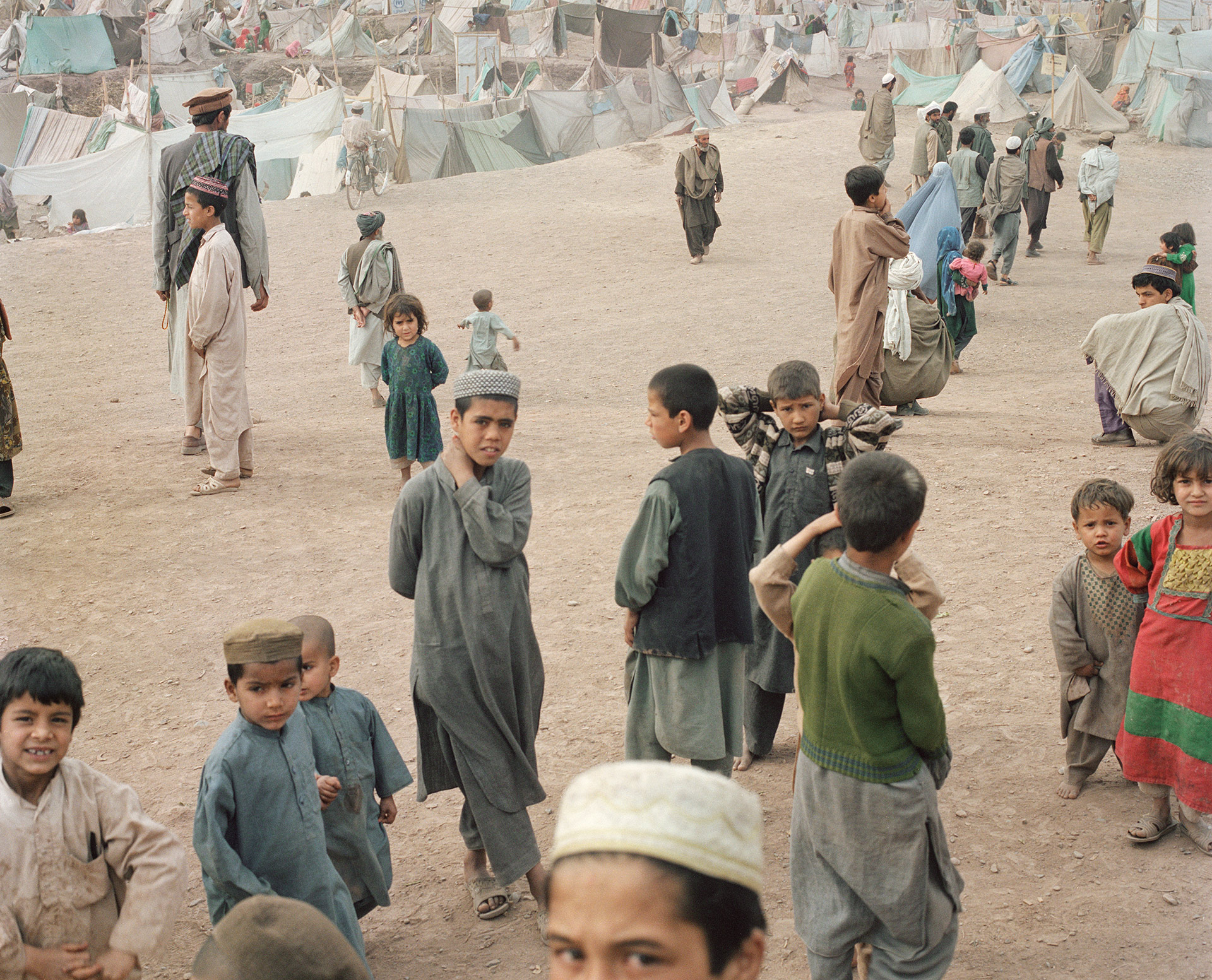
Residents of Jalozai Camp for Afghan refugees, Peshawar, Pakistan. 19 March 2001.
By the end of 2001 there were over four million Afghan refugees in Pakistan. The first wave had begun during the Soviet-Afghan War in the late 1970s; the second was triggered by the civil war which broke out in 1992. Since 2016 the UNHCR has repatriated over 4.3 million Afghans, most of them Pashtuns.
By 2017 insecurity and military operations had turned 2.61 million Afghans into refugees and internally displaced a further 1.84 million. (Neta C. Crawford, “Costs of War. Human Cost of the Post-9/11 Wars. Lethality and the Need for Transparency,” Nov. 2018, Watson Institute, Brown University. Source: UNHCR. Global Trends: Forced Displacement in 2017)
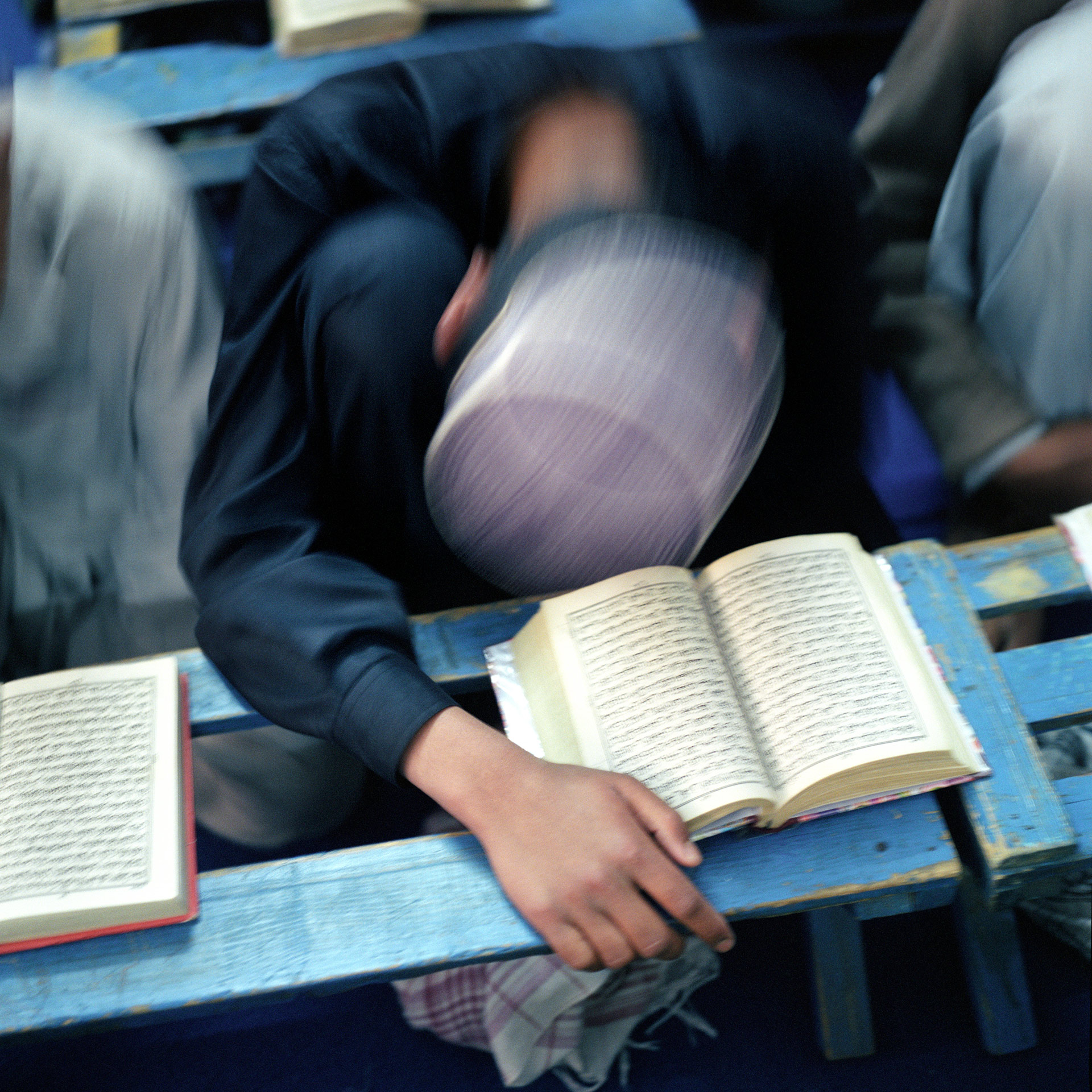
A student or talib memorizes the Quran during a class at the Jamia Dar ul-Ulum Haqqania madrassa. Akhora Khatak, NWFP, Pakistan. 18 March 2001.
A madrassa is an Islamic theology school. This particular madrassa has sometimes been called the “Oxford of Jihad” because many Taliban leaders studied here. Students at the time were recruited from the Afghan refugee camps around Peshawar, but also from abroad.
The Haqqania was founded in 1947 by Maulana Abdul Haq, father of Samiul Haq, head of the madrassa at the time (he died in 2018). It offered an eight-year Master of Arts in Islamic Studies and a PhD after an additional two years of study. Funded by public donations, the madrassa is free.
Students spent their vacations in Taliban training camps and on the frontline in Afghanistan. But a martyr’s death might also be found on the Kashmir front.
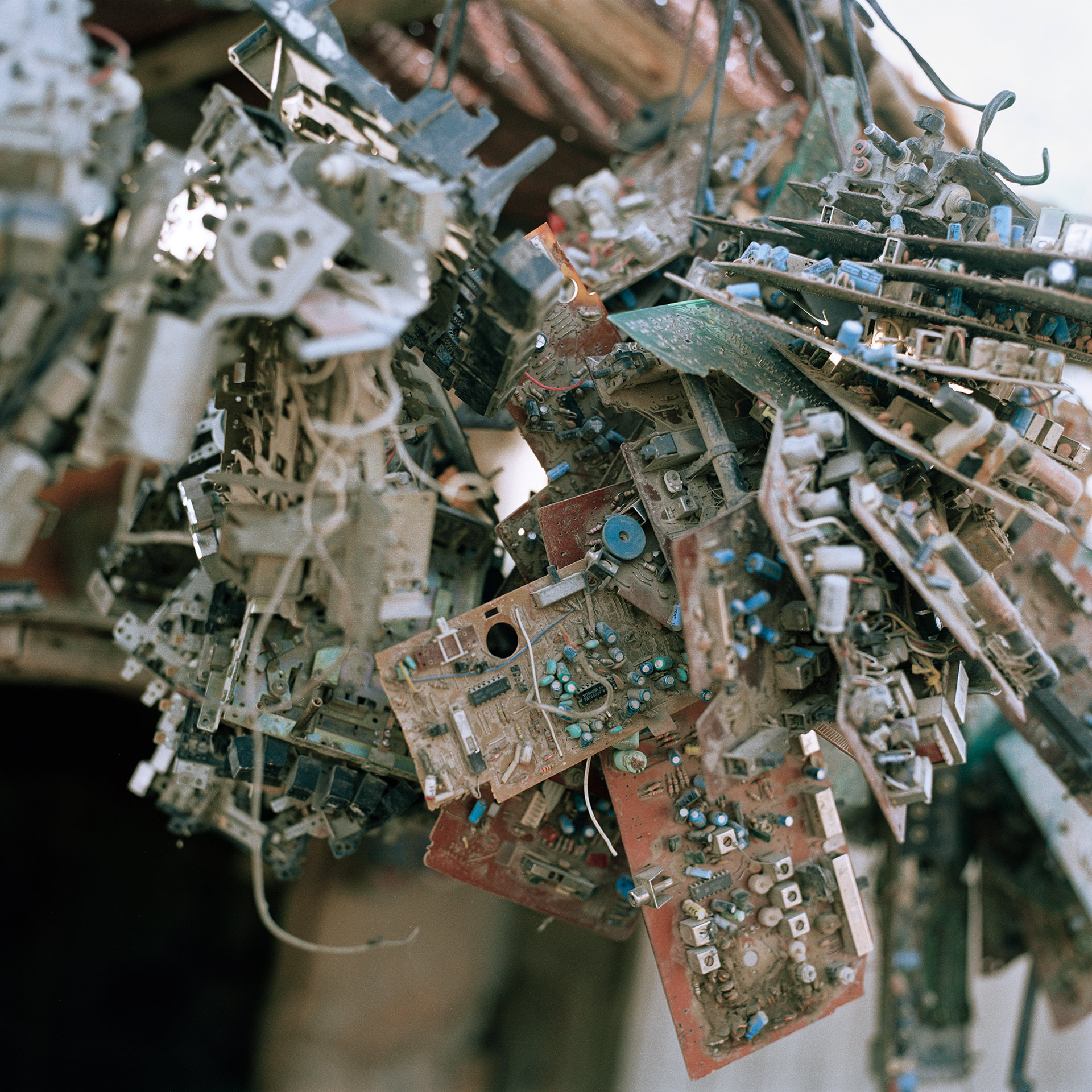
TV motherboards for sale at the junk bazaar. Mazar-e-Sharif, Afghanistan. 15 October 2002.
When they came to power in September 1996 the Taliban banned all forms of entertainment and subsequently bulldozed cinemas and destroyed any TV sets they could find.
During my journeys in Taliban Afghanistan I was often told that Mullah Omar had warned Afghans that they would disappear into an abyss like the Titanic if they did not comply with the entertainment ban.
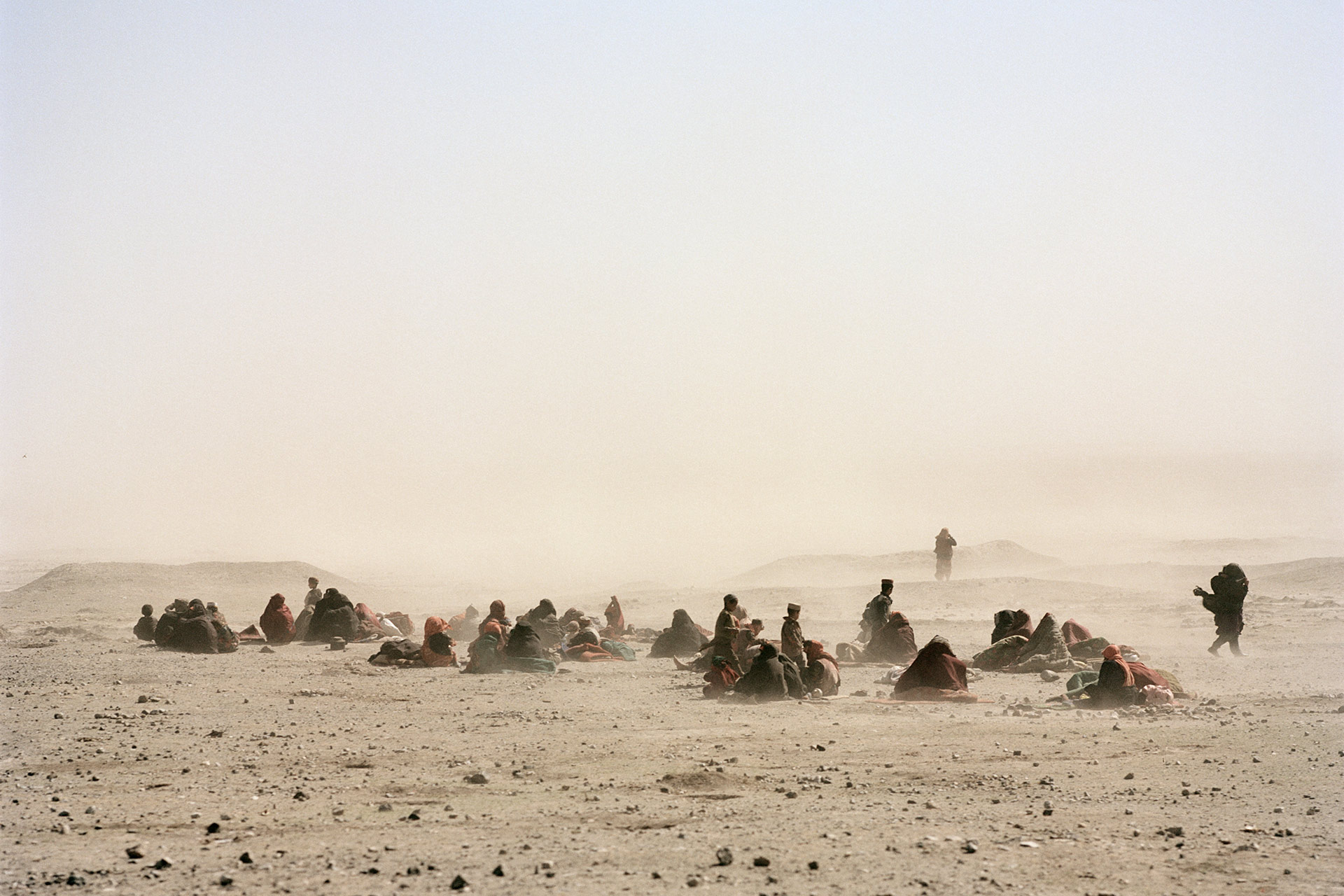
A group of internally displaced persons who, having spent their last resources fleeing the drought in Badghis Province in the north-west and travelling to Herat, wait in the desert to be allowed into the ICRC-run Maslak Camp. Herat, Afghanistan. 2 April 2001.
To facilitate a report on the drought that had affected the entire north-west of the country, the Taliban leadership in Kandahar agreed that, contrary to its normal policy, I should be allowed to photograph those in distress.
When Afghanistan endured its worst drought in thirty years, four million people were forced to leave their homes. The cumulative effect of three rainless years, the extreme cold of the previous winter, and the war in the north-east had made a humanitarian disaster inevitable. The Taliban leadership and World Food Program repeatedly asked the international community for help. But with its refusal to extradite Osama bin Laden, the Taliban regime effectively sealed the Emirate of Afghanistan’s isolation. One consequence of the UN sanctions against it was a ban on Ariana flights, which in turn impeded the transport of relief goods and desperately needed medical supplies. While the sanctions forbade members of the international community, the EU and ASEAN from providing any help at all, economic or military, the Northern Alliance, the Taliban’s opponent, continued to enjoy the support of Russia and Iran.
The overland journey through what became the world’s top outlaw state, so impoverished that it no longer even features in UN statistics, led from Kandahar to camps in Herat, across the Sabzak Pass into Badghis Province, deep into Murghab Canyon and to encounters with those who, having lost livestock and seeds, were stranded in caves without hope of escape. There they subsisted on what would normally be camel fodder.
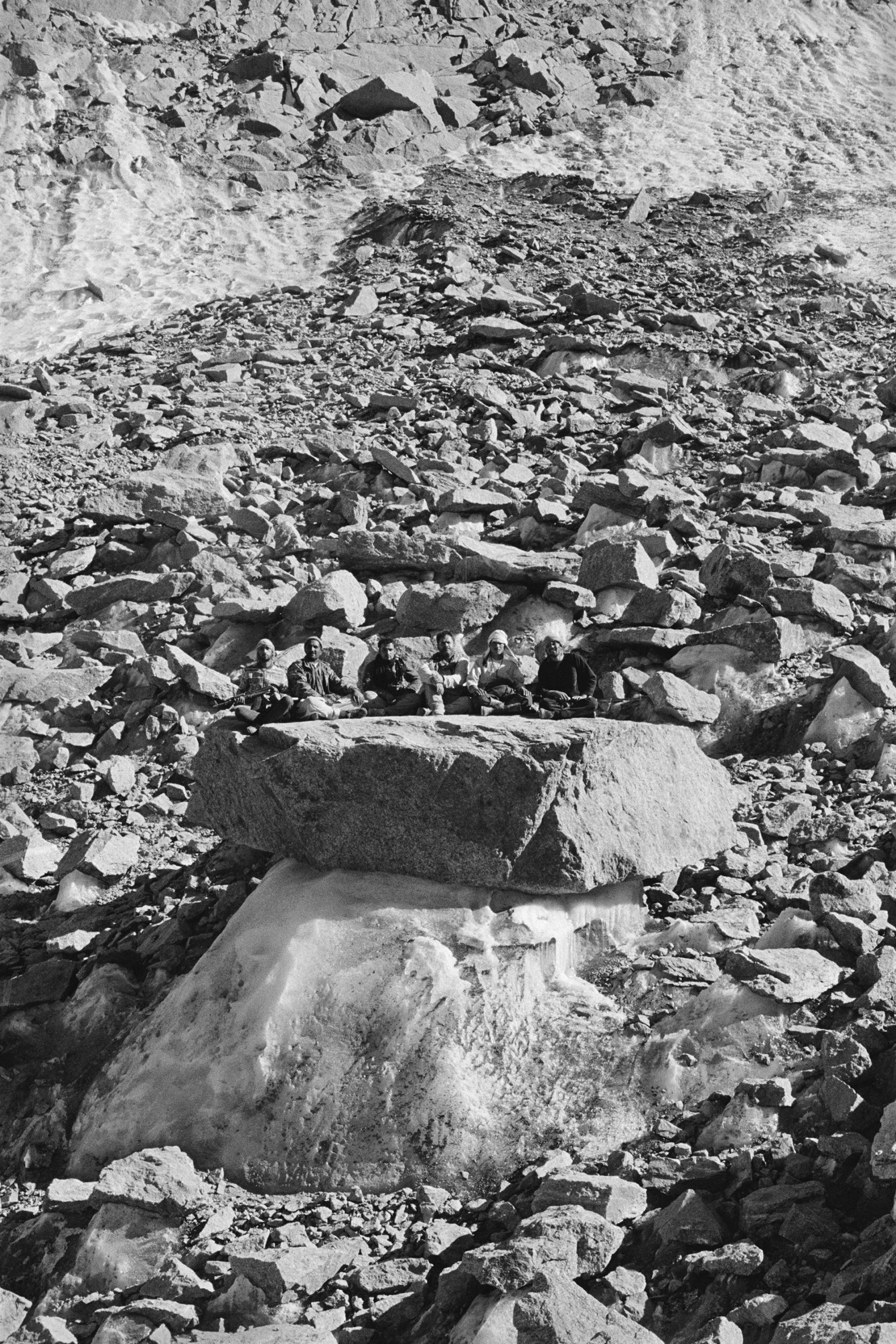
Members of Tajik local and national security forces resting on a colossal glacier table in the ablation zone of Southwest Glacier 2. Mir Samir, Panjshir, Afghanistan. 12 September 2018.
This photograph of a site representing glacier melt as a consequence of global warming foreshadows the prospect of further war over a finite resource—water.
In itself the photograph is a metaphor, too. Potential economic and industrial development will increase water demand. The impending worst-case scenario envisions displacement and migration to densely populated agricultural areas that are already being intensively farmed—potentially sparking conflict over water as an already scarce commodity.
A glacier table is a boulder perched on a pedestal of ice. The boulder protects the ice from ablation (melting) during sunny weather. Around the boulder the ice ablates so that its surface is lowered, whereas the boulder itself remains at the original level. While the pedestal becomes higher and higher in relation to the surface of the glacier, the sun shines further under the boulder from the south (in the northern hemisphere). The greater ablation on the southern side will eventually cause the boulder to fall off the pedestal. After this, a new cycle of table growth and destruction may begin.
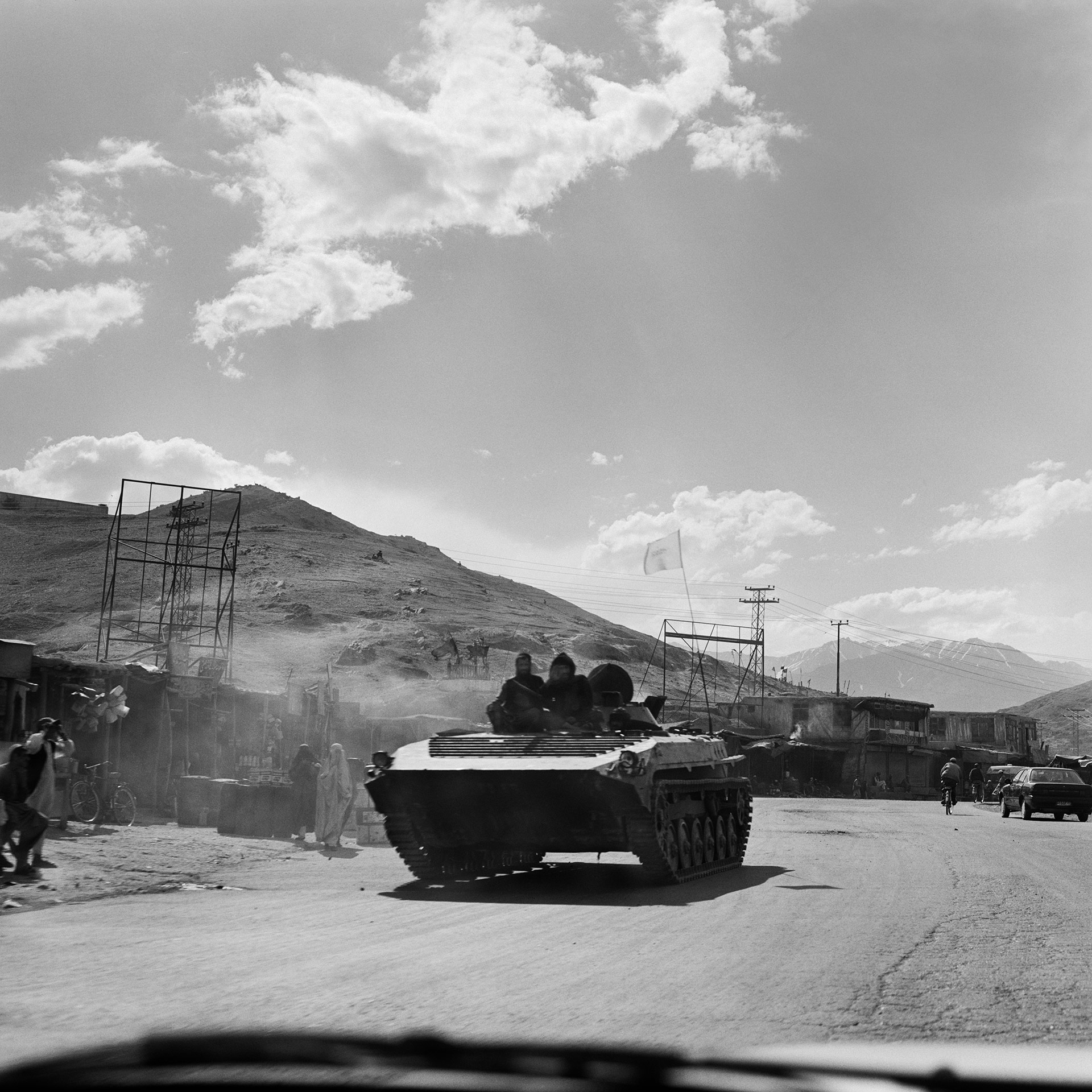
Taliban returning from the frontline in the Shomali Plain. Kabul, Afghanistan. 18 June 1998.
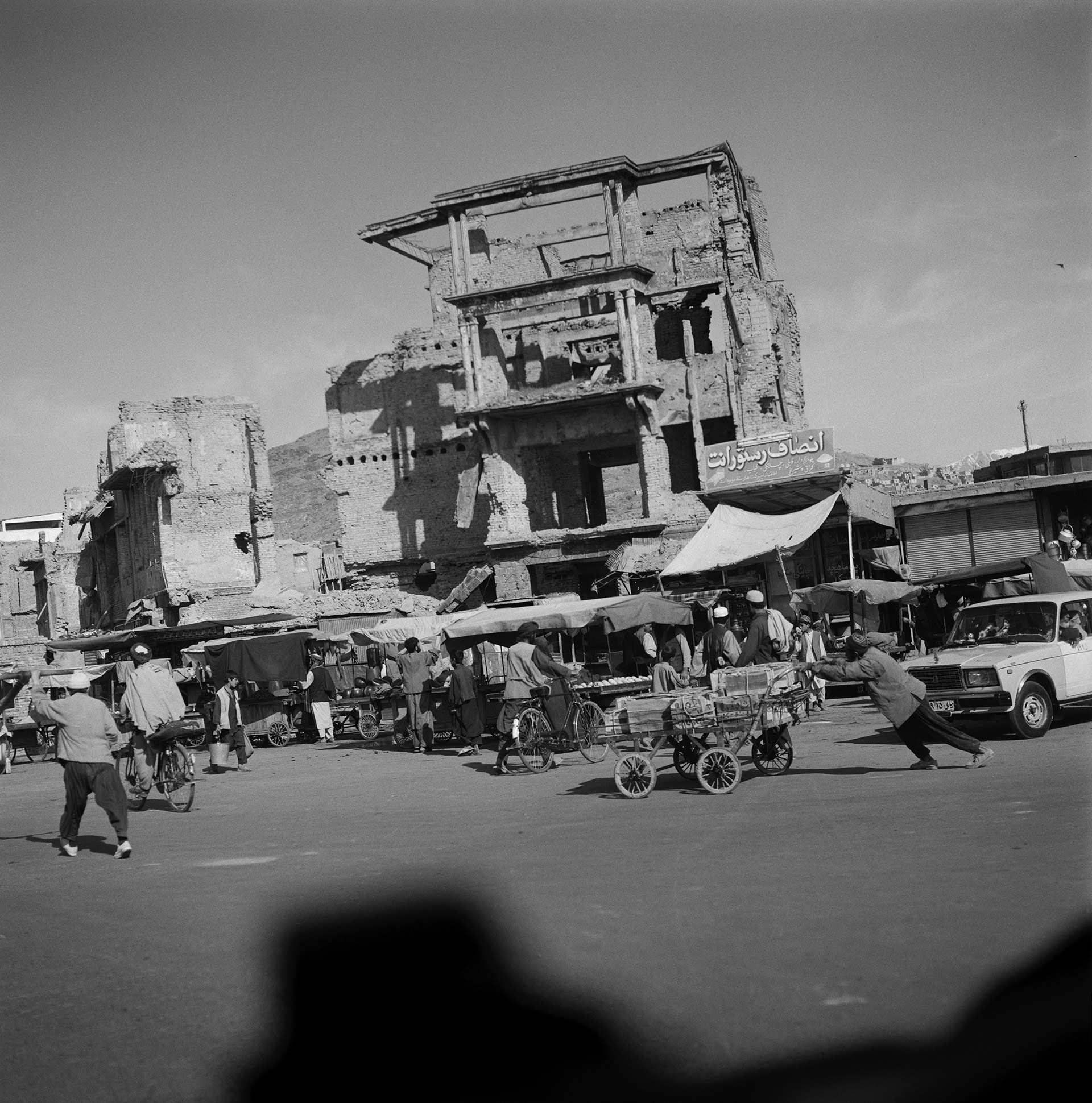
Entry into the capital city. 17 June 1998.
After a night spent under Taliban protection in a Sorubi chai khana and a memorable drive through the Sorubi Gorge, this was one of the first photographs I took as we entered Afghanistan’s war-torn capital early in the morning.
A paper in my passport said “No photographs of people and living creatures.” That included birds in the sky.
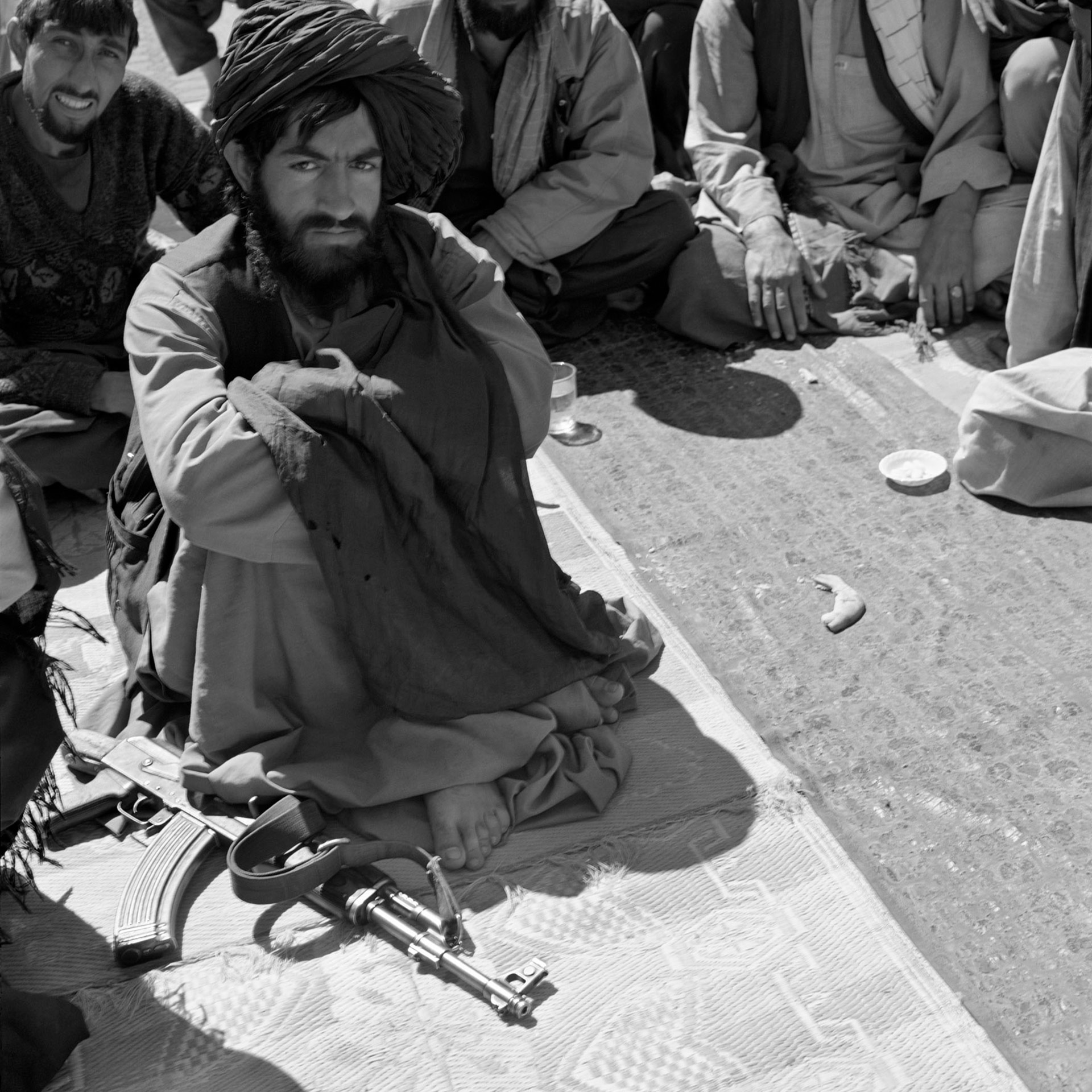
Having tea with a Talib in a chai khana beyond Sabzak Pass en route to Qala-e-Now. Badghis Province, Afghanistan, 29 March 2001.
To facilitate a report on the drought that had affected the entire north-west of the country, the Taliban leadership in Kandahar agreed that, contrary to its normal policy, I should be allowed to photograph people, i.e. those in distress.
In a contested area beyond the Sabzak Pass where Dostum’s Uzbek forces had been plundering what few resources the starving people still had, the Taliban offered some kind of protection. At the entrance to Murghab Canyon the Taliban lent us one of the wheels of their Hilux SUV. With two flat tires we would not have been able to make our way deep into the canyon to meet the people marooned there and now fighting for their lives.
When Afghanistan endured its worst drought in thirty years, four million people were forced to leave their homes. The cumulative effect of three rainless years, the extreme cold of the previous winter, and the war in the north-east had made a humanitarian disaster inevitable. The Taliban leadership and World Food Program repeatedly asked the international community for help. But with its refusal to extradite Osama bin Laden, the Taliban regime effectively sealed the Emirate of Afghanistan’s isolation. One consequence of the UN sanctions against it was a ban on Ariana flights, which in turn impeded the transport of relief goods and desperately needed medical supplies. While the sanctions forbade members of the international community, the EU and ASEAN from providing any help at all, economic or military, the Northern Alliance, the Taliban’s opponent, continued to enjoy the support of Russia and Iran.
This overland journey through what became the world’s top outlaw state, so impoverished that it no longer even features in UN statistics, led from Kandahar to camps in Herat, across the Sabzak Pass into Badghis Province, deep into Murghab Canyon and to encounters with those who, having lost livestock and seeds, were now stranded in caves without hope of escape. There they subsisted on what would normally be camel fodder.
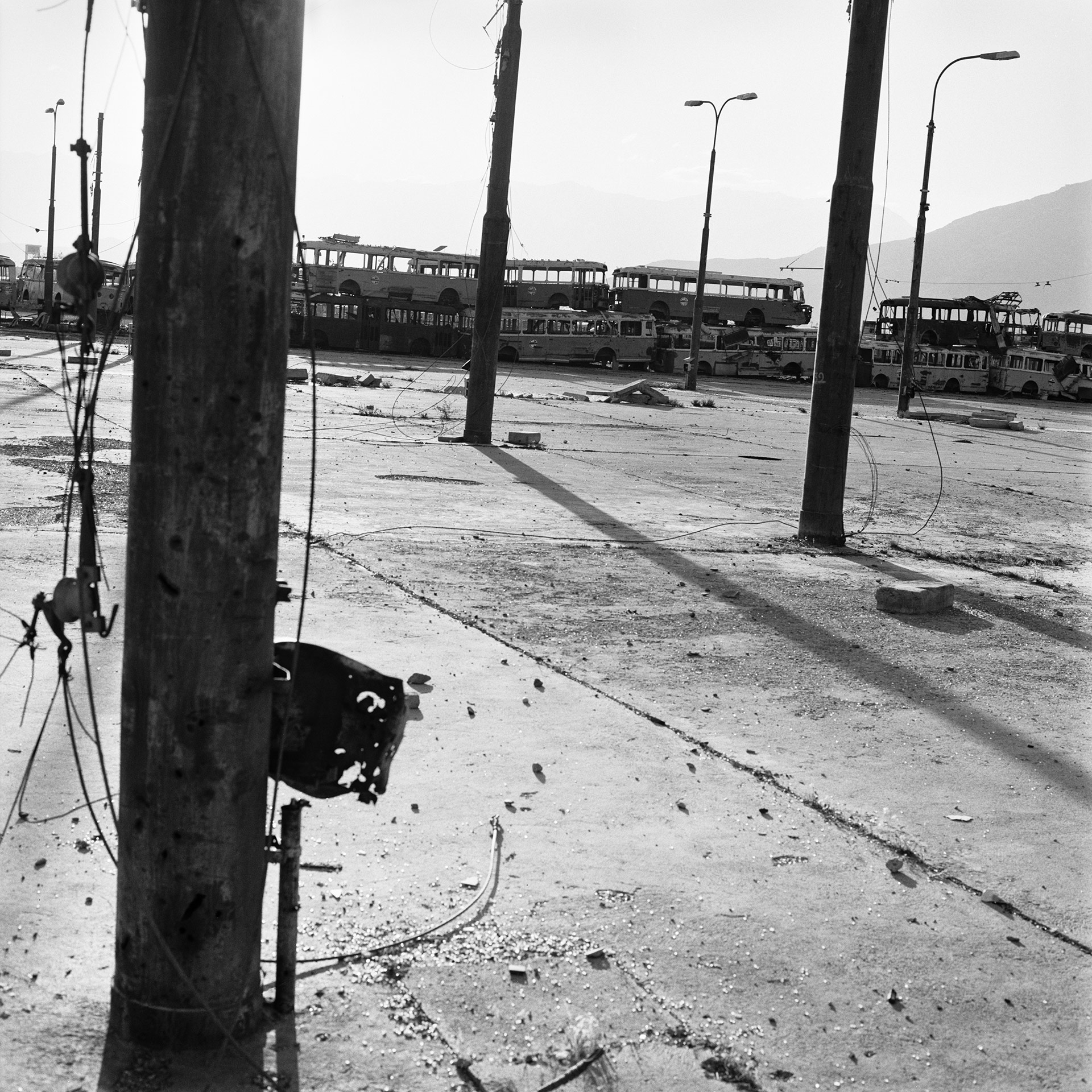
Kabul, Afghanistan, 20 June 1998.
By February 1993 Afghanistan’s capital had become a battlefield between five rival political factions. The trolley terminal was one of the frontlines.
In September 1996 a Taliban force of 30,000 approached Kabul from Jalalabad and via Sorubi. Dostum thereupon pulled his Uzbek troops back to reinforce his control of the north-west, leaving Masud’s Tajik forces to face the Taliban alone. Rather than getting trapped, Masud withdrew to defend the Panjshir. Thus the Taliban, which enjoyed Pakistan’s support (weaponry, aircraft, fuel, funds and intelligence), met little resistance when it entered Kabul on 26 September.
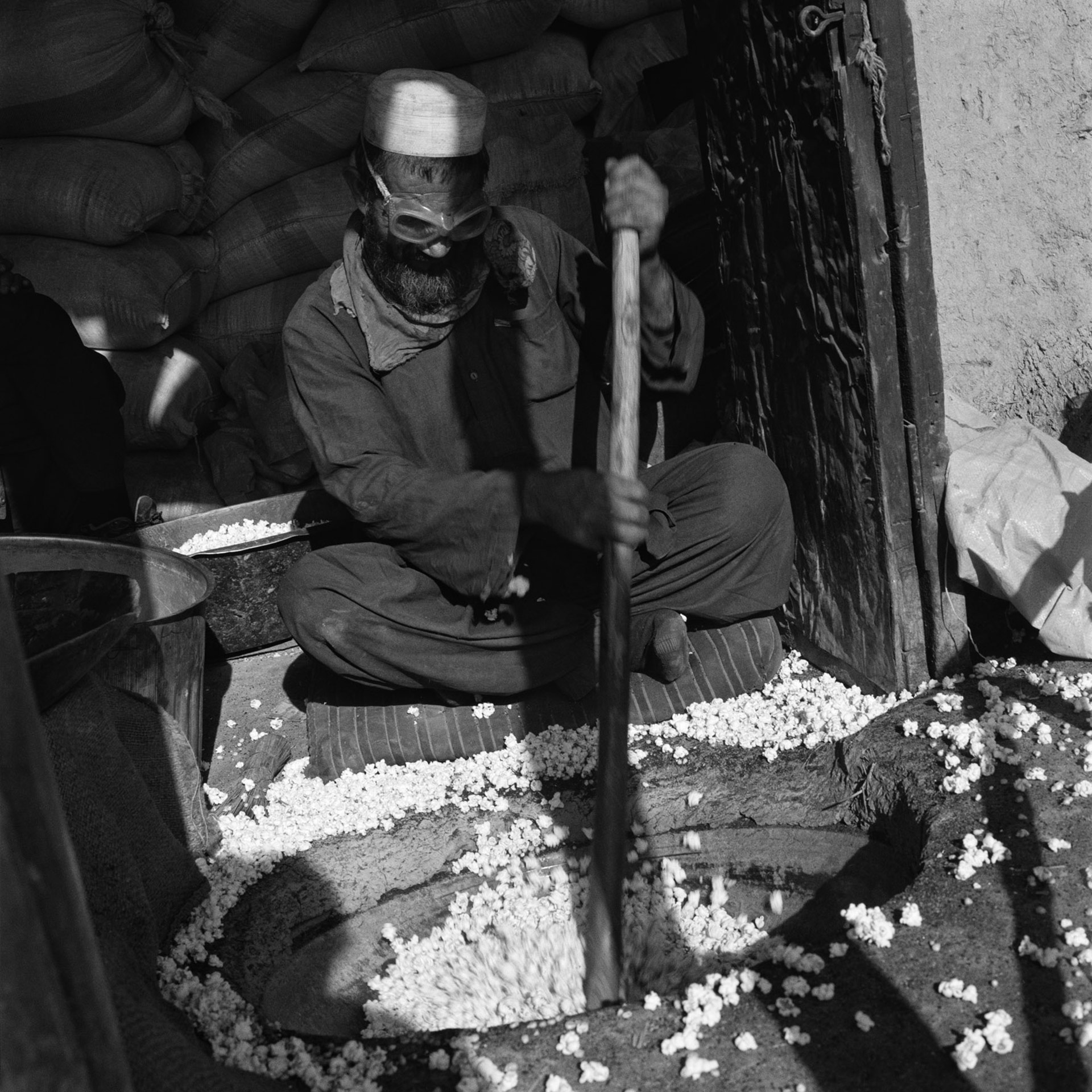
A man prepares popcorn in the Old Town of Murad Khane. Kabul, Afghanistan. 25 December 2009.
I always saw this photograph as a double metaphor: first of the Afghans’ great ability to appropriate foreign things, and, second, of the agitation this small, landlocked country stirs up in the great powers’ faraway capitals.
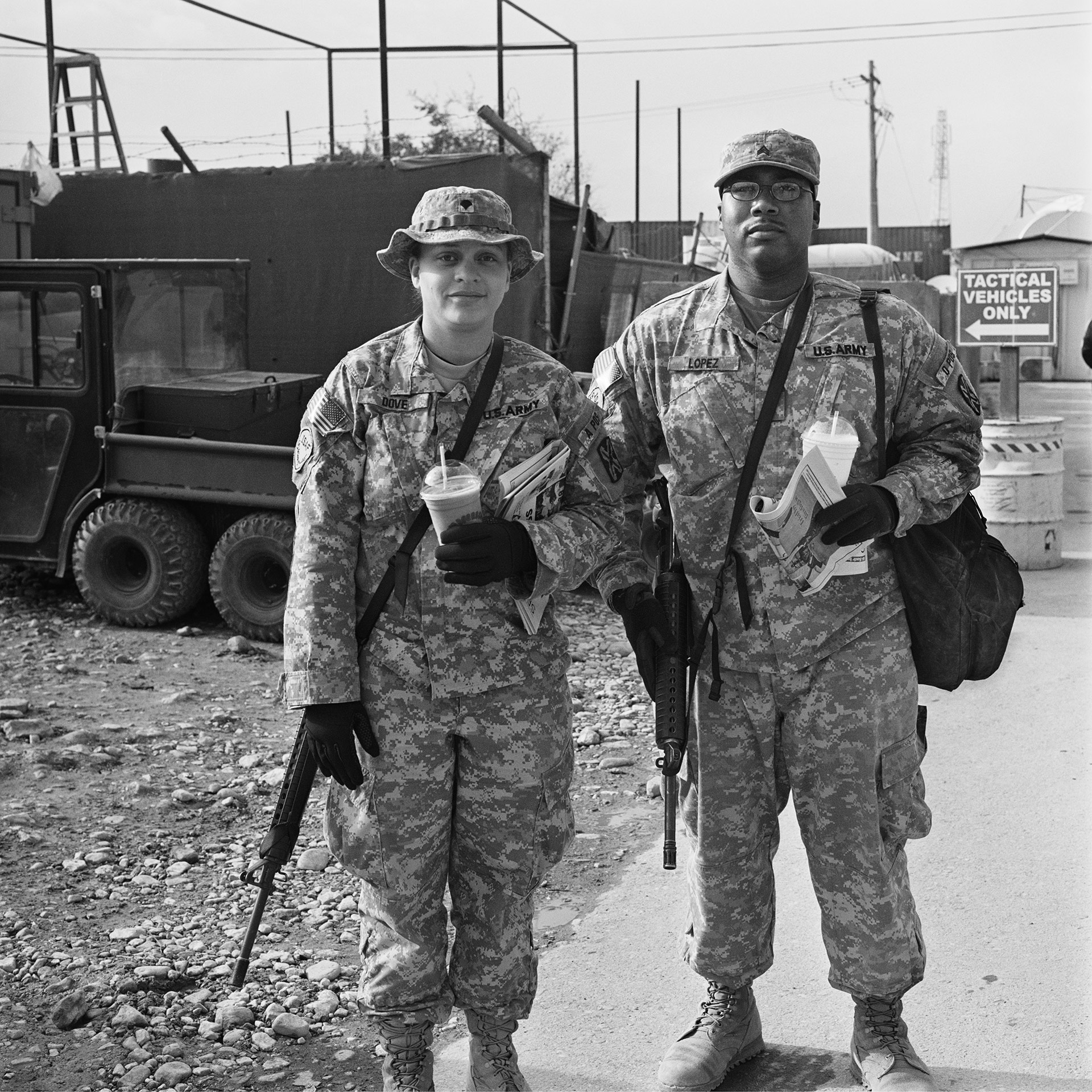
A photograph taken shortly before my arrest for having looked through the lens of my Hasselblad, but not actually photographing, some containers near the airbase runway. Bagram, Afghanistan. 30 November 2006.
To my amazement, neither the generals nor the officers working at the base knew of Alexander the Great, who had camped in this area in February 329 BCE before crossing the Hindu Kush in pursuit of Bessus, who was complicit in the assassination of the Persian King Darius III. From Alexander’s camp sprang the city Alexandria ad Caucasum, probably today’s Charikar or Bagram. The present day rulers of Bagram were equally unaware of the Arabs’ conquest of the place in 698 (78/79 after Hijrah).
Built by the Americans during the Cold War in the 1950s, Bagram served as a staging point for the Soviet forces in the early days of the invasion. At 1900 hours on 26 December 1979 an airborne regiment landed on the airfield and together with other forces and advisers already in the country seized all the key military and political installations in the capital and the surrounding area.
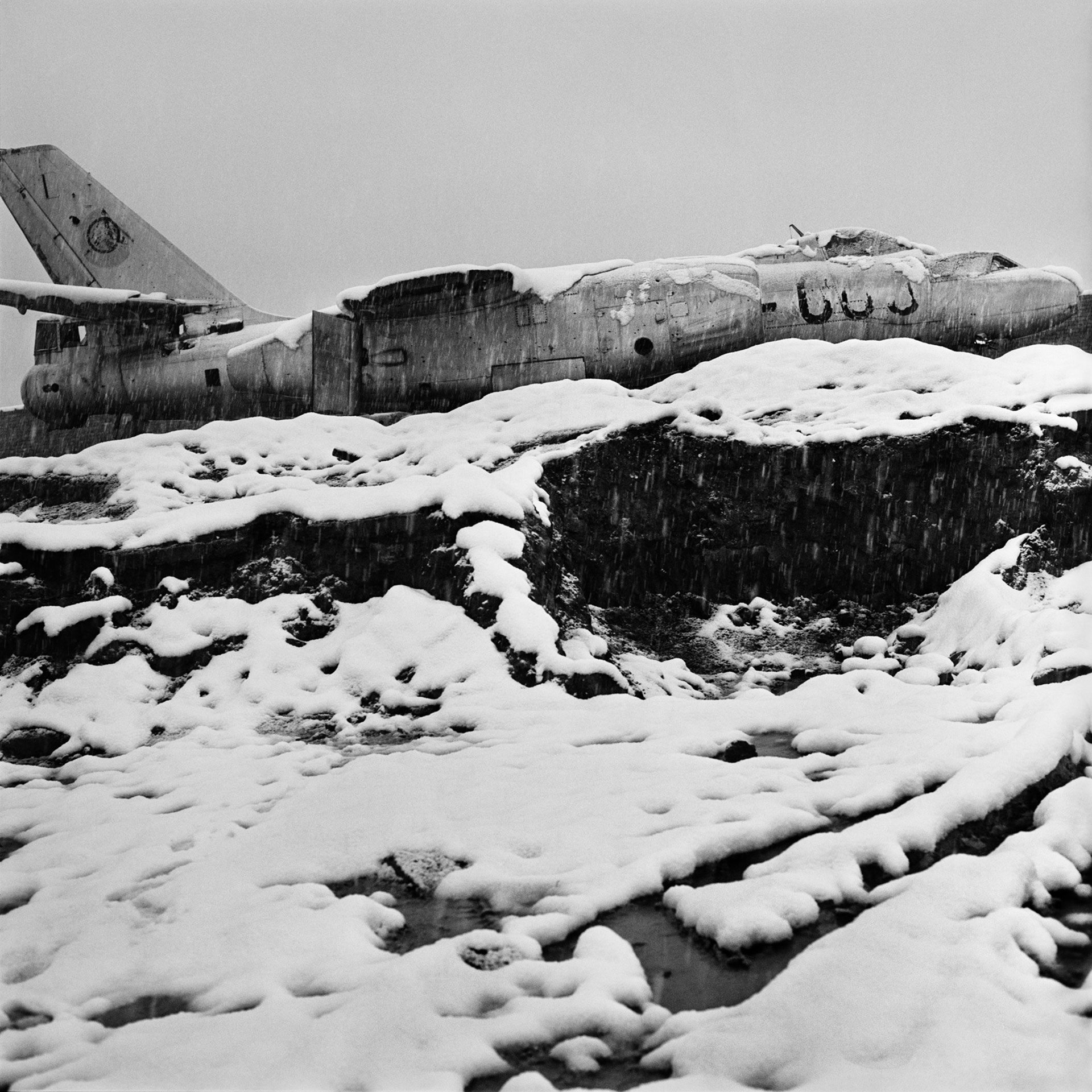
Relics of the Soviet occupation (1979–1989), Kabul, Afghanistan. 4 December 2006.
In December of this year it will be forty years since the Soviet Army invaded Afghanistan. The country has been torn apart by foreign political and military meddling as well as internal strife ever since.
The Taliban, a nationalist and traditionalist organization with no global Jihad ambitions and weary of Al Qaeda ideology, has now entered the peace process that is to lead to “direct talks between the organization and Afghan stakeholders, i.e. government, political parties, civil society, women, youth and representatives of the victims of the conflict” (New York Times, 23–24 February, 2019). It therefore sees the emergence of the “Islamic State in Khorasan Province” as a threat. The I.S.K.P. (a local franchise of Islamic State a.k.a. I.S.I.S-K) propagates a caliphate stretching from Iran across northern Afghanistan to the former Soviet Republics of Central Asia and beyond to Pakistan and India.
Afghanistan’s government meanwhile controls only about 55 percent of all administrative districts, where about 65 percent of the entire population lives.
After two decades of terrorist attacks by both foreign and domestic perpetrators, America might wish to acknowledge “that foreign war is no vaccine against global terrorism” and “that terrorism is a tactic, not an enemy force that can be defeated, and it knows no borders” (New York Times, 6 February, 2019).
America’s longest war has so far cost the country one trillion dollars. And still it grinds on. Most direct civilian war deaths in Afghanistan (as well as in Pakistan, Iraq, Syria and Yemen) have been caused by militants. But the U.S. and its coalition partners have also killed civilians. In July 2016 the Presidential Executive Order on Measures to Address Civilian Casualties stated: “The protection of civilians is fundamentally consistent with the effective, efficient, and decisive use of force in pursuit of U.S. national interest. Minimizing civilian casualties can further mission objectives, help maintain the support of partner governments and vulnerable populations, especially in the conduct of counterterrorism and counterinsurgency operations; and enhance the legitimacy and sustainability of U.S. operations critical to our national security.”
According to the UN Assistance Mission in Afghanistan released on 30 July 2019, the first half of the year saw a total of 717 Afghan civilians killed during Afghan and NATO operations against insurgents, such as air strikes and night raids on militant hideouts, which are often situated in civilian areas. That is a higher death toll than that caused by the Taliban and other militants. The U.S. commitment to reducing civilian casualties in its post-9/11 wars may be slipping. In Afghanistan especially, the U.S. and its allies were able for a while to reduce the number of civilians killed in airstrikes, whereas the past few years have seen a rise in the civilian death toll from airstrikes by “pro-government forces” (i.e. the U.S.-led coalition and Afghan military).
“According to [the transparency project] Airwars, in ‘Operation Inherent Resolve’ (the operational name for the American military intervention against the Islamic State in Iraq and Syria), the Coalition has killed at least 6,575 civilians since August 2014 (when the U.S. joined the war) in air strikes and the Russians may have killed between 12,000 and 19,000 civilians in the war in Syria.” (Neta C. Crawford, “Costs of War. Human Cost of the Post 9/11 Wars. Lethality and the Need for Transparency,” Nov. 2018, Watson Institute, Brown University).
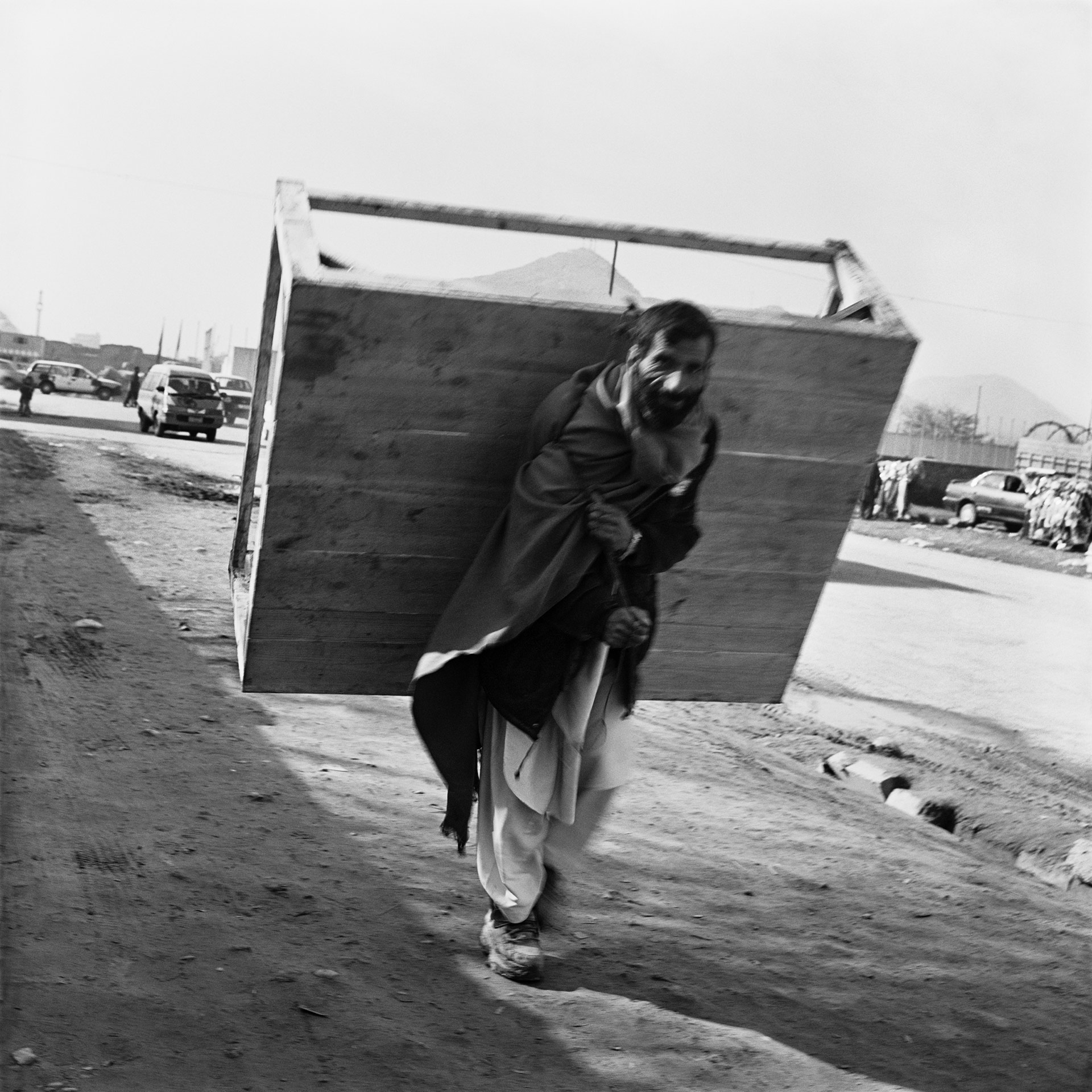
A bazaari on his way home. Kabul, Afghanistan. 1 December 2006.
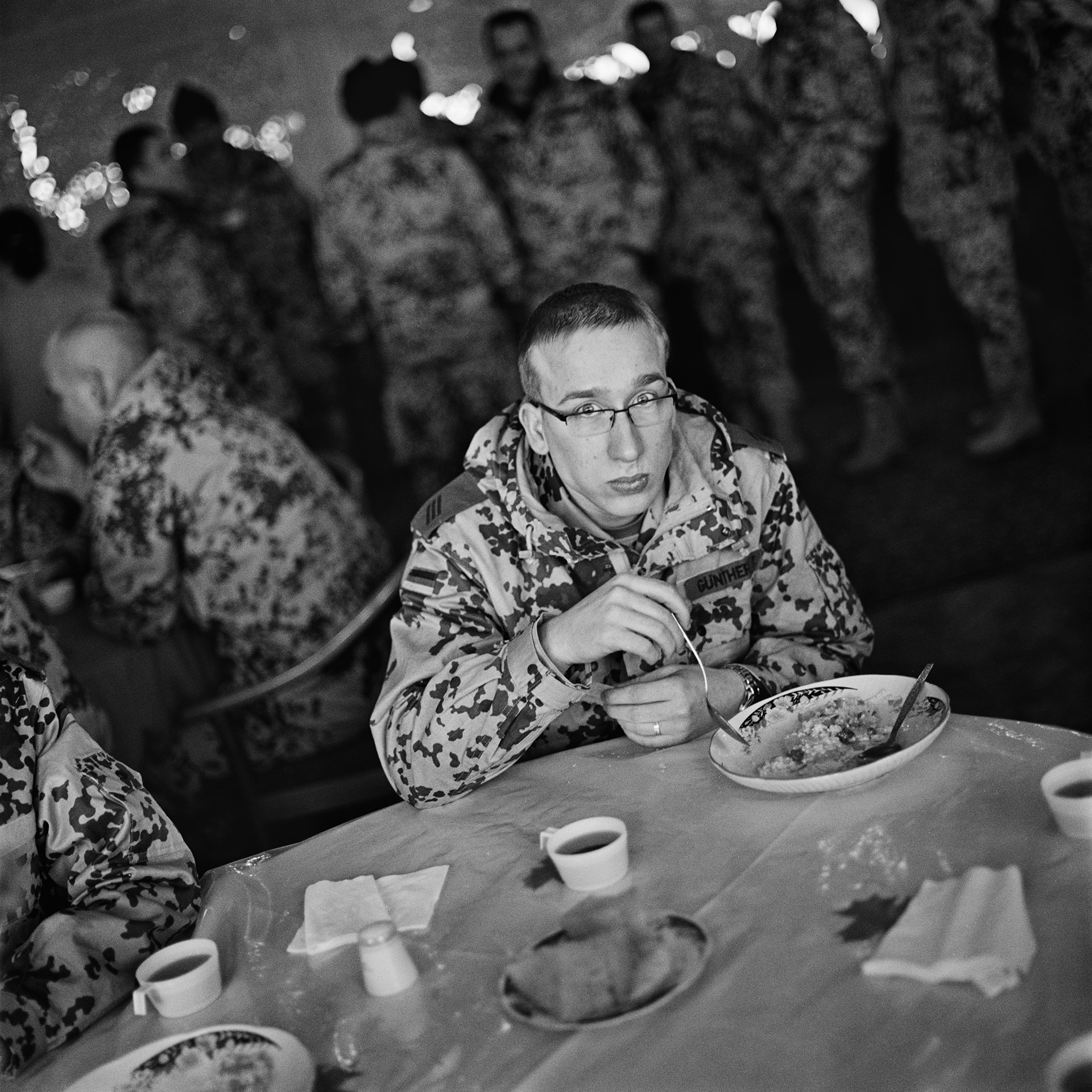
A soldier in the German Bundeswehr reluctantly scoops a portion of palov, the Uzbek national dish made with rice, pieces of lamb, grated carrots and onions. Urgench, Uzbekistan. 25 November 2006.
The Bundeswehr ferry flight to Termez had been diverted to Urgench because of fog. Fog was a frequent occurrence at the hub from which many ISAF forces were deployed to Afghanistan. This made it a poor escape route.
The last Soviet combat troops had withdrawn across the Friendship Bridge spanning the Amu Darya east of Termez on 15 February 1989.
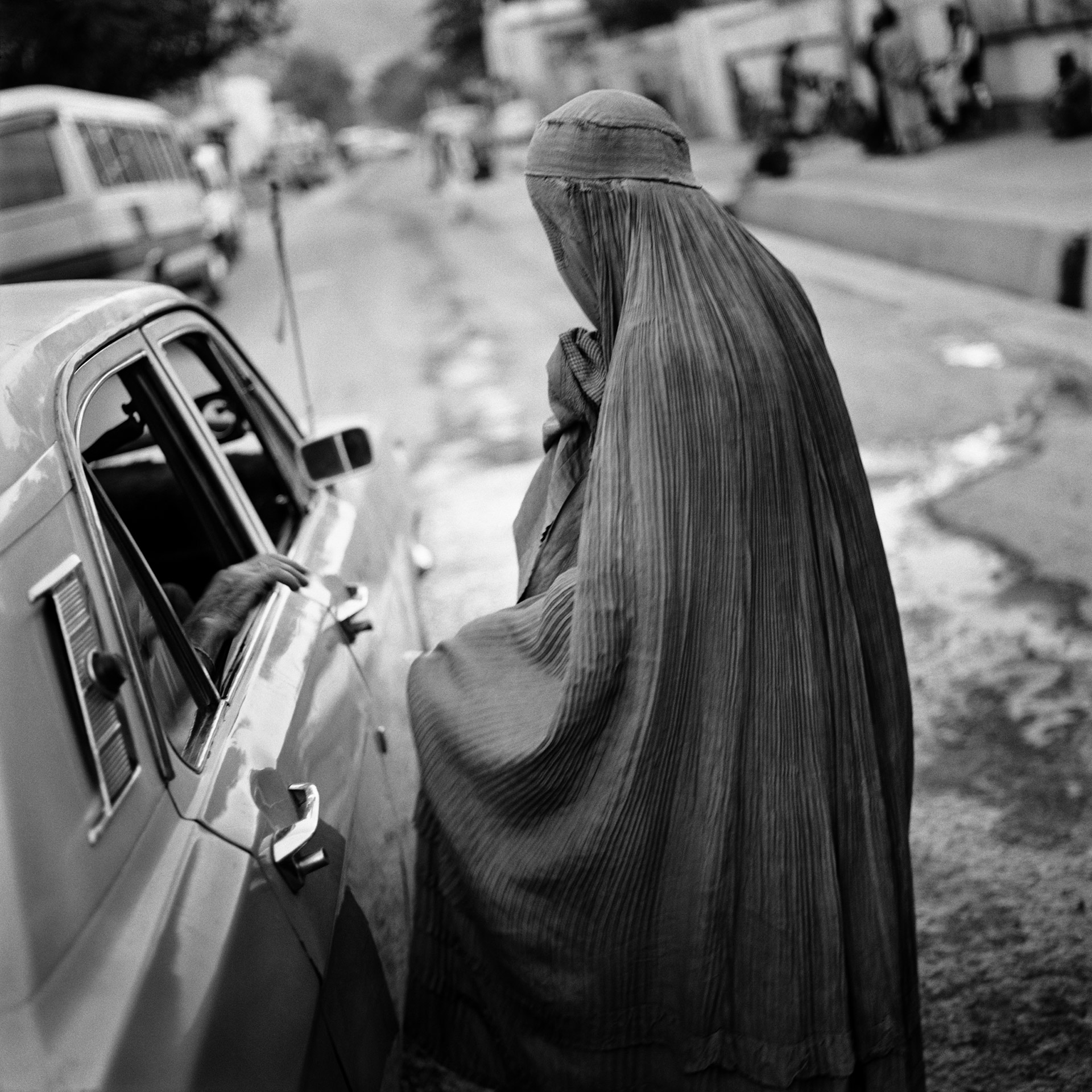
Of all the photographs forbidden by the Taliban this was the most forbidden. Within 24 hours of the fall of Kabul in September 1996, Mullah Omar had issued a fatwa which banned women from work.
Like legions of Afghan women, most teachers, office workers, doctors and nurses were war widows for whom begging was henceforth the only survival option.
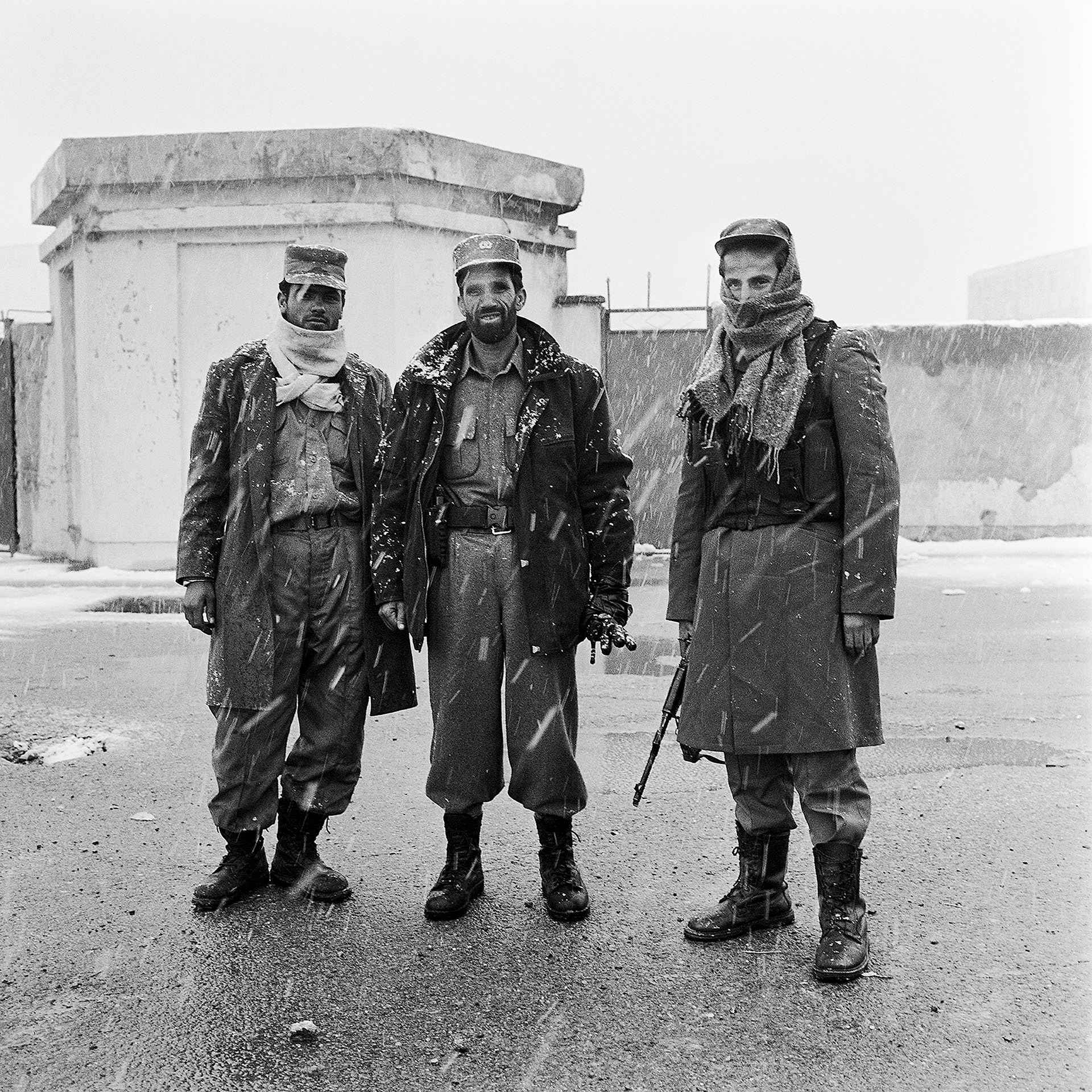
Security Forces on Darulaman Avenue. Kabul, Afghanistan. 2 December 2006.
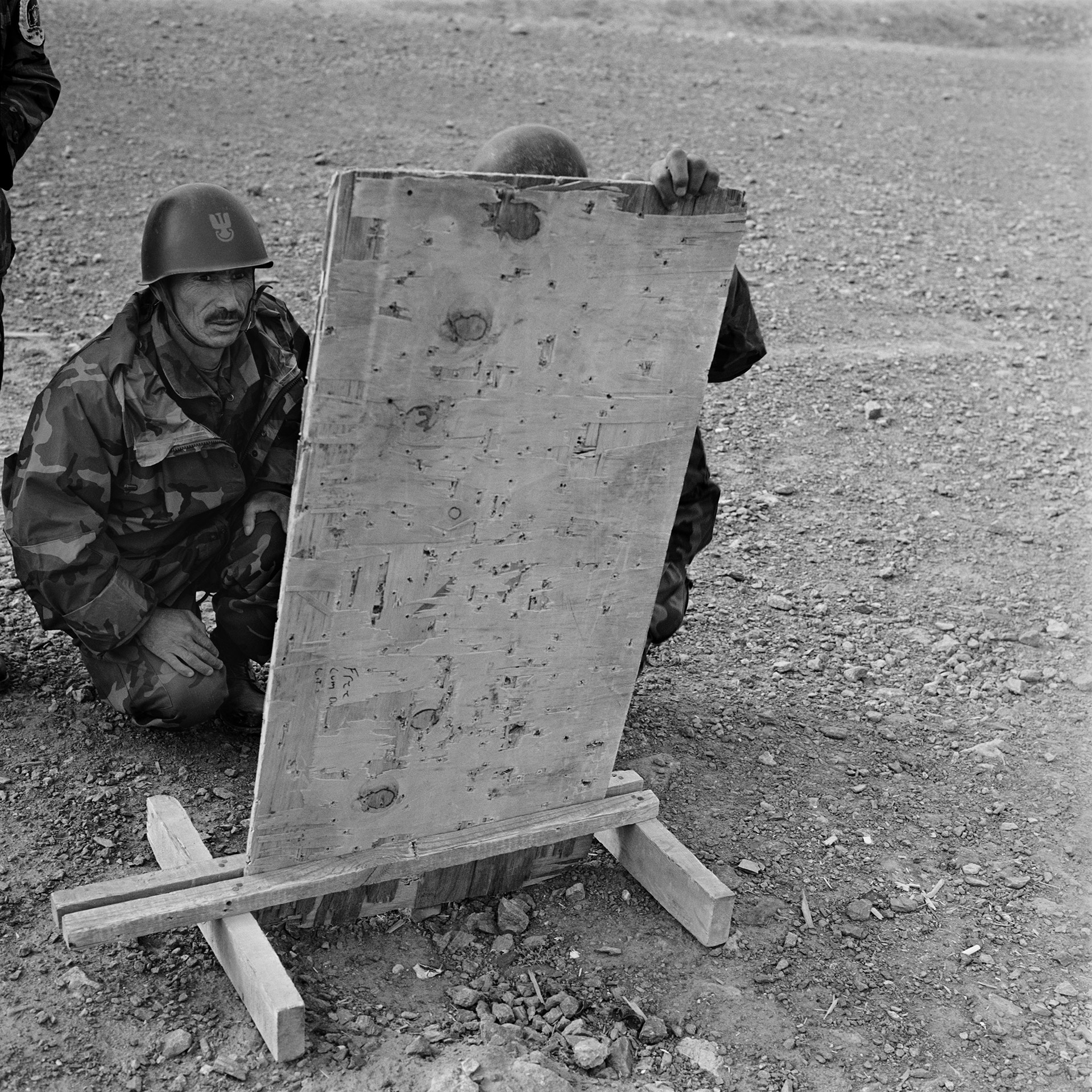
Recruits of the Afghanistan National Army (ANA) check the results of their target practice, overseen by ISAF (International Security Assistance Force). The helmets are a donation from the Polish Armed Forces. Near Kabul, Afghanistan. 28 November 2006.
The history of the ANA goes back to the early and mid-18th century when Afghanistan emerged as a country under the Hotaka and the Durrani dynasties. The latter’s enduring achievement was to emancipate Afghanistan from its role as a crossroads for conquest or as a patchwork of provinces making up the borderlands of greater powers. These had had little idea of how loosely the tribes of the Hindu Kush were connected, but now had to accept Afghanistan claiming its place as a nation, albeit it one composed of several ethnicities. With that claim came the struggle to maintain quasi-national independence vis-à-vis the empires of the new world in the making, despite the country’s own violent internal disunity.
Reorganized in 1880 under Emir Abdur Rahman, Afghanistan’s forces were not involved in either world war, as the country remained neutral in both. After the resignation of President Najibullah in 1992, the Islamic State of Afghanistan took over the army, which since the 1960s had been equipped by the Soviet Union. In 1995 the Taliban’s Islamic Emirate of Afghanistan took control of the army, which it held until its retreat in October 2001 following the launch of the U.S. bombing campaign and invasion. At the same time, private armies loyal to local warlords became increasingly influential.
On 7 October 2001, President George W. Bush authorized “Operation Enduring Freedom” and its strikes on Al-Qaeda training camps and Taliban military installations. Thus began a predictably protracted involvement—given the history of earlier invasions—one cornerstone of which would be the development of the Afghan National Defense and Security Forces (ANDSF).
On 1 December 2001 the present-day ANA was founded by presidential decree on the part of U.S.- installed Hamid Karzai. After a very brief period of high quality training by British Army personnel belonging to the International Assistance Force (ISAF), the Americans took over and the emphasis shifted to building a number of new bases for the ANA. It also rapidly grew in size from the original goal of 70,000 to 200,000 soldiers in 2012/13.
So many hands were involved in the ANA’s creation and so complicated was the command structure that problems were inevitable. By 2013 determining Afghan forces’ strength was “fraught with challenges,” and the Combined Security Transition Command-Afghanistan stated that for the ANA there is “no viable method of validating personnel numbers” (SIGAR, 2013)—with the grim exception of body counts.
From the start, recruiting was hampered by the refusal of the warlords to cooperate and by the inconsistency of international support. The PowerPoint-based police training used in the Balkans proved a serious mismatch given the high levels of illiteracy. Forces were riddled with language problems and desertions. In the end, issues such as ghost soldiers, corruption, and high levels of attrition proved a more reliable measure of ANDSF capability than training capacity.
The tally for the period October 2001 to October 2018 is 58,596 Afghanistan National Army and Police deaths. In contrast, the number of U.S. combatants killed in Afghanistan every year has declined—in large part because the U.S. has transferred much of its direct ground combat to its local allies. The
U.S. military death toll for the same 17-year period is 2,401. (Figures from Neta C. Crawford, “Costs of War. Human Cost of the Post-9/11 Wars. Lethality and the Need for Transparency,” Nov. 2018, Watson Institute, Brown University)
When desertion rates are also factored in, the steady dwindling of Afghan security forces has left them incapable of effectively fighting the Taliban resistance across much of the country. In 2015 American air raids and elite troops had to help save Sangin in Helmand, an area cleared in 2010 in a costly victory at the beginning of the surge, which by 2011 would bring U.S. troops to a peak strength of 140,000.
A group of Taliban pose and halt a traveller at Landa Khel checkpoint. Tagab Valley, Afghanistan. 19 June 1998.
From the checkpoint, travellers to the north via the Tajik Panjshir had to continue on foot with porters to haul the heavier luggage. Pillage was a frequent occurrence. A handful of apricots or biscuits seemed to assuage the Talibs’ immediate want of pay. Travellers who objected were caned to persuade them otherwise.
The no-man’s land was festooned with music tapes torn from taxi drivers’ cassette players. The Taliban’s music ban did not include the Suhras of the Holy Quran. These were blasted out at peak volume as they drove us in their Hilux from the commander’s farm up to the checkpoint.
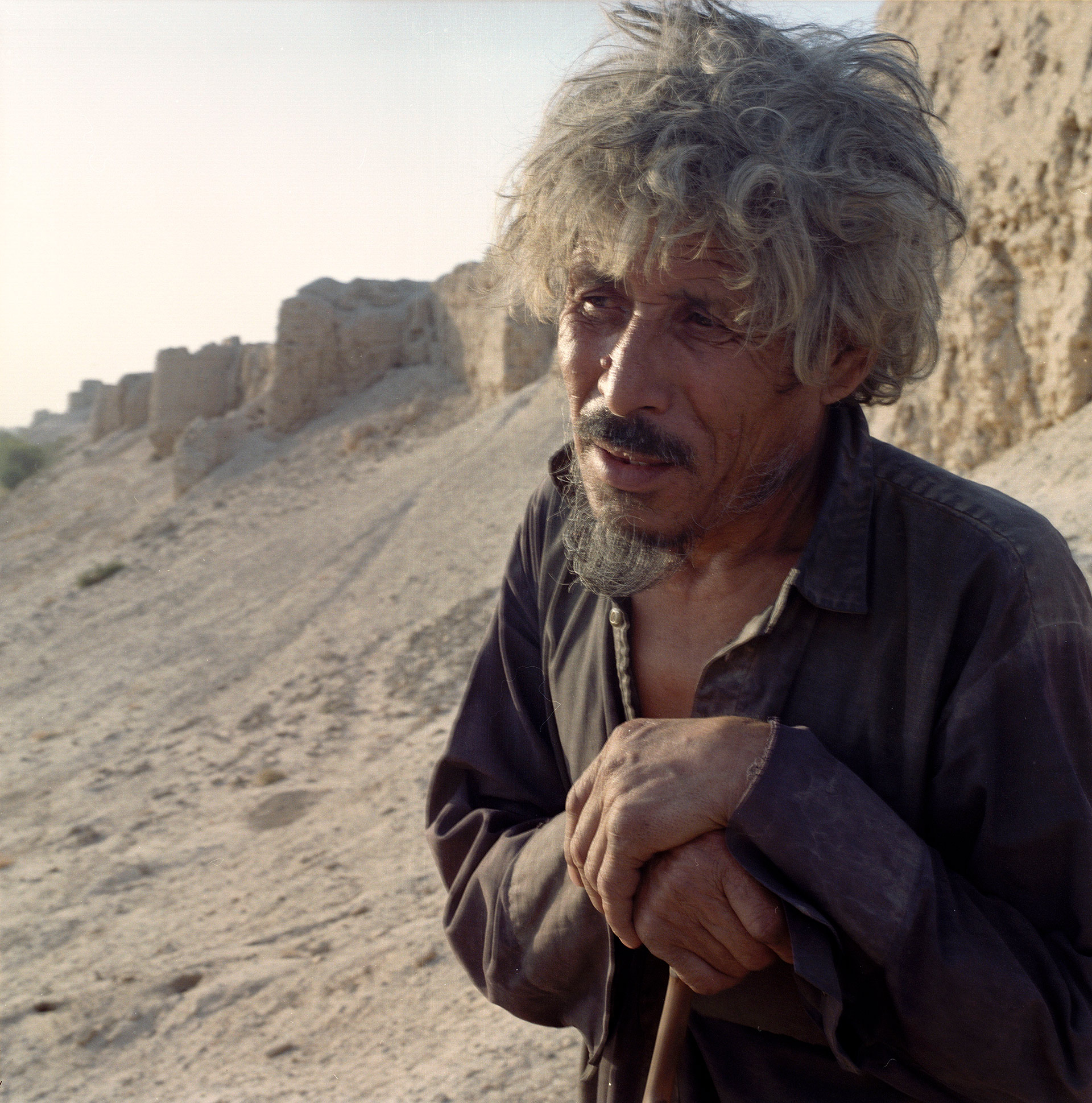
Ghani, a Sufi. Balkh, Afghanistan. 12 October 2002.
A wandering dervish who lost his entire family when a Soviet rocket destroyed his farm, sixty-four- year-old Ghani lives at the foot of the massive Timurid-era walls of Bala Hissar. He assists people who come to the shrine of a saint to pray or in search of a cure for their skin diseases. During my next visit to Balkh in 2010 I learned that Ghani had passed away.
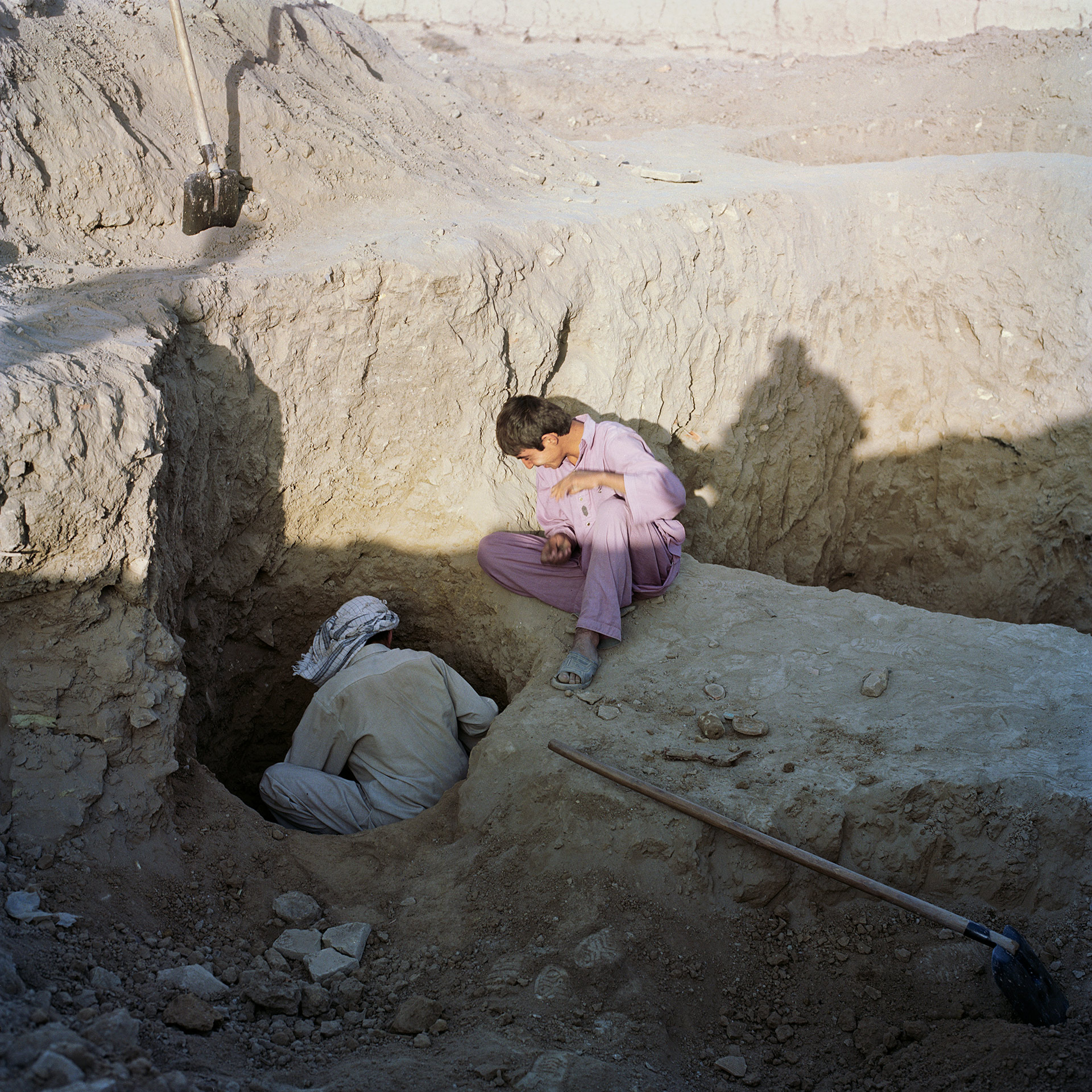
Looters digging at the site of ancient Bactria, postulated to be the city of Alexander the Great. Balkh, Afghanistan. 13 October 2002.
Objects from Bactria were in high demand. Their looting and destruction during the Taliban’s 2001 campaign to eradicate any human or animal likenesses are all the more painful since they date from the Kushan Period, when rulers and society were very tolerant and religiously inclusive.
The widespread modern-day looting of Afghanistan’s archaeological treasures—from the Stone Age and Bronze Age through Zoroastrianism to Buddhism and Early Islam—started with the civil war.
Warlords complicit in the crime still hold positions of power.
In recent years thousand of objects have been returned to the country as customs agents, Interpol and UNESCO have supported governments around the world in their efforts to put a stop to the trade in archaeological artefacts.
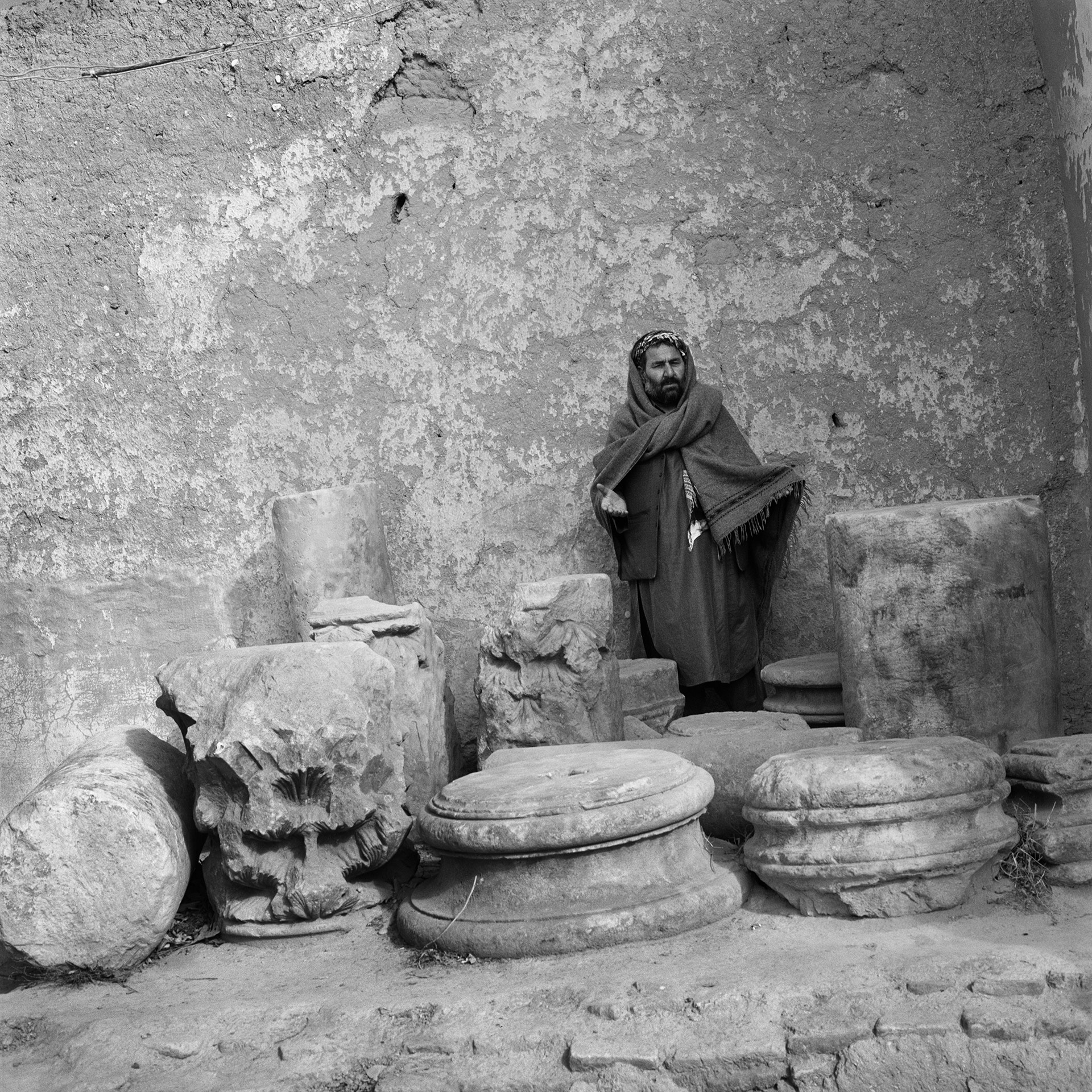
Columns and capitals testify to the Hellenic influence in ancient Bactria that with Alexander’s failed campaign to conquer India extended as far as the Hindu Kush and beyond. Balkh, Afghanistan. 9 January 2010.
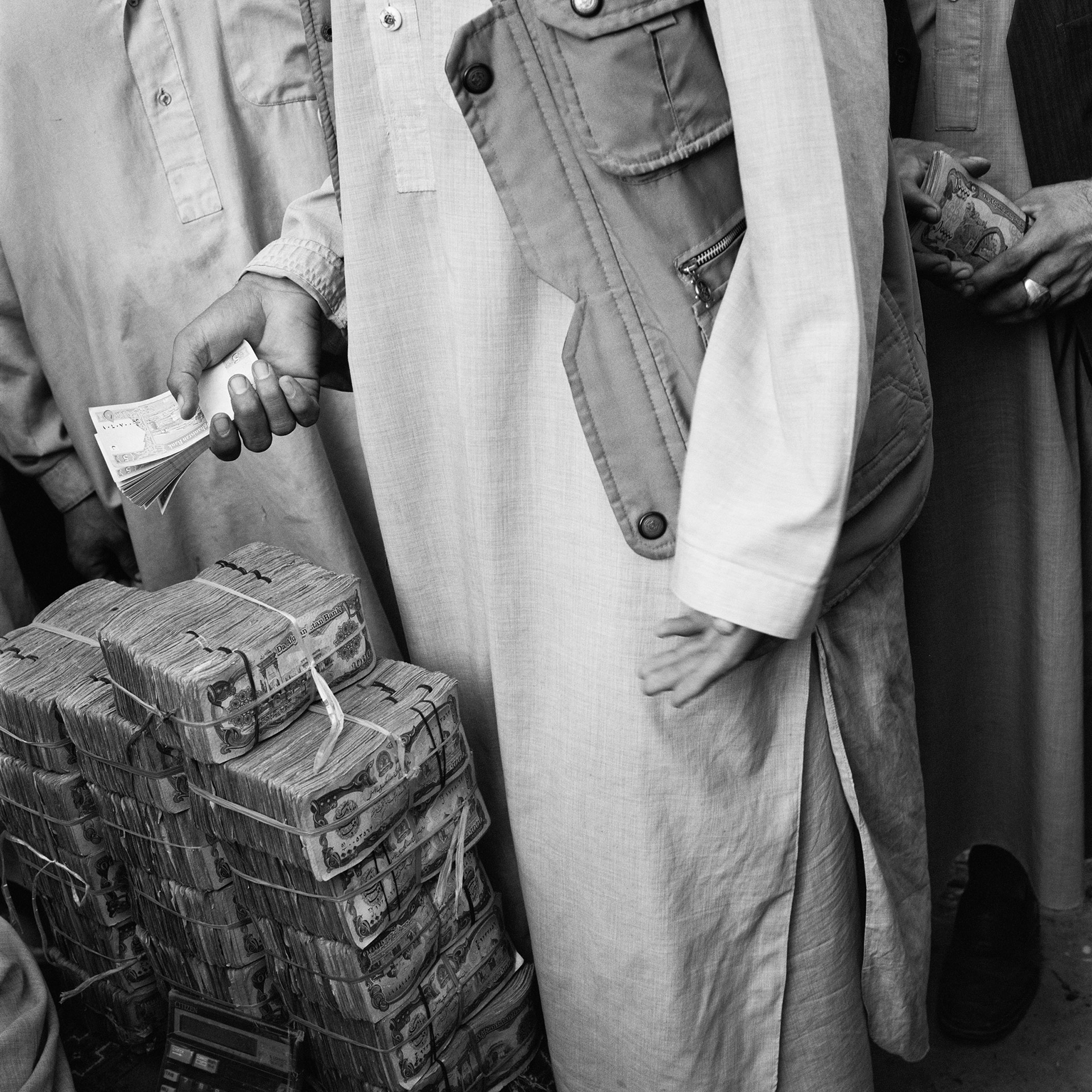
A bazaari shows a batch of new Afghani banknotes replacing those in circulation. Kefayat Market, Mazar-e-Sharif, Afghanistan. 16 October 2002.
With the international peace-enforcing and nation-building efforts of 2002 came the new money. Until then business had been done with various versions of Afghani banknotes; differing slightly in typography as well as weight, each was used only in designated parts of the country and borderlands. There was the old currency issued under King Zahir Shah, the Rabbani or Masud money, the Dostum Afghani and the Taliban Afghani.
Piles of these currencies were incinerated in ovens hastily built in front of the Central Bank of Afghanistan and under the supervision of foreign experts.
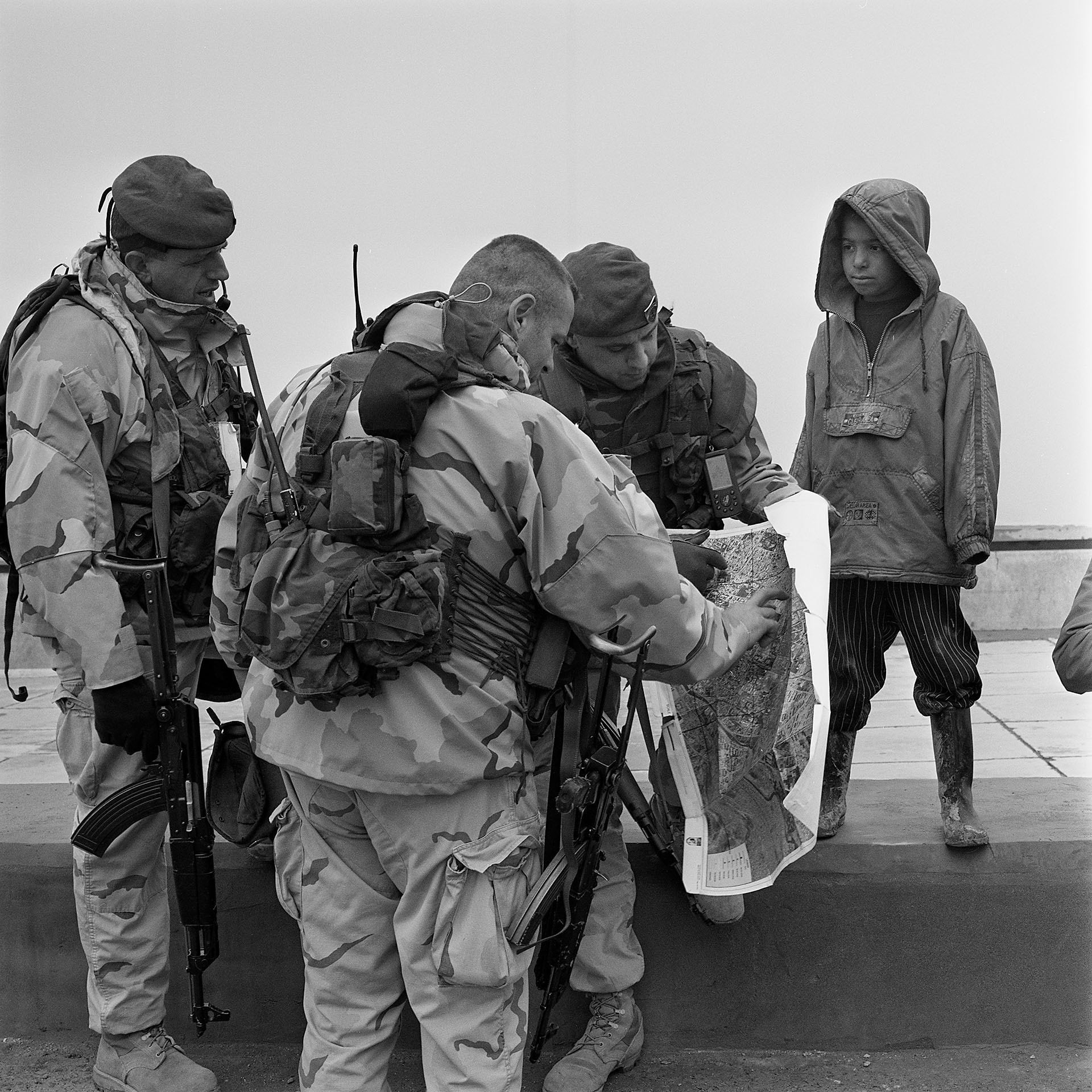
Macedonian ISAF soldiers on patrol on Bibi Mehro Hill. Standing next to the swimming pool on the summit, they ponder a Kabul street map. Wazir Akbar Khan, Kabul, Afghanistan. 29 November 2006.
The hill is also known as “Swimming Pool Hill” after the pool built by the Soviets, later used by the Taliban as an execution ground.
Established in December 2001 by UN Security Council resolution 1368 for the primary purpose of training the Afghan National Security Forces (ANSF) and enabling Afghanistan to rebuild key government institutions, the International Security Assistance Force (ISAF) was soon obliged to expand its mission to secure Kabul and its hinterland from the Taliban and Al-Qaeda beyond the capital and to engage in combat operations to both the south and east.
Some of the ISAF countries that contributed to “Operation Enduring Freedom-Afghanistan” had to act subject to national caveats, meaning that trainers could not be deployed throughout the country.
By 2008 at the latest it had become evident that the NATO coalition’s military presence, consisting of troops from 41 countries, was not the solution but part of the problem. Even stranger than the fact that NATO—the North Atlantic Treaty Organization established as part of the post-WWII world order in 1949—was supposedly defending itself in a faraway landlocked country was the involvement in its campaign of nations like El Salvador on the Pacific and Singapore on the shores of the South China Sea.
ISAF was disbanded in 2014, contributing only some advisory troops to the successor organization, Resolute Support Mission.
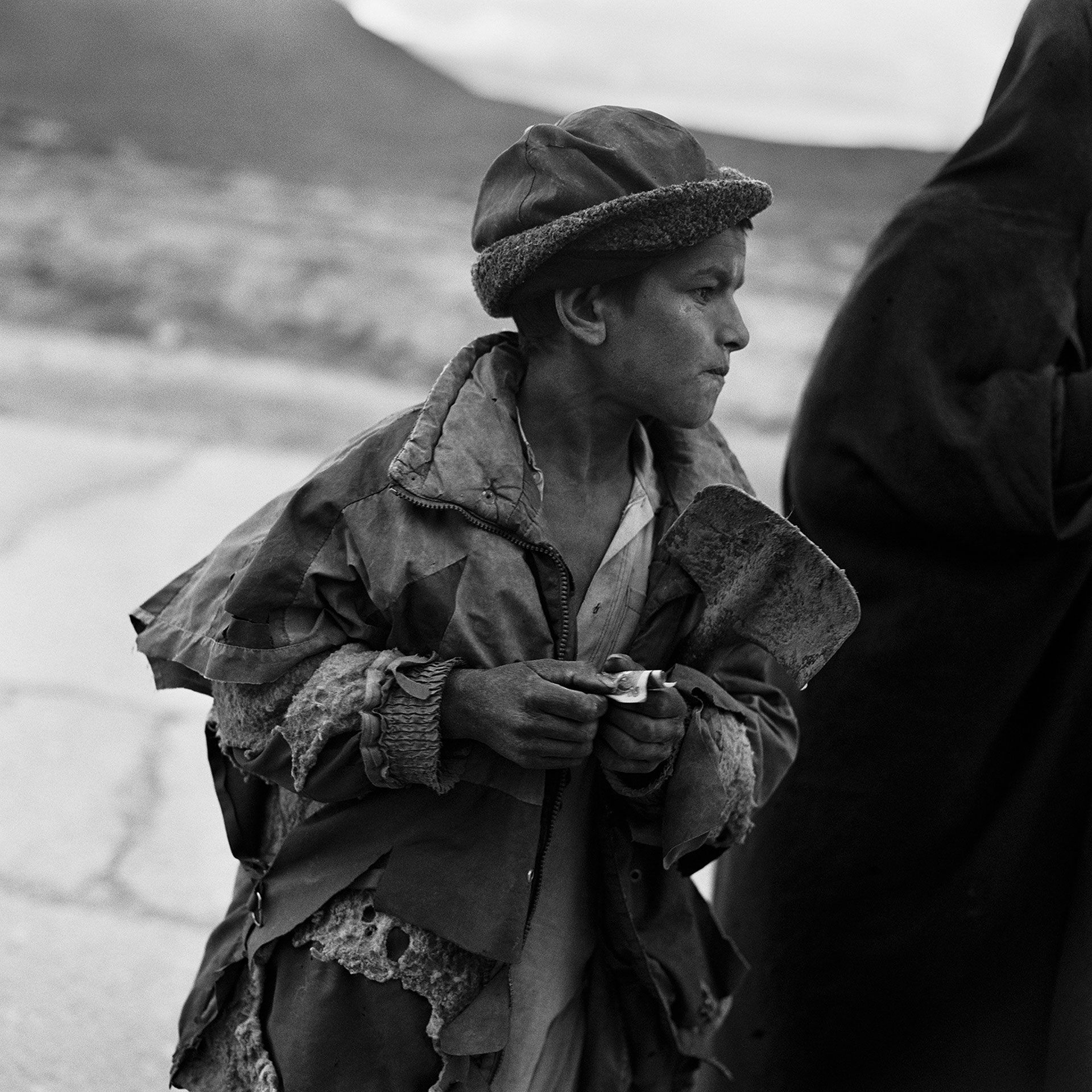
Repairing potholes along the “Betonka” as vehicles approach has remained a source of income for children and war invalids to this day. Farah Province, Afghanistan, 2 April 2001.
Built by the Soviets in the 1950s and suitable for tanks, the north-western part of the Afghan ring- road—called the “Betonka”—connects Herat and Kandahar. The band of concrete slabs weathered three decades of war much better than the American tarmac in the south.
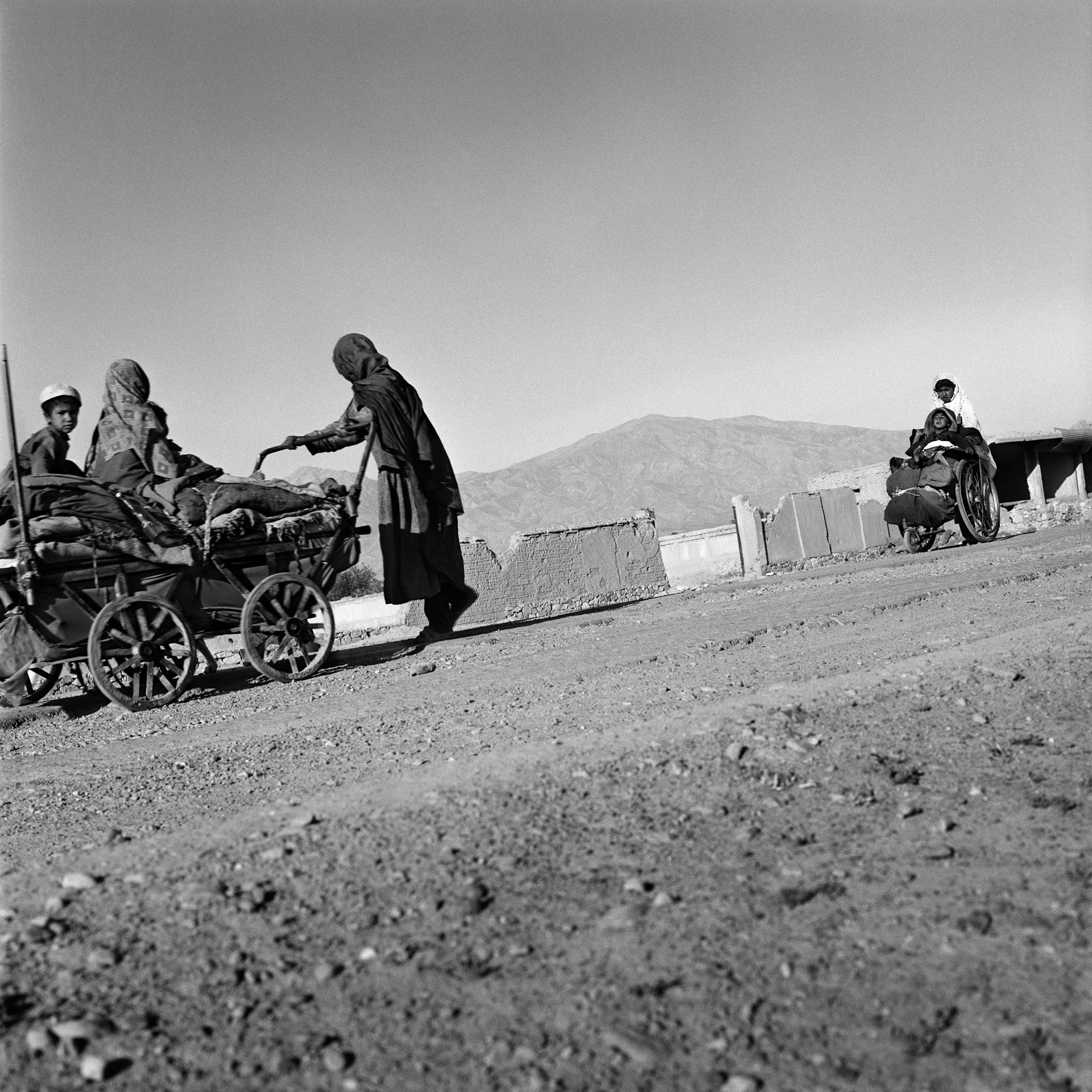
A family displaced by war passes the debris field of the southern suburbs, formerly a frontline in the battle for the capital city. Every section of mud wall still standing had OMAR painted on it—the acronym for “Organization for Mine Clearing and Afghan Rehabilitation.” Kabul, Afghanistan. 21 June 1998.
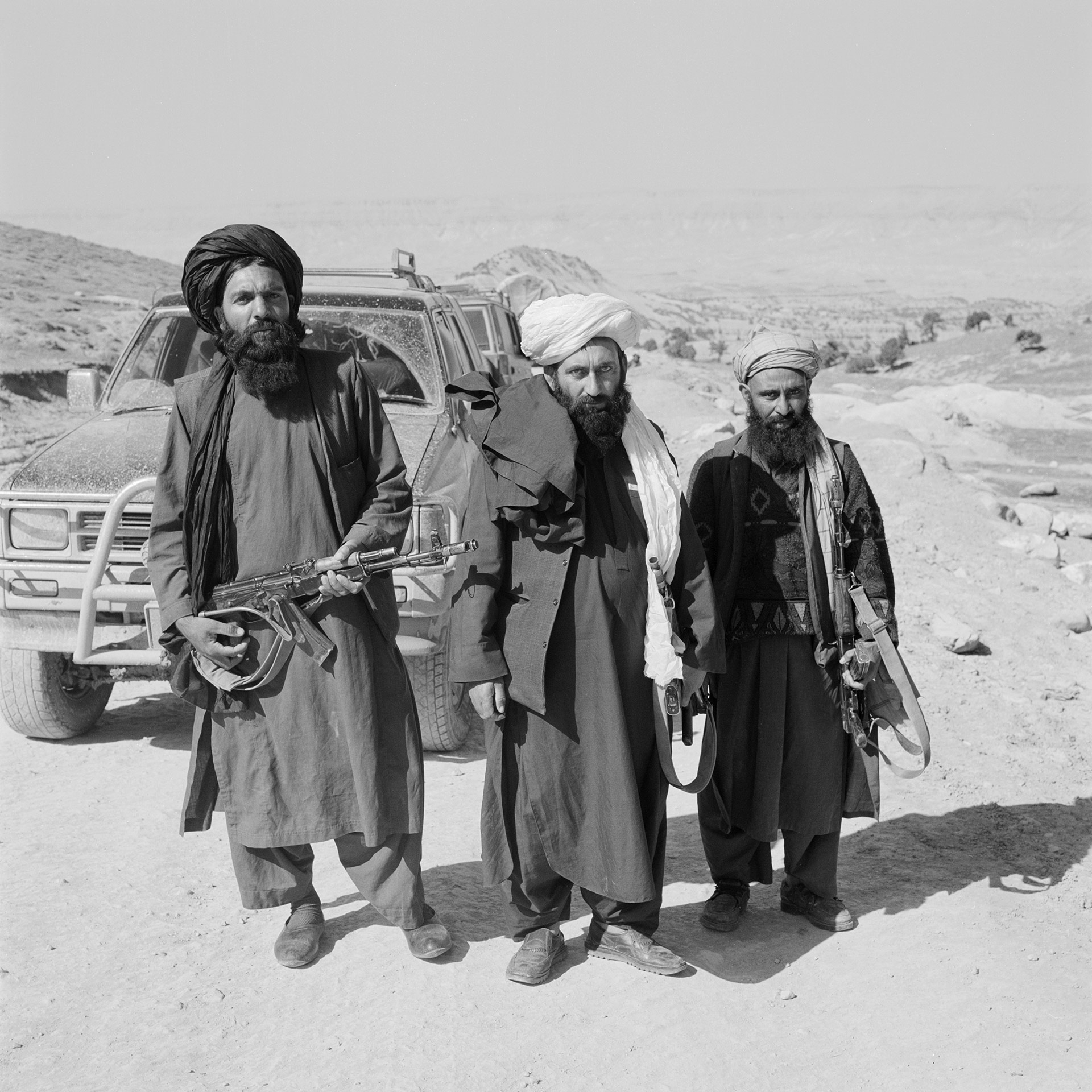
Brief encounter with the Taliban. Sabzak Pass, Afghanistan. 31 March 2001.
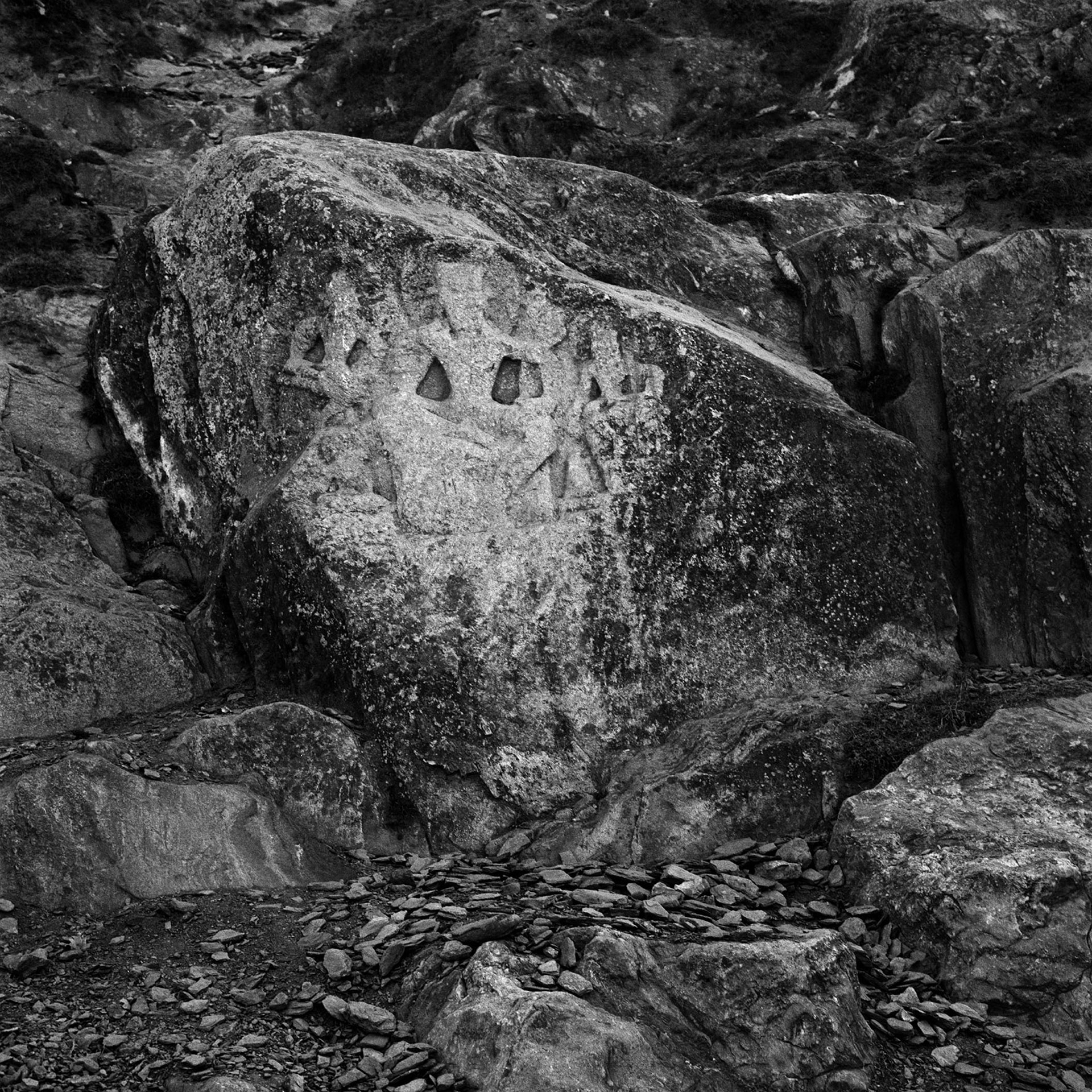
A smashed relief of the Buddha. Swat Valley, Pakistan. 21 December 2009.
Buddhist engravings in the Swat Valley and even further afield in the Upper Indus region attest to the Kushan Period, especially that under Kanishka the Great (128–151), which is considered the Golden Age of Gandhara. The area is immensely rich in ruins of stupas and monasteries, and rock carvings—relief sculpture and stelae—abound.
With the Islamization of Gandhara in the 10th century came the belief among Muslims that every stone that hit the Buddha’s face would bring the thrower one step closer to Paradise.
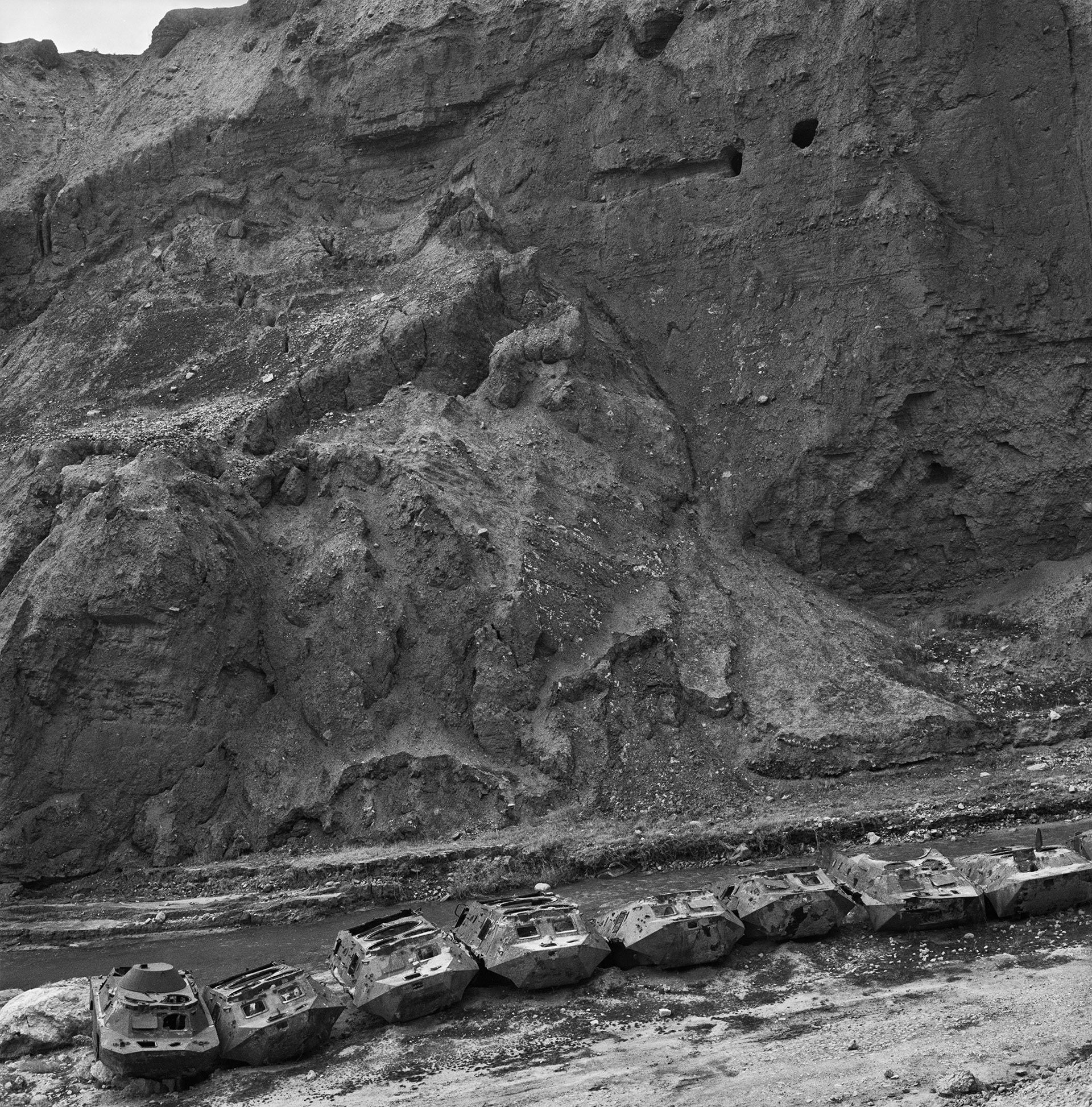
Ambushed armoured Soviet personnel carriers. Tashkurgan, Balkh Province, Afghanistan. 10 January 2010.
Hastily deployed and ill-prepared to put an end to the vicious political feuding in Afghanistan, the Soviet 40th Army was inexorably sucked into a war against an elusive enemy.
The ensuing quagmire was dubbed the “Soviet Union’s Vietnam” at the time. Since 2001, however,
U.S. and NATO/ISAF auxiliary forces have been equally unsuccessful in their war efforts in Afghanistan.
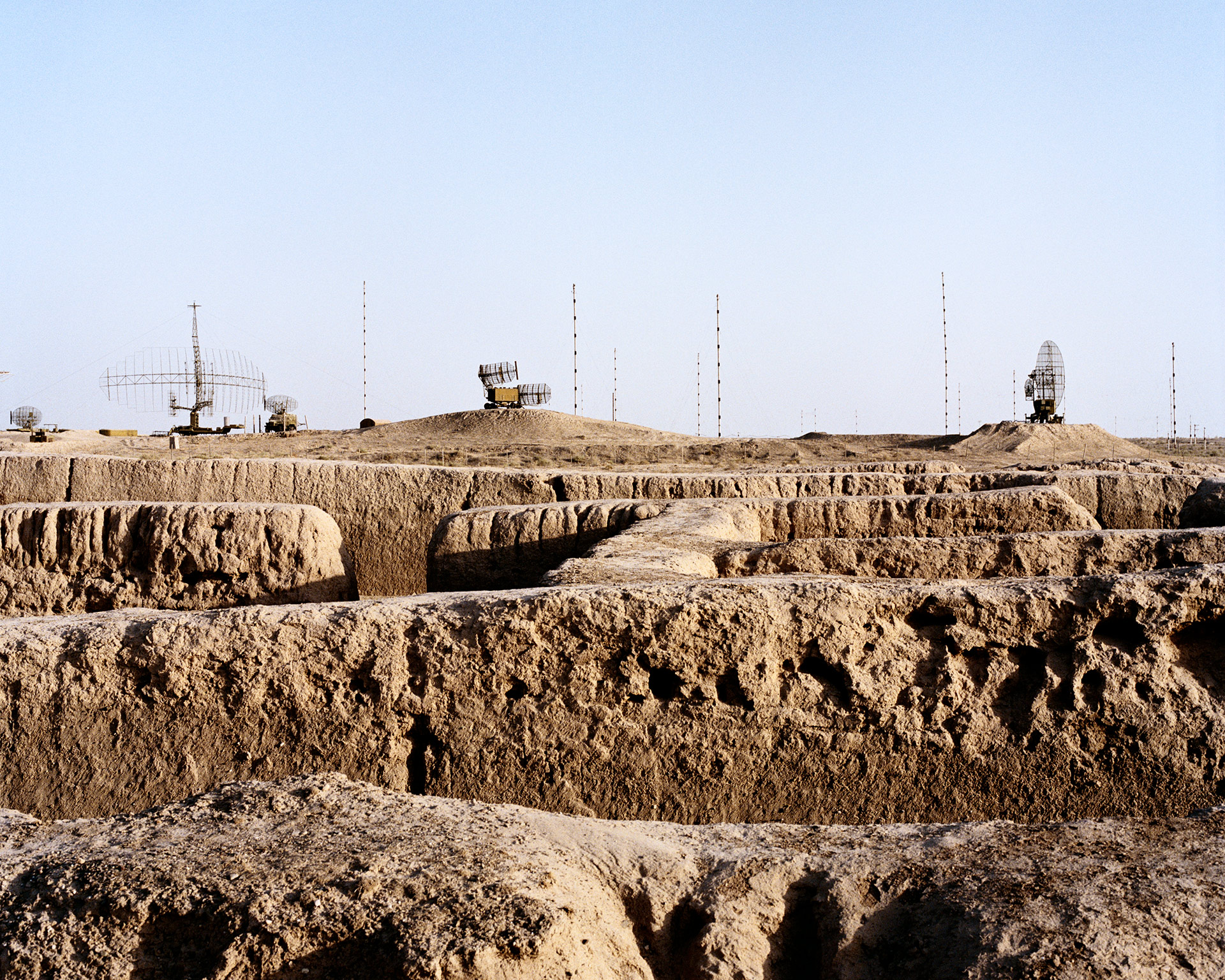
An IFF (Identification Friend or Foe) system from Soviet times sits on the ruins of an early Buddhist monastery. Kara Tepe, Termez, Uzbekistan. 10 October 2002.
“Termez” is a faint echo of the Sanskrit “Tarmita,” which is what the city was called in the 3rd century when it was an important way-station for the spread of Buddhist belief and thought from India to China and beyond. It was here that the monk Dharmamitra for the first time translated the words of the Buddha into the languages spoken in Bactria and Sogdia.
In the 1970s the Soviet Army dug artillery positions into the ruins of Kara Tepe overlooking the muddy, meandering Amu Darya, which in those days marked the border between the Soviet Republic of Uzbekistan and Afghanistan.
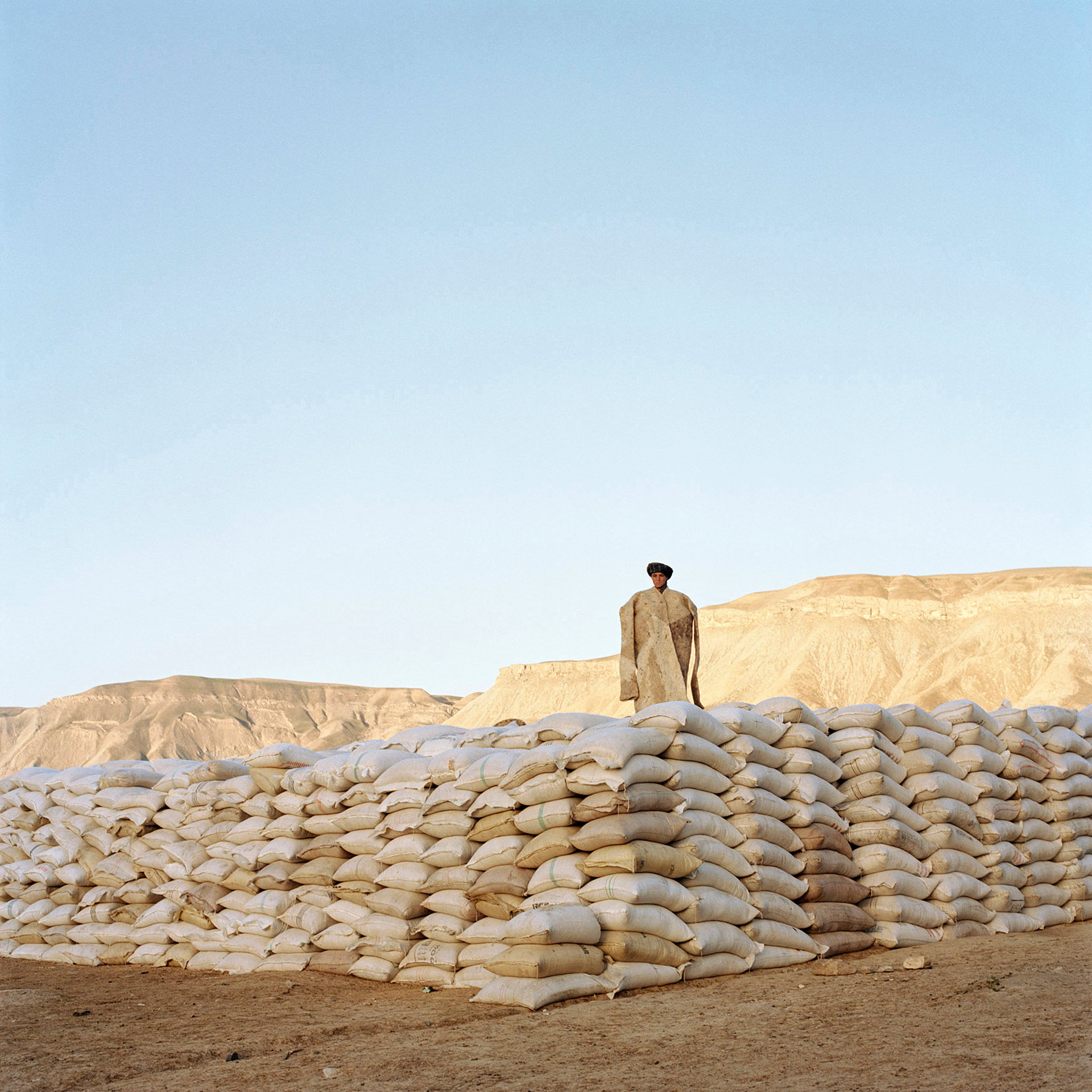
A guard clad in a shepherd’s felt cape stands on sacks of flour destined for the drought victims left behind in the caves of Murghab Canyon. Regi, Badghis Province. 30 March 2001.
To facilitate a report on the drought that had affected the entire north-west of the country, the Taliban leadership in Kandahar agreed that, contrary to its normal policy, I should be allowed to photograph those in distress.
When Afghanistan endured its worst drought in thirty years, four million people were forced to leave their homes. The cumulative effect of three rainless years, the extreme cold of the previous winter, and the war in the north-east had made a humanitarian disaster inevitable. The Taliban leadership and World Food Program repeatedly asked the international community for help. But with its refusal to extradite Osama bin Laden, the Taliban regime effectively sealed the Emirate of Afghanistan’s isolation. One consequence of the UN sanctions against it was a ban on Ariana flights, which in turn impeded the transport of relief goods and desperately needed medical supplies. While the sanctions forbade members of the international community, the EU and ASEAN from providing any help at all, economic or military, the Northern Alliance, the Taliban’s opponent, continued to enjoy the support of Russia and Iran.
The overland journey through what became the world’s top outlaw state, so impoverished that it no longer even features in UN statistics, led from Kandahar to camps in Herat, across the Sabzak Pass into Badghis province, deep into Murghab Canyon and to encounters with those who, having lost livestock and seeds, were stranded in caves without hope of escape. There they subsisted on what would normally be camel fodder.
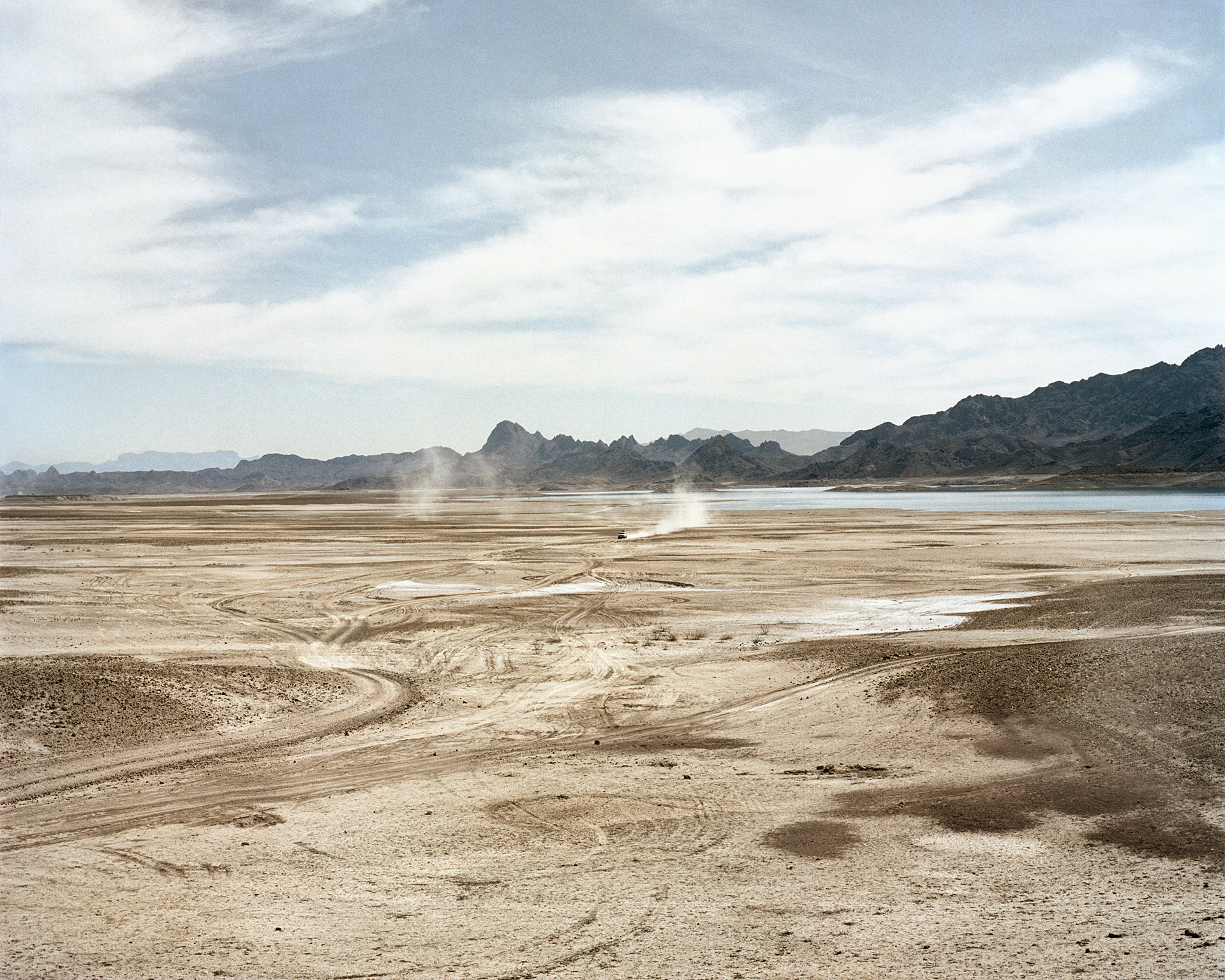
After three rainless years and the worst drought in thirty years which had forced four million people to leave their homes, the reservoir behind the Dahla Dam was almost completely parched. Arghandab, Kandahar Province, Afghanistan. 23 March 2001.
Riding in the truck approaching us was a group of Taliban who had gone to shoot ducks. They did not allow us to see the wreckage of a Soviet helicopter gunship and the scattered bones of the crew that had been found a month before.
The gunship must have been downed during the Arghandab Offensive in May-June 1987, when patrols flew patterns along the 15–20-km-long and 7-km-wide “Green Zone” bordering the north bank of the river.
Intersected by a dense network of canals and vineyards and used by the Mujahideen to construct organized defenses, including houses, adobe forts, walls and pomegranate-orchard earth works, this zone—sometimes called the “Bread Basket of Afghanistan” and the country’s second major opium farm after Helmand—confronted U.S. troops and their coalition allies with exactly the same challenges in the 21st century.
The 55-meter-high Dahla Dam, an embankment made of earth and rock fill supplemented by six saddle dams, was built by the Americans between 1950 and 1952 as the primary source of irrigation for Kandahar Province.
During the Soviet occupation the Arghandab irrigation system fell into decay and the reservoir was left to silt up.
The infrastructure was repaired with Canadian assistance between 2009 and 2012, after the rocky areas of the dam had been cleared of mines by the U.S. Army Corps of Engineers. The planned raising of the dam that it initiated and that was seen as crucial to increasing the available water volumes was subsequently abandoned due to financial issues.
When built, the Dahla Dam and the irrigation system below it were under the control of the Helmand and Arghandab Valley Authority. Modelled on the Tennessee Valley Authority, this implanted what the historian Arnold Toynbee in 1961 called “a piece of America” into the heart of the vast desert south of Kandahar—right on the spot where Lashkargah, the winter quarters of the Ghaznavid Dynasty, had once sprawled.
Toynbee found that the area had ceased to be a part of traditional Afghanistan. Straight roads and equally straight canals cut through the desert like a knife. Alexander’s Arachosia looked like Nevada and the Helmand the engineers had left bleeding resembled Colorado.
This American high-handedness in dealing with nature was a new experience for the Afghans. Until the arrival of modern technology the Afghan had “humoured Nature,” to use Toynbee’s words, not hit her over the head to get her to meet his needs: “He goes to meet Nature; he does not expect Nature to come and meet him.”
As agricultural production rose and the average farm income increased tenfold, the American project also created fantastic opportunities for drug lords. After all, plots of poppy plants are easily mixed in among plots of tomatoes or okra.
Opium poppy cultivation in the Arghandab “Green Zone” and in Helmand—part of the so-called “Golden Crescent”—provided the Soviet Union with a devastating new front as its soldiers turned to drugs for the same reasons as many Americans did in Vietnam. Young, freed from the constraints of home, frightened and under psychological duress, they could not afford to buy even cigarettes from their meagre ruble pay packets. To raise enough money for hashish, the “Afgantsy” (as Soviet or Russian war veterans are known) resorted to selling gas, ammunition and AKs, and sometimes even tried to steal their fallen comrades’ guns.
After almost two decades of Western intervention, one trillion dollars spent by Washington on military operations and no end of fighting in sight, Afghanistan could now become a true narco-state, since none of the said operations has succeeded in tackling Central Asia’s illicit opium trade. In the 1980s, when America was determined to deal Moscow its “own Vietnam,” the CIA provided the Mujahideen with an estimated three billion dollars’ worth of arms. Those, together with the ever larger opium harvests, sustained the resistance until the Soviets withdrew after the 40th Army’s decade-long campaign, which officially had left 13,833 of their number dead. (The actual figure is more like 26,000).
The strategy had succeeded because the CIA’s proxy war had not disrupted the way its Afghan allies used drug trafficking to sustain the struggle.
In contrast, the West’s peace-enforcing efforts since the invasion of October 2001 have failed to contain the Taliban insurgency precisely because the surplus heroin trade can no longer be controlled. Afghanistan’s opium production jumped from ca. 180 tonnes in 2001 to more than 3,000 tonnes a year later and to more than 8,000 tonnes in 2007.
In a bitter irony of history, a combination of ecology and military technology has transformed the country into a state where illicit drugs dominate the rural economy and define political choices. They also determine the fate of foreign interventions and are intricately bound up with government corruption. When the mainstay of a country’s economy is illegal, the state’s legitimacy is undermined. (The last few paragraphs are based on Alfred W. McCoy, “How the heroin trade explains the U.S.-U.K. failure in Afghanistan,” in The Guardian, 9 January 2018).
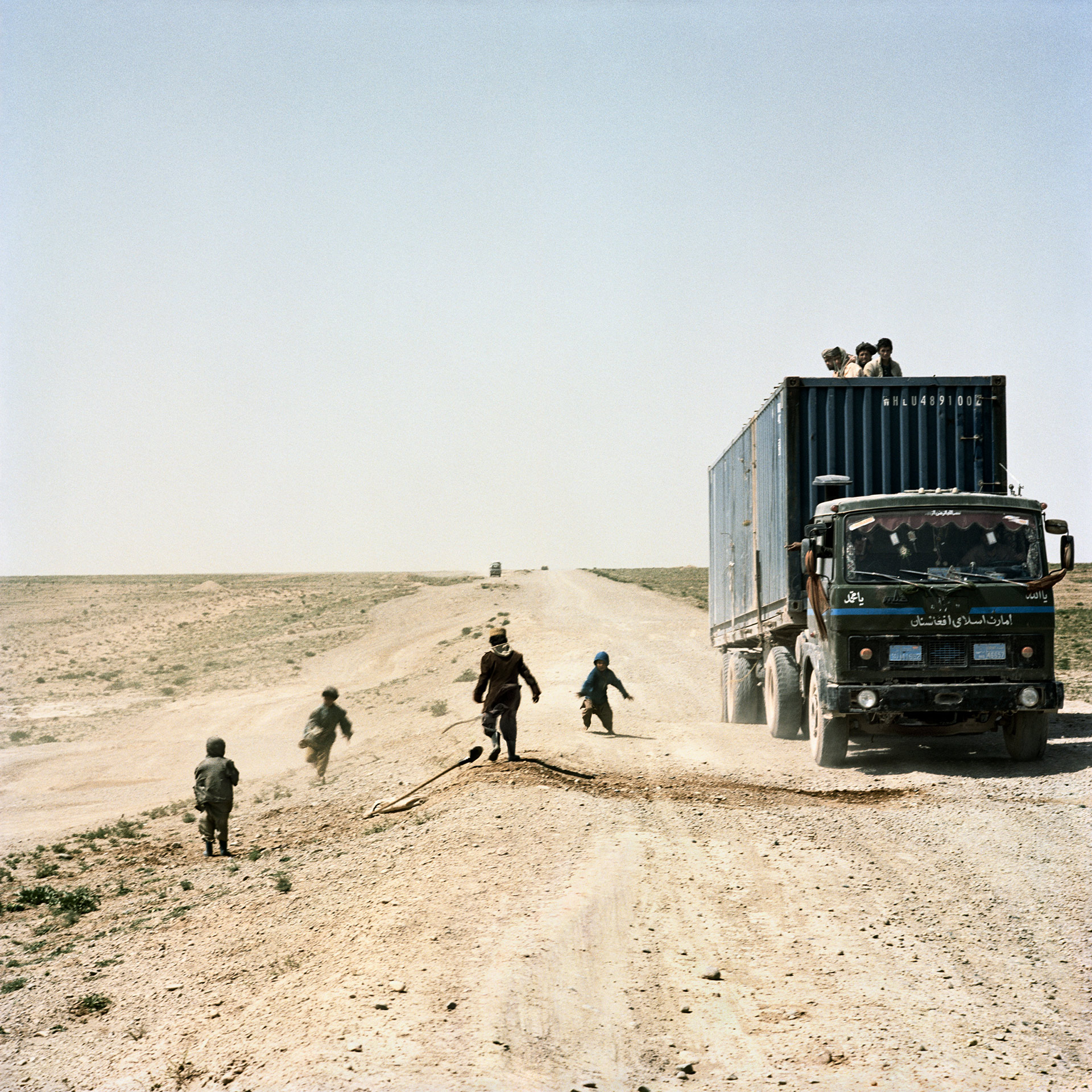
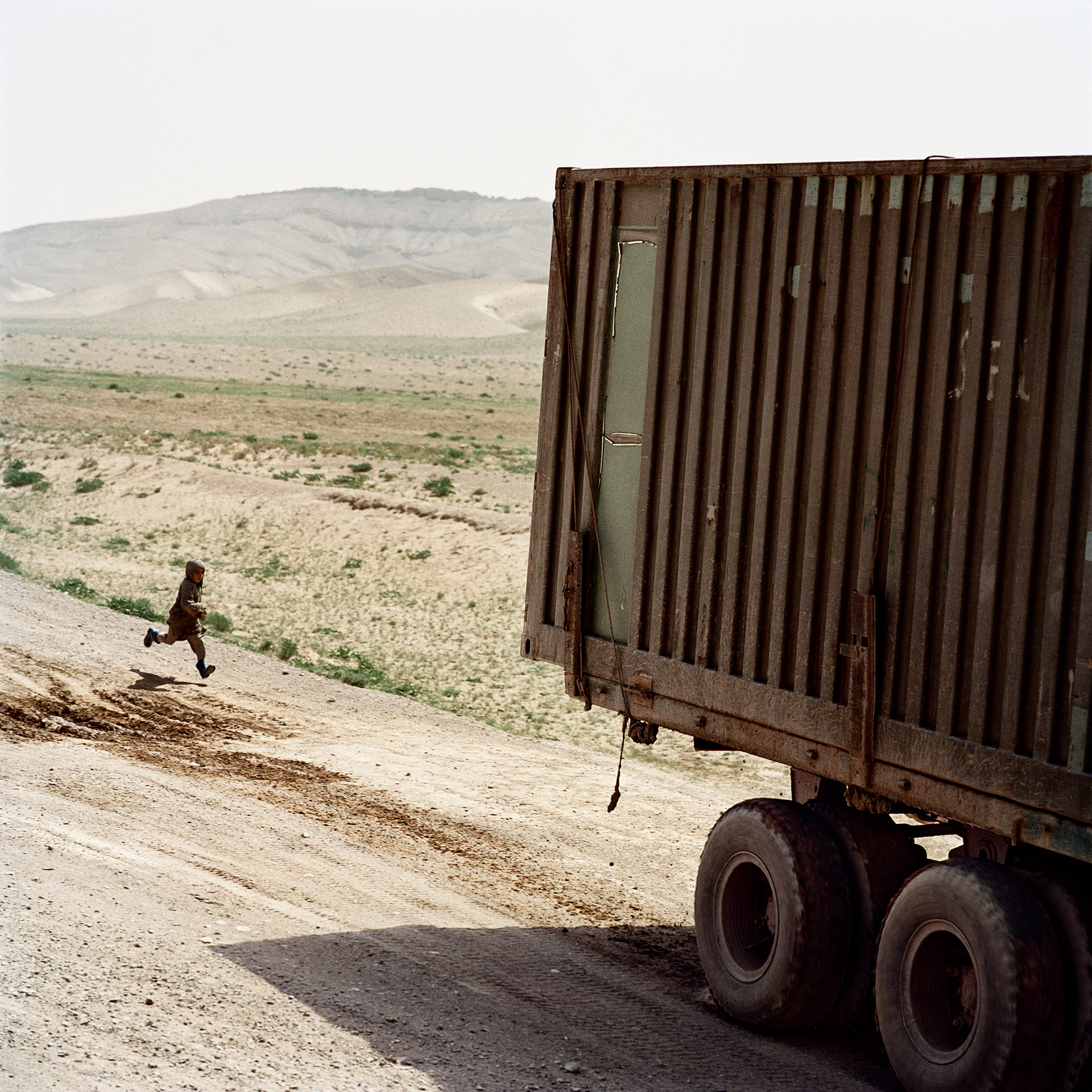
Kids run after banknotes thrown to them by truck drivers. Between Islam Qaleh and Herat. Afghanistan. 2 April 2001.
The donations are for repairing potholes and have to be caught before they flutter into the grassy steppe, which is still infested with landmines from the days of the Soviet occupation. The road connecting the Iranian border and Herat is badly damaged due to heavy traffic transporting unknown quantities of consumer goods made in Japan from the Persian Gulf through Iran and back—a business that results in unknown millions of dollars in transit fees and duties, fuelling war operations.
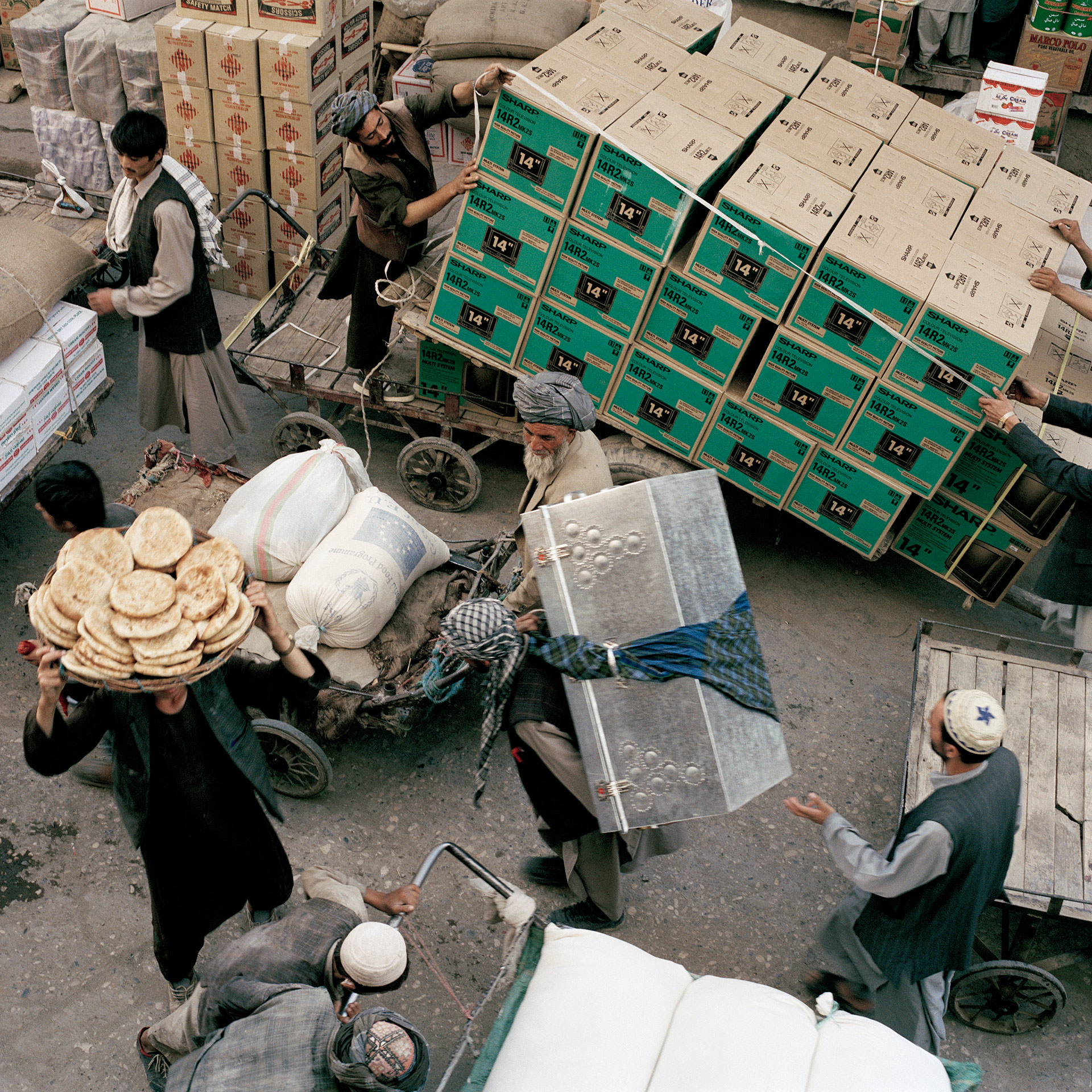
A scene at Kefayat Market, Mazar-e-Sharif, Afghanistan. 16 October 2002.
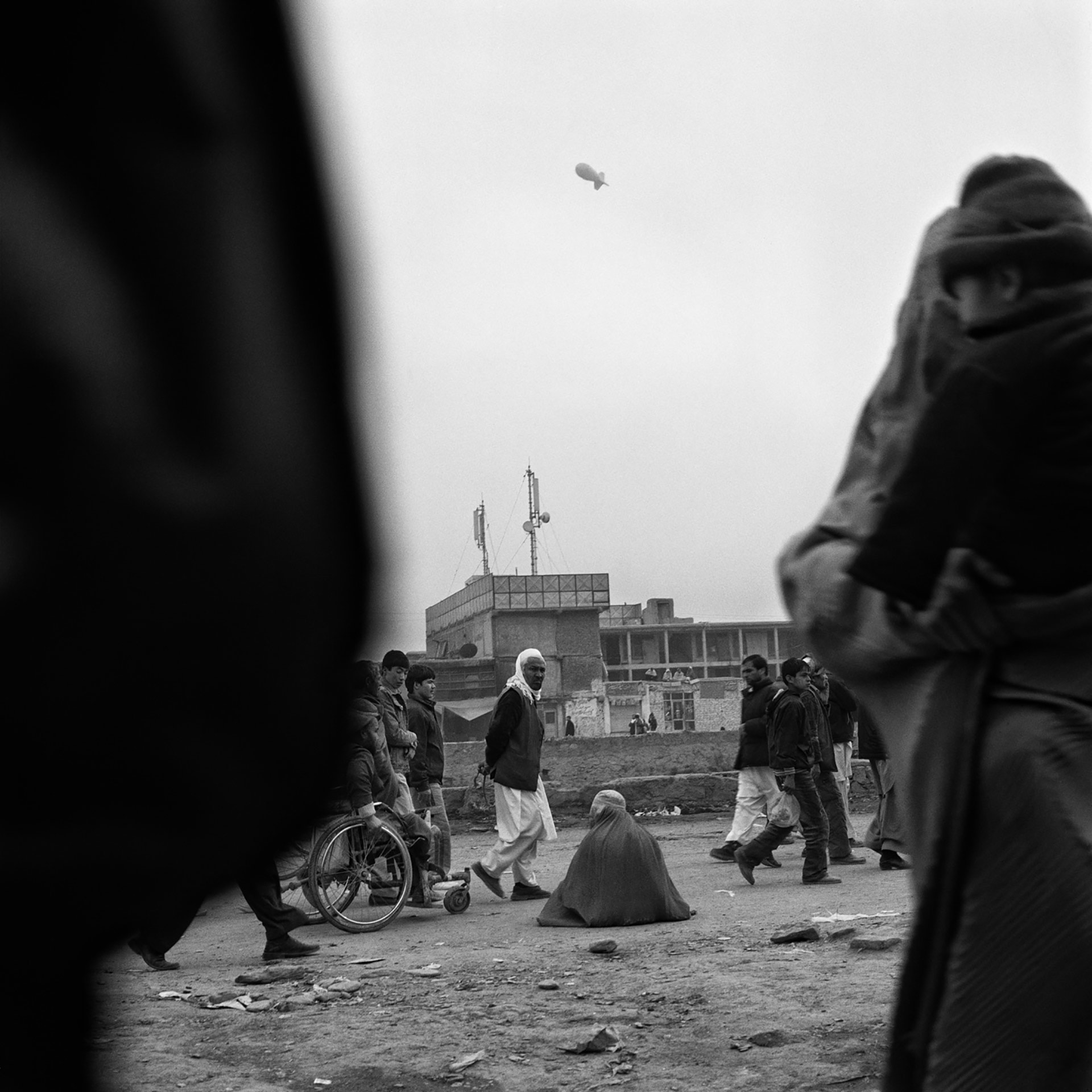
A surveillance and reconnaissance balloon hovers above preparations for the Shia Muharram procession in the Murad Khane District. Kabul, Afghanistan. 27 December 2009.
The infrared and colour video cameras attached to the U.S. army helium balloon may be able to detect the black-market trade in allied fuel supplies, but not members of the armed resistance infiltrating the capital. Local people fear the “eye of the immoral foreigner” is spying on women and children.
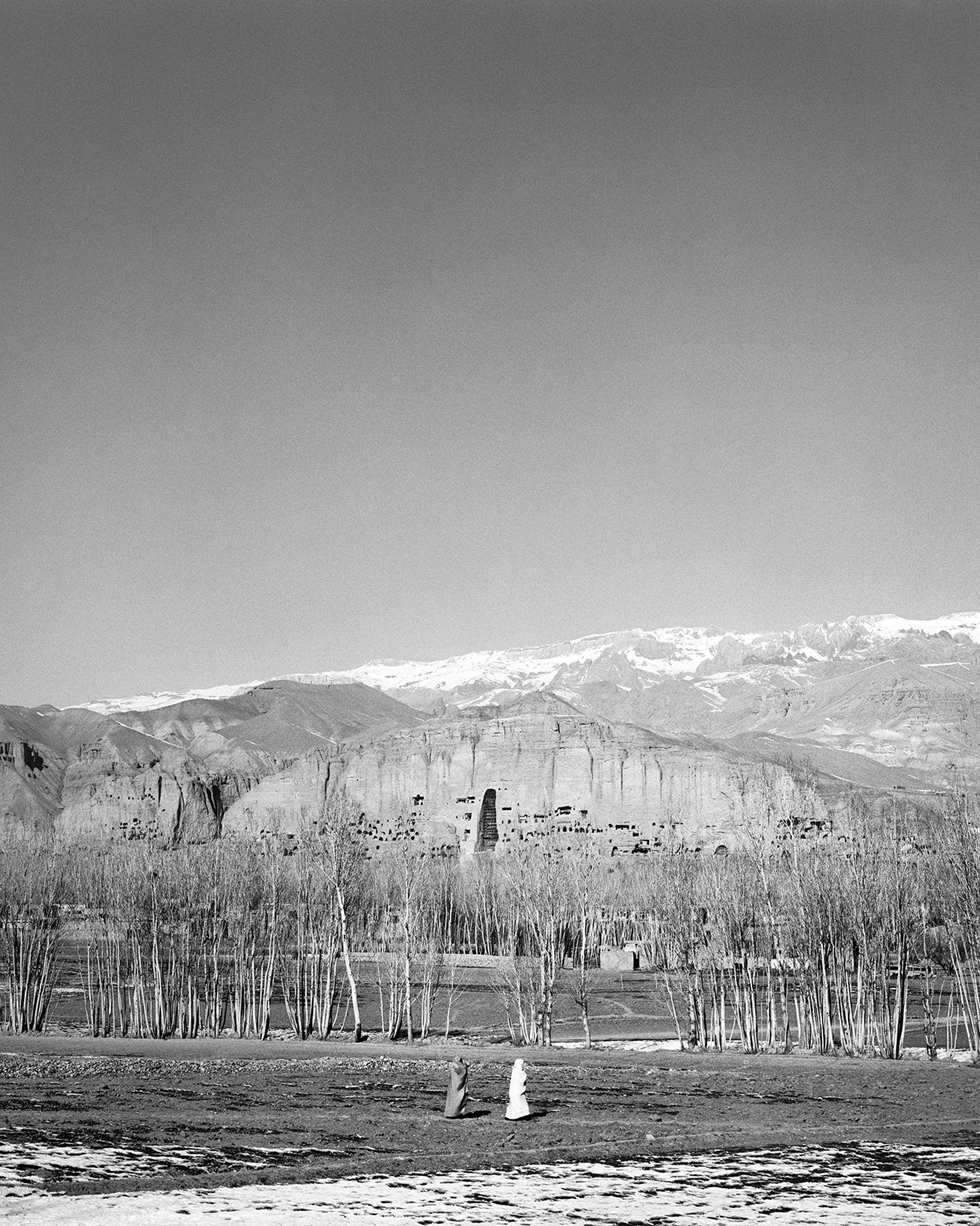
The niche of the smaller of the Giant Buddhas destroyed under Taliban rule on 8/9 March 2001. Bamian Province, Afghanistan. 1 January 2010.
After the fall of the Taliban there was talk of rebuilding the 6th-century Buddhas. But today only the abandoned scaffolding remains inside the niches. When they left the site the German and French archaeologists took with them the keys to the doors leading to the top niche and to the storerooms where the debris of the colossi is kept.
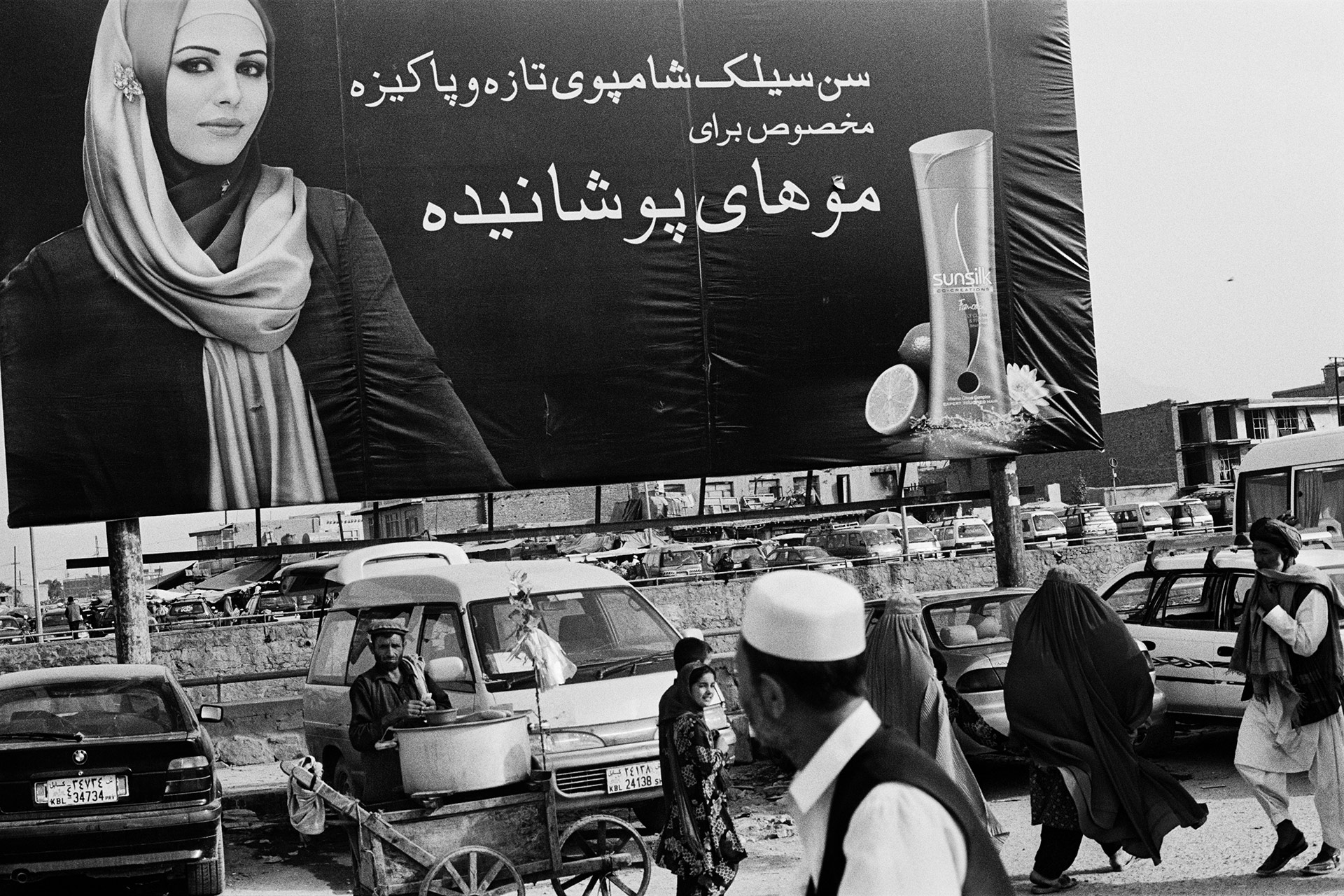
An advertisement in the Old Town of Murad Khane signals some kind of cosmopolitan future. Kabul, Afghanistan. 16 September 2012
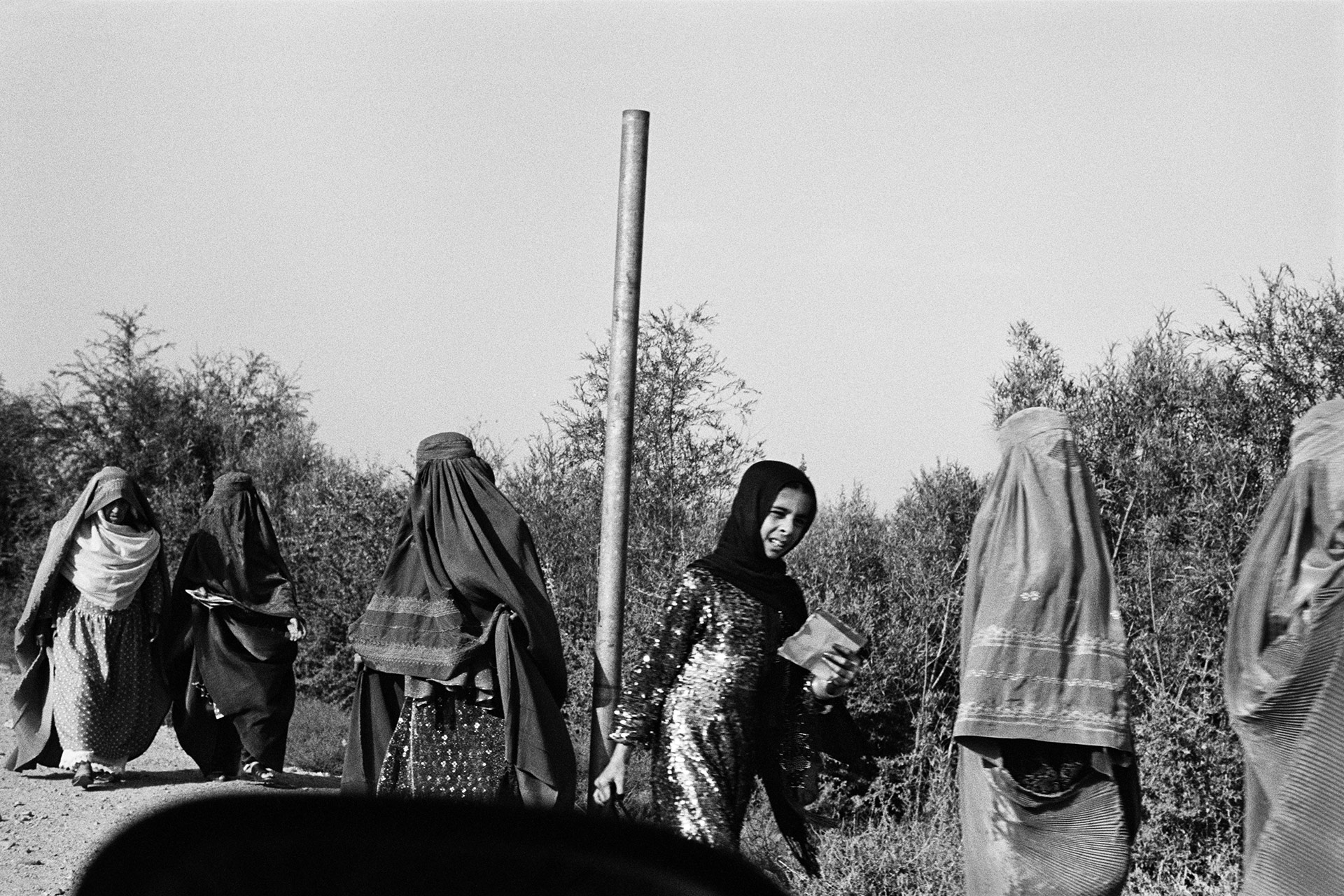
En route to Charikar, Parwan Province, Afghanistan. 13 September 2012.
A male foreigner does not have much of an insight into the life of women in Afghanistan, not even as a guest in someone’s home. Pictures taken by outsiders often seem to confirm prejudices; or they raise questions without ever providing certainties. Is the girl in the group a child bride on her way to an arranged marriage? If so, has the mother agreed to the marriage? Or is she resigned to seeing her daughter suffer the same fate that perhaps she herself did (often causing lifelong trauma)?
These traditions are more deeply entrenched than those other social and domestic structures that have been broken down in the many misguided attempts to impose “progress” from without. Not only did they withstand the Soviets’ socialist experiments, but they will also survive the West’s cultural re- education project that is tied to its enforcement of peace.
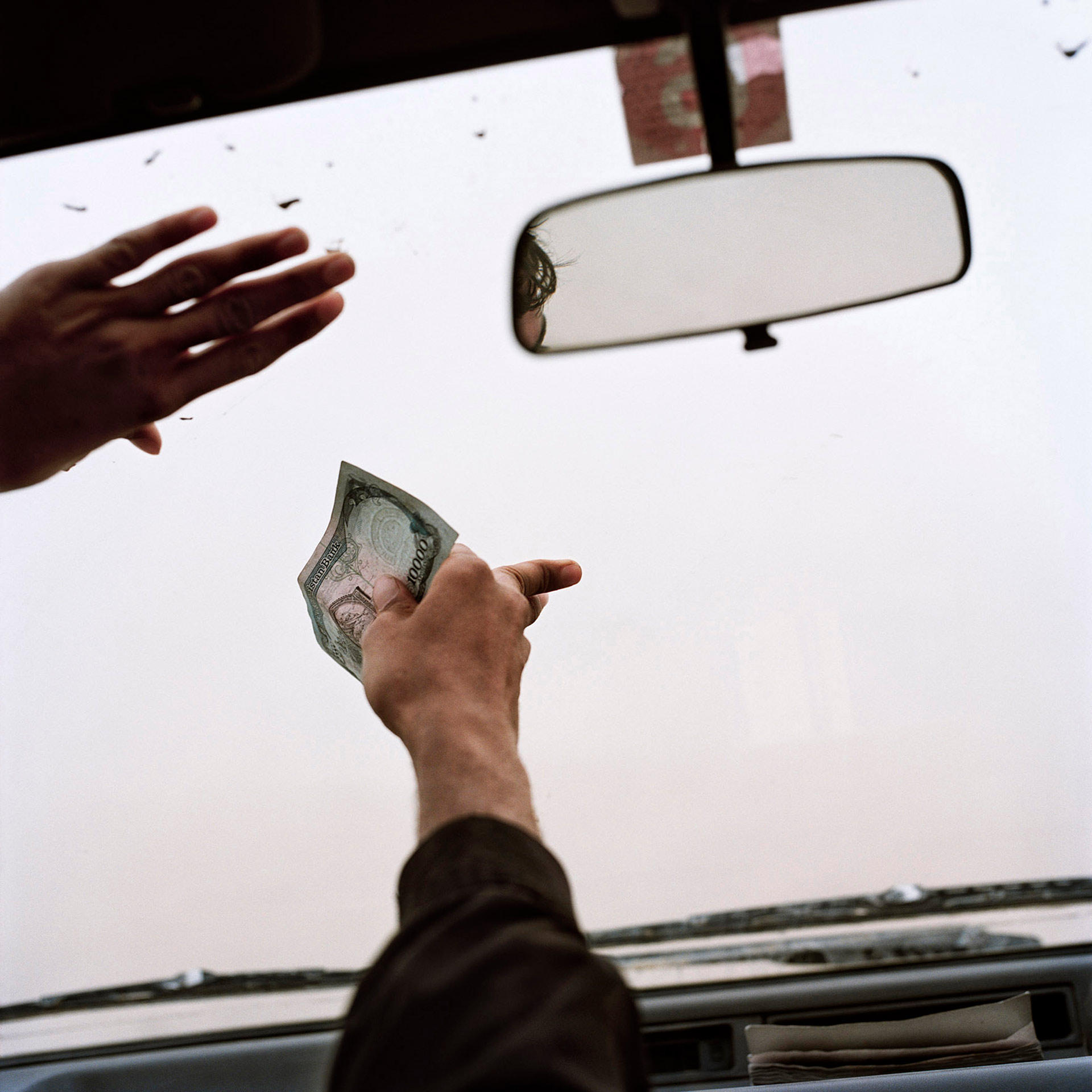
En route to Lashkargah a fierce sandstorm obscures vision as the driver holds onto the vibrating windscreen. Helmand Province, Afghanistan. 26 March 2001.
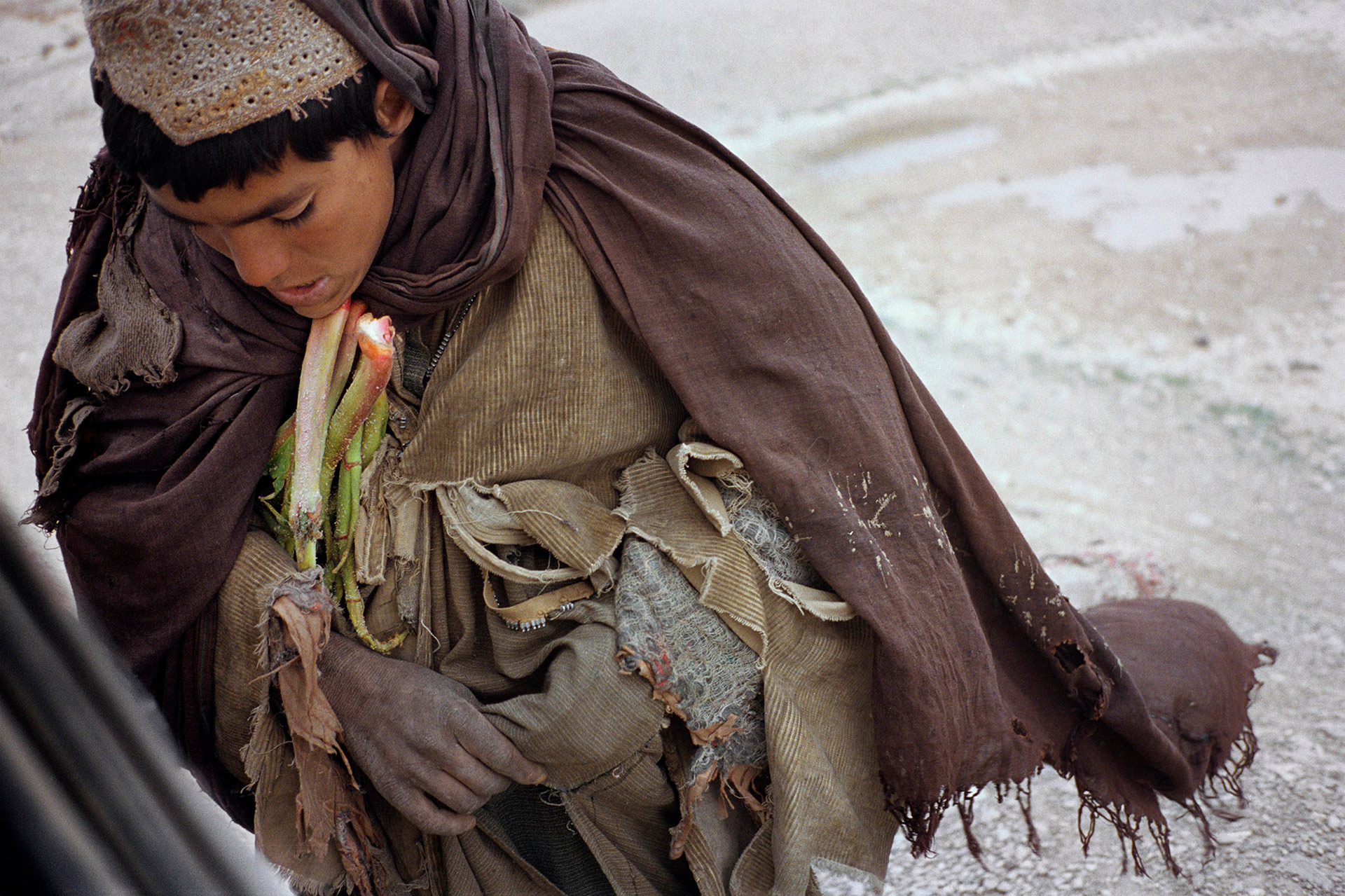
A rhubarb-seller along the Soviet-built “Betonka” that connects Kandahar and Herat. Farah Province, Afghanistan, 27 March 2001.
The Shebargan gas pipeline after a night-time attack and with carcasses of Soviet APCs. The pipeline also bears witness to how children experience and depict decades of war. Between Mazar-e-Sharif and Balkh, Afghanistan. 17 October, 2001.
Exploitation of Afghanistan’s fossil resources began in 1967 on the Khowaja gas field east of Shebergan.
It was there that the former Uzbek warlord, Abdul Rashid Dostum, who still holds power in Kabul and has a long history of siding with winners during every phase of Afghanistan’s long-drawn-out war, started his political and military career. The pipeline to Mazar-e-Sharif would serve Dostum as one of several lifelines.
In the mid-1990s, when the “New Great Game” for oil was being played out in Afghanistan, among the many pipedreams being dreamt were those of the Argentinian company Bridas and the California- based Unocal (with former U.S. Secretary of State Henry Kissinger—architect of the covert bombing of Cambodia—as consultant). They saw Afghanistan as the key that would unlock the oil and gas fields of Central Asia and as a transit corridor for pipelines connecting these to the Indian Ocean in Pakistan.
Once the Taliban had unified the country (with the exception of the Tajik Panjshir) and routed the warlords responsible for its fragmentation, they resumed the negotiations the two companies from beyond the Atlantic had initiated with Ismael Khan, Dostum, Rabbani, Masud and Niyazov, the communist-style dictator of Turkmenistan.
Little was known about the Islamist organization and its reclusive leadership in those days, but there was no doubt that its expansion had geostrategic implications. From an American perspective, “a gas pipeline through Afghanistan was not only attractive because it avoided Iran, but it would signal support to Turkmenistan, Pakistan and the Taliban while clearly snubbing Russia and Iran.” (Ahmed Rashid, Taliban, 2000)
What the foreign managers had tried euphemistically to sell as a “peace-making business” was destroyed by 9/11.
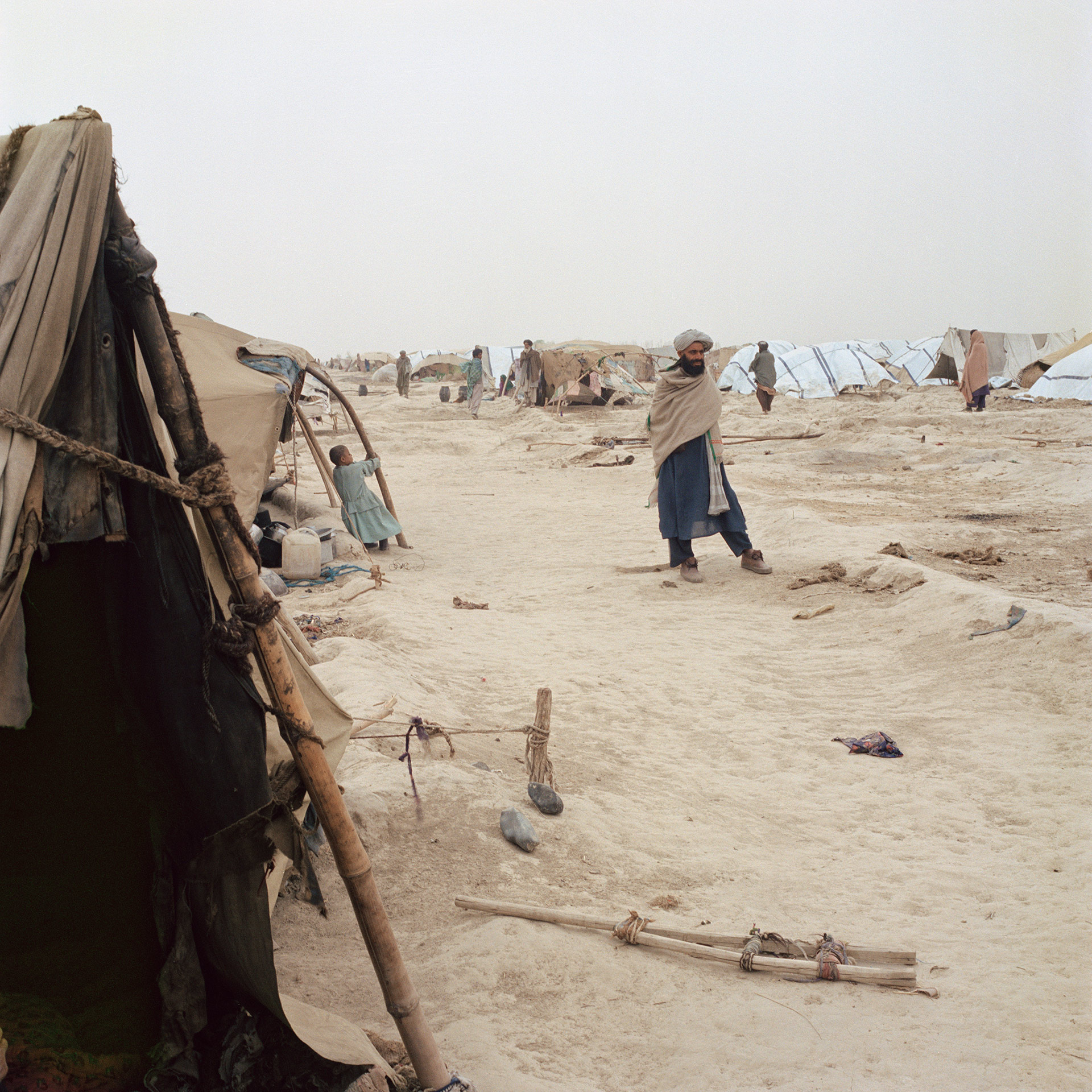
In a camp of Kuchi nomads. Taloquan, Helmand Province, Afghanistan. 24 March 2001.
These nomads were rescued by helicopter from the Registan Desert. The WFP and Oxfam criticized the operation on the grounds that clans and families were torn apart. Should the Taliban have left them stranded next to their dead camels and the wells which had gone dry because of the drought?
Yet it was also said that before the rescue the Taliban had forced the Kuchi to clear landmines. They knew that no-one was better acquainted with the deadly legacy sown by the Soviet forces when they began their withdrawal in October 1988.
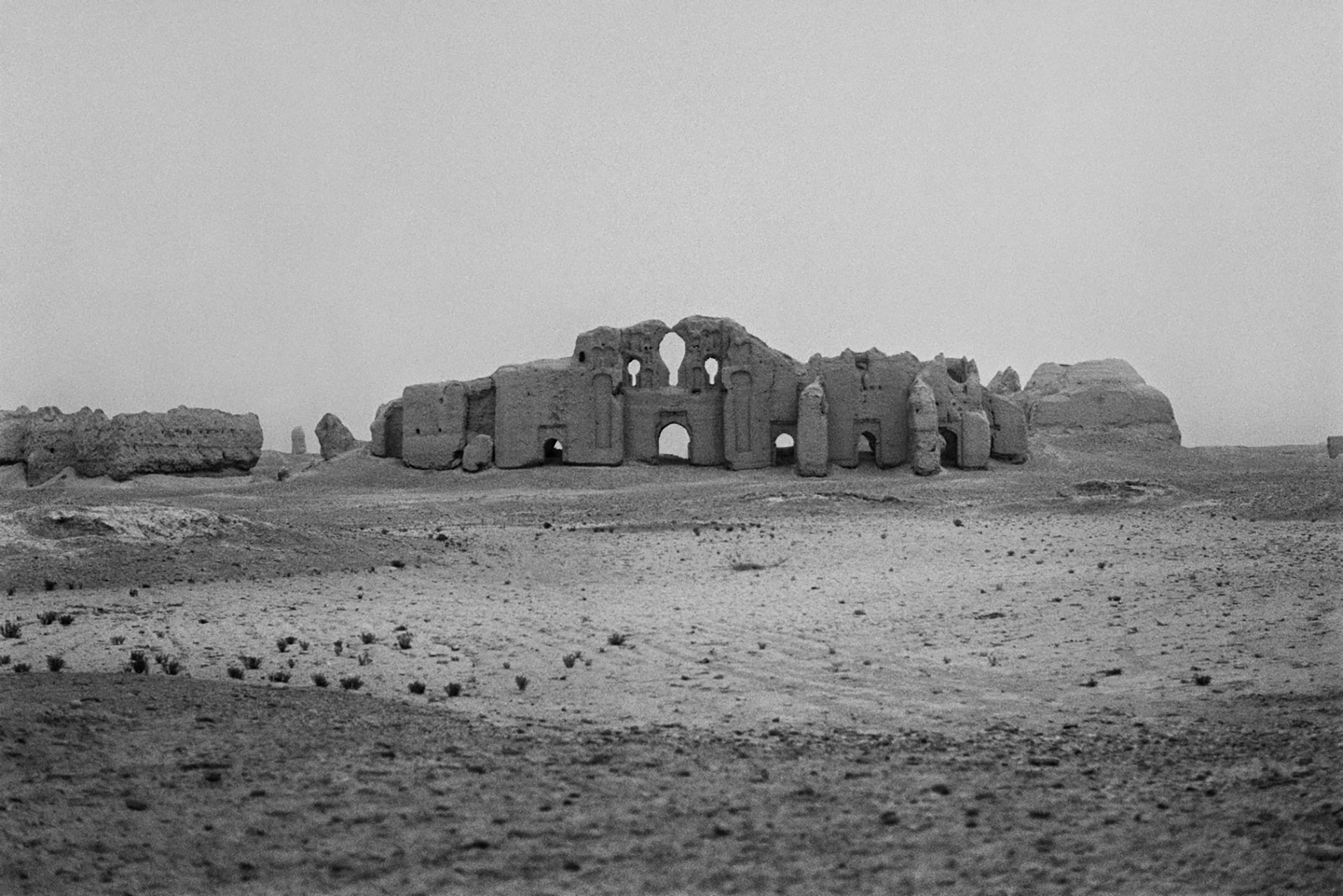
A sandstorm obscures the ruins of Bost, Lashkargah, Afghanistan. 26 March 2001.
The Ghaznavid winter capital of Bost prospered from the mid-11th century to the mid-12th century. It was looted by the Ghorids from what is today north-western Afghanistan and was completely razed by Ghengis Khan’s cavalry in 1220.
Ancient Bost, or Qala-e-Bost, was taken by early Arab conquerors around 661 (40/41 after Hijrah). The Arab traveller Ibn Haukal has left us the following description of it: “The inhabitants of Bost are polite and generous, resembling in dress and manners the people of Iraq. It is a city well supplied with provisions, fruits, and dates. They trade from the city with Hindustan.”
The Arabs’ control of Bost as a stronghold from which to take the regions of Kandahar and Kabul was tenuous and intermittent as they were constantly defeated by local tribes.
History would repeat itself in post-9/11 Afghanistan, when nearby Lashkargah, Bost’s successor town and the capital of Helmand, became the epicenter of the coalition forces’ bloody struggle in the south. Of the ca. 3,500 coalition casualties since the 2001 invasion, the vast majority have been Americans, British and Canadians assigned responsibility for the flashpoint province south of Kandahar.
Lashkargah remains volatile to this day. A twin blast at an agricultural show killed four and wounded thirty as recently as 23 March 2019.
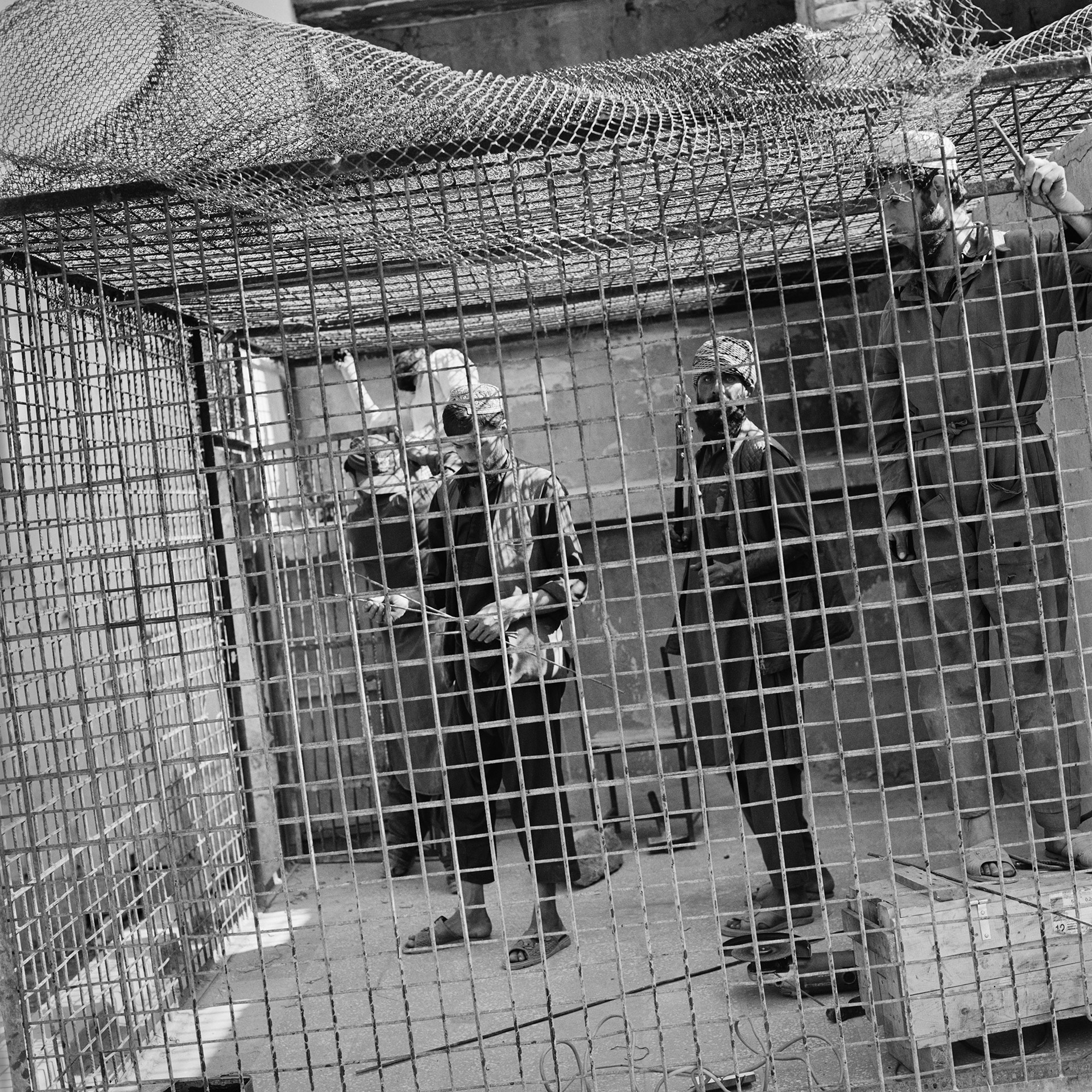
Zookeepers fixing a cage under the watchful eyes of a Talib. Kabul, Afghanistan. 17 June 1998.
Only a few of the zoo animals survived the battle for Kabul and those that did seemed immensely disturbed by years of incoming rockets and shelling.
Years later, when visuals emerged of captured Taliban kneeling in the cages of the U.S. Guantanamo Bay detention camp, this photograph took on new and disturbing connotations.
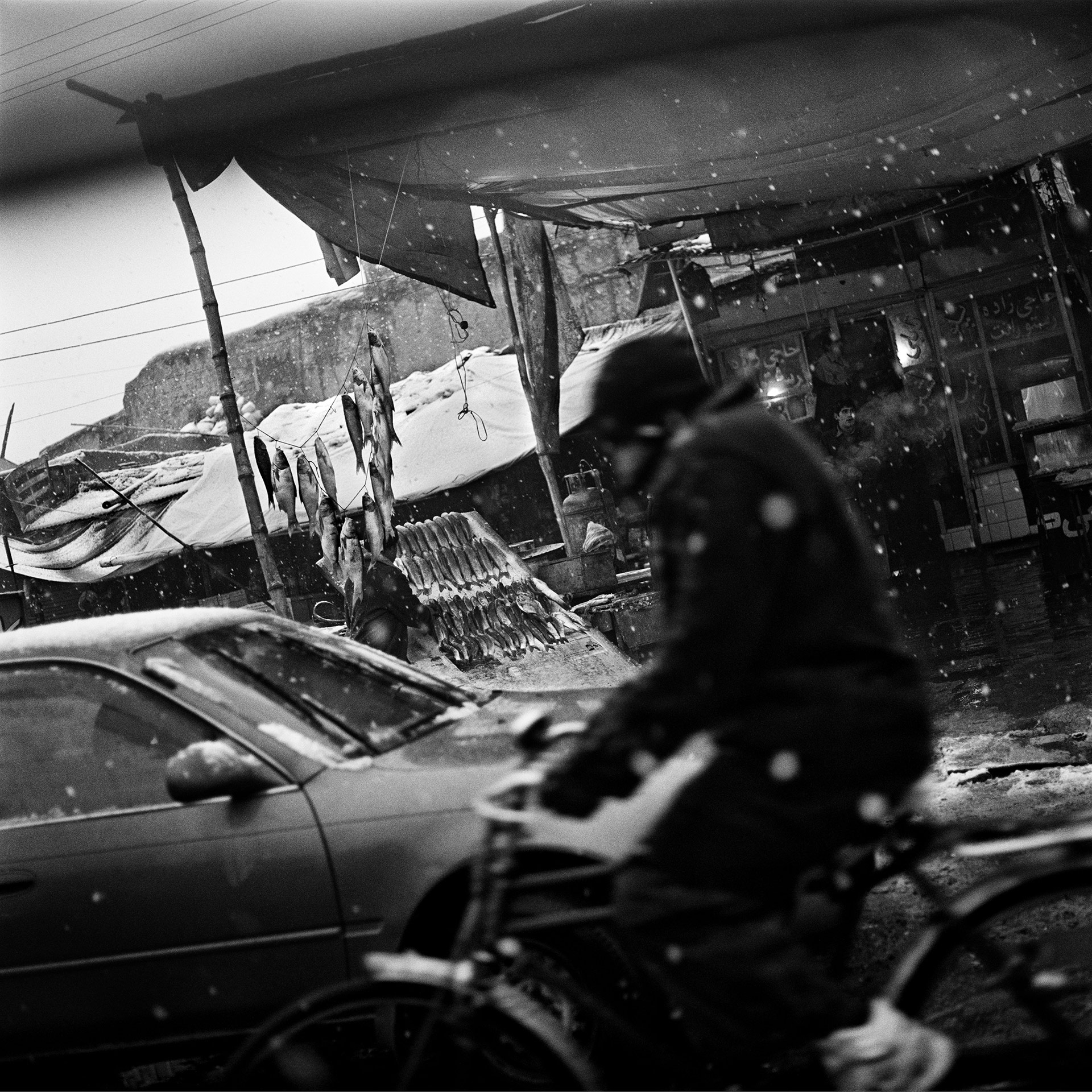
A scene along the Kabul River. Kabul, Afghanistan. 4 December 2006.
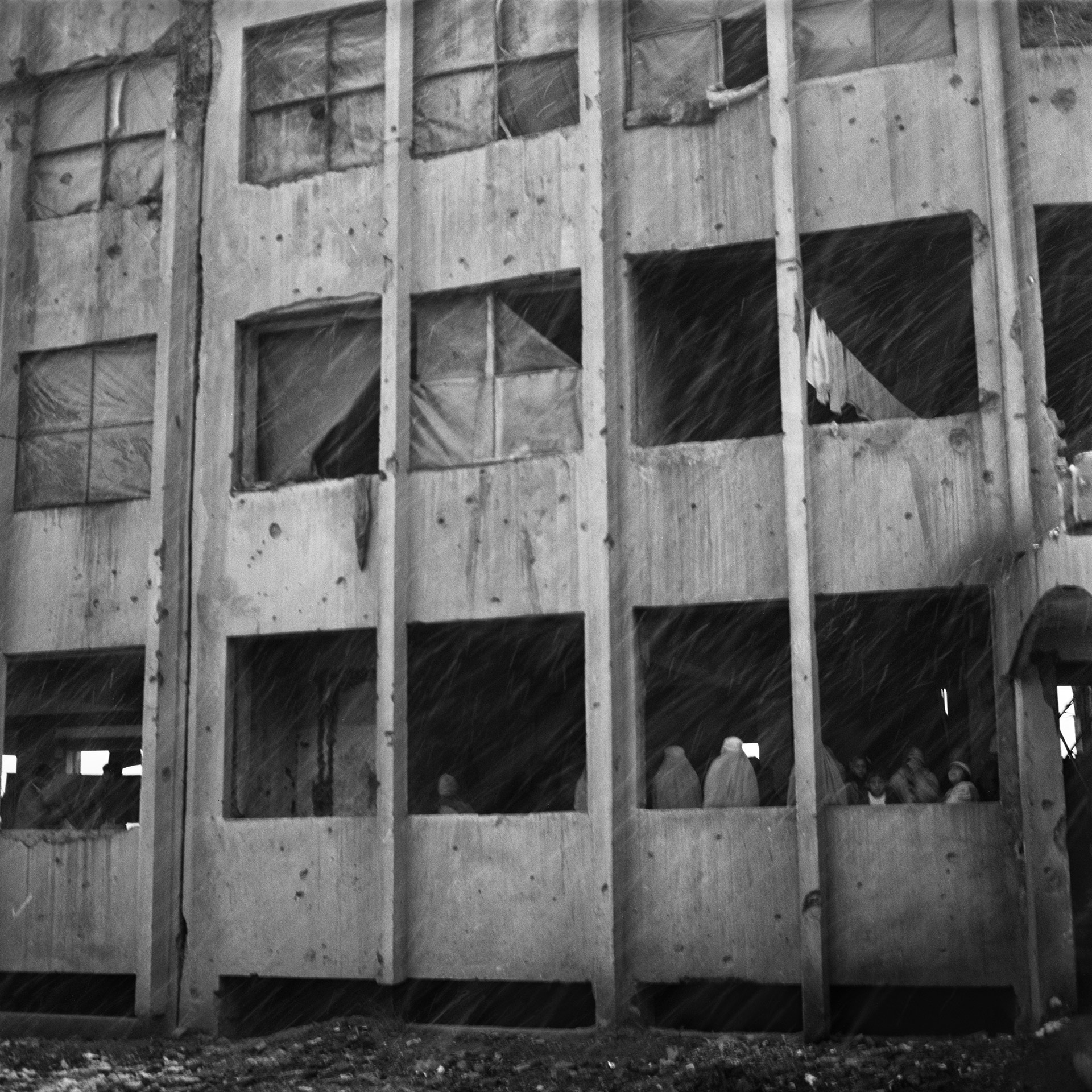
Ruins of a former government building on Darulaman Avenue. Kabul, Afghanistan. 21 June 1998.
After the fall of the Taliban in the winter of 2001/2002, the building became a makeshift home for Afghans who had fled the Afghan-Soviet war and then returned to Kabul. Often they found themselves stranded in conditions worse than those in the camps around Peshawar in Pakistan, where they had lived for decades and many had been born.
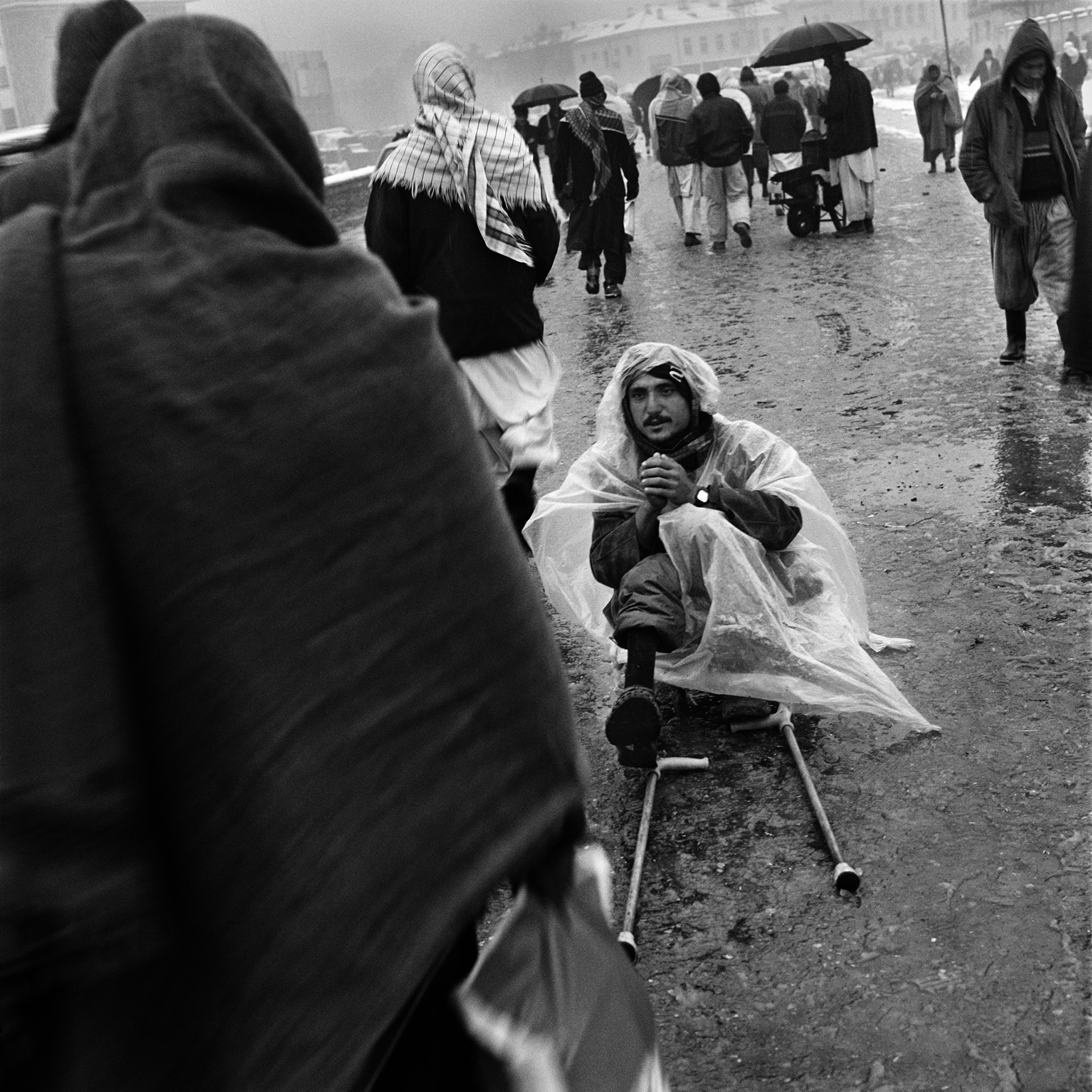
A scene along the Kabul River. Kabul, Afghanistan. 4 December 2006.
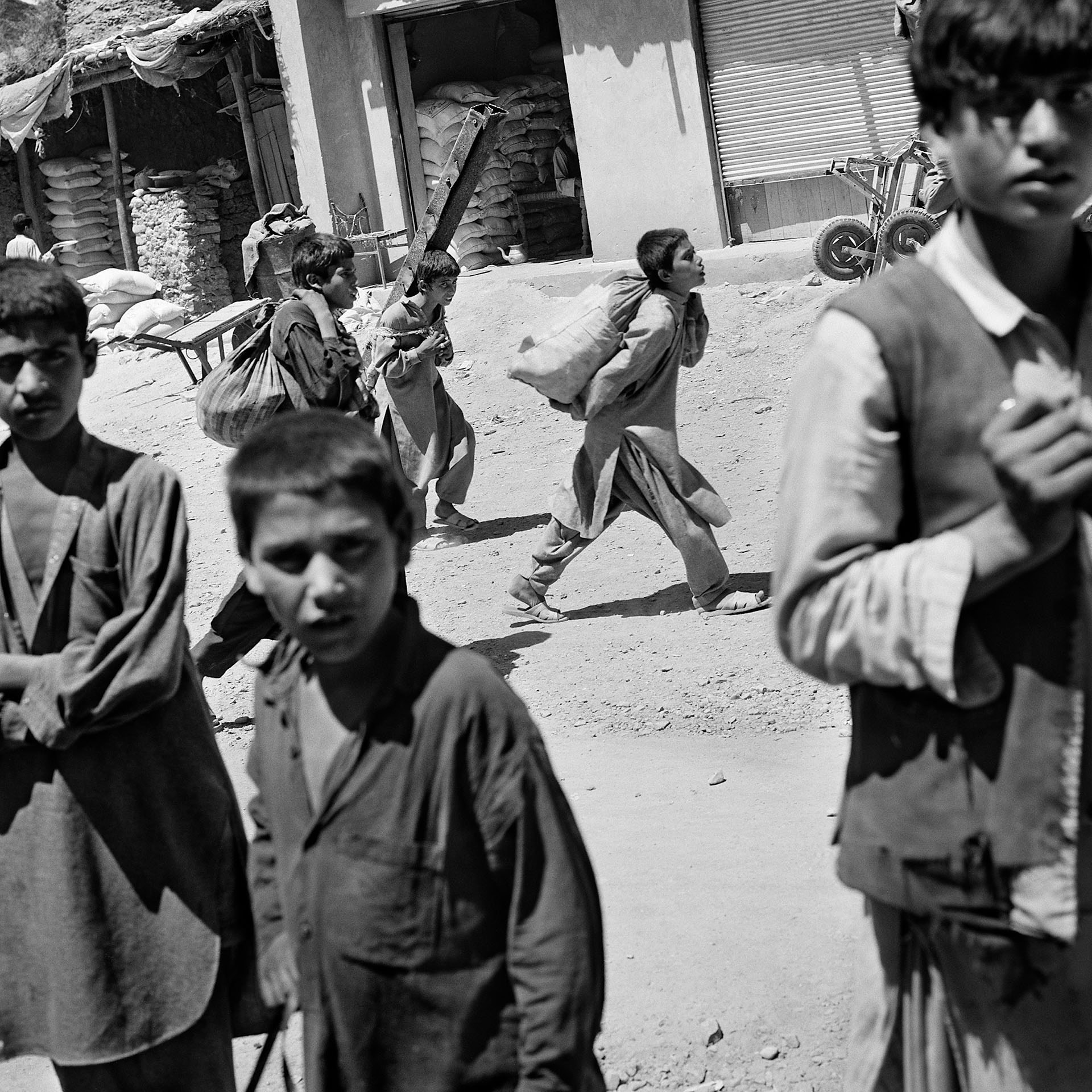
On the Afghan side of the border crossing. Thorkam, Afghanistan/Pakistan. 16 June 1998.
The child carrying an iron bar was the weakest and last link in a scrap metal odyssey that began in the dismantled plants of a long defunct Central Asian command economy and ended in the steel mills of Pakistan.
When the Salang Tunnel was closed because of fighting between the Taliban and the forces of Masud and Dostum, the trucking route grew to 2,500 km instead of 700 km long, and hence took two weeks. From the border of Turkmenistan it led along the ring-road via Herat, Kandahar, Ghazni and Jalalabad to Thorkam. The last stage, that is to say, the actual smuggling from Afghanistan across the Tribal Area to an undisclosed assembly point in Pakistan, was done by porters and donkeys.
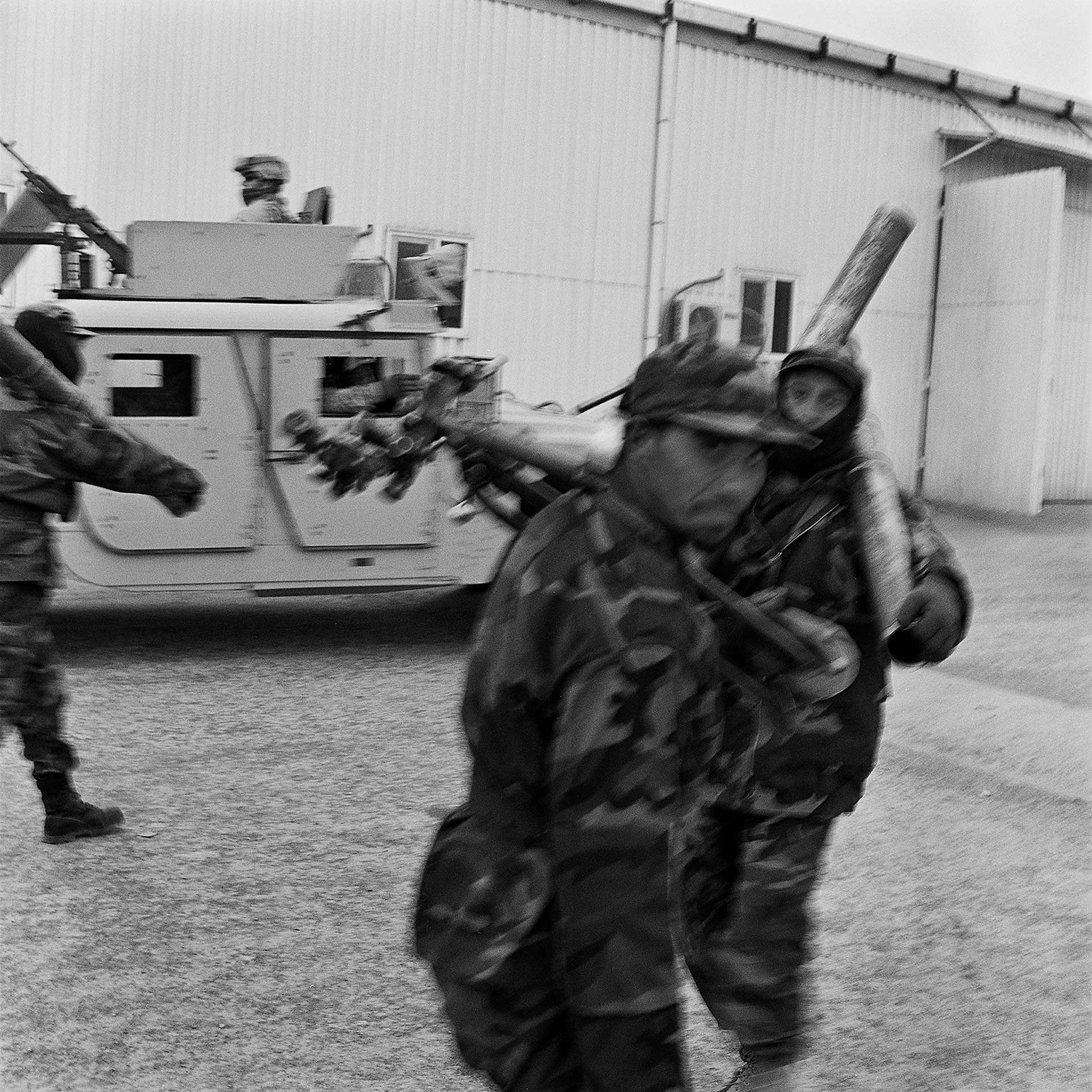
A scene of confusion at the Afghan National Army training camp on Jalalabad Road. Kabul, Afghanistan. 28 November 2006.
The lack of properly prepared and readily available plans for operations in Afghanistan after 9/11 was to have fatal consequences for America. Being the first on the ground, CIA operators began by leveraging intelligence assets and personal relationships with anti-Taliban militias, mainly the Northern Alliance, and entered into partnerships that ultimately undermined the creation and role of the ANA and Afghan National Police (ANP).
What follows are some of the lessons learned and discussed by John F. Sopko, Special Inspector General for Afghanistan Reconstruction (SIGAR) in “Reconstructing the Afghan National Defense and Security Forces. Lessons from the U.S. Experience in Afghanistan,” September 2017.
Eventually, “the 2002 division of security sector reform into the five independent silos of military reform (U.S.), police reform (Germany), judicial reform (Italy), counter-narcotics (U.K.), and disarmament, demobilization and reintegration (Japan) undermined each individual program’s success as the process lacked the required coordination and synchronization effort.”
As senior U.S. and NATO officials took ownership of the Afghan National Defense and Security Forces (ANDSF), little input came from senior Afghan officials. “The lack of Afghan ownership of force development, operational planning, and security sector governance prevented the Afghans from effectively overseeing and managing the ANDSF following the security transition at the end of 2014.”
“The United States largely ignored the transitional security forces operating throughout Afghanistan, as well as the political imbalances throughout the rank-and-file that were eroding security, both of which were often supported by host-nation elites. As a result, major social and political imbalances remain with the ANDSF to this day.”
“Western advisers are likely to step in to perform jobs [with advanced weapon systems and vehicles, demand-based supply systems, and high-tech personnel and command and control systems] rather than see the tasks done poorly or not at all. In Afghanistan, this reliance on U.S. support created a chronic dependency within the ANDSF.”
“The constant turnover of U.S. and NATO advisors impaired the training mission’s institutional memory and hindered the relationship building required in security sector assistance.”
“Since 2002 the ANDSF has been raised, trained, equipped and deployed to secure Afghanistan from internal and external threats, as well as to prevent the re-establishment of terrorist safe havens. To achieve this outcome, the United States devoted over 70 billion dollars (60 percent) of its Afghanistan reconstruction funds to building the ANDSF through 2016, and continues to commit over four billion dollars per year to that effort.”
Nearly 7,000 U.S. soldiers and sailors have been killed in America’s post-9/11 wars, as have between 480,000 and 507,000 residents of the countries in which they were fought: Afghanistan, Pakistan and Iraq. In Afghanistan 32,000 civilians were killed and another 60,000 wounded alone between 2008 and 2018.
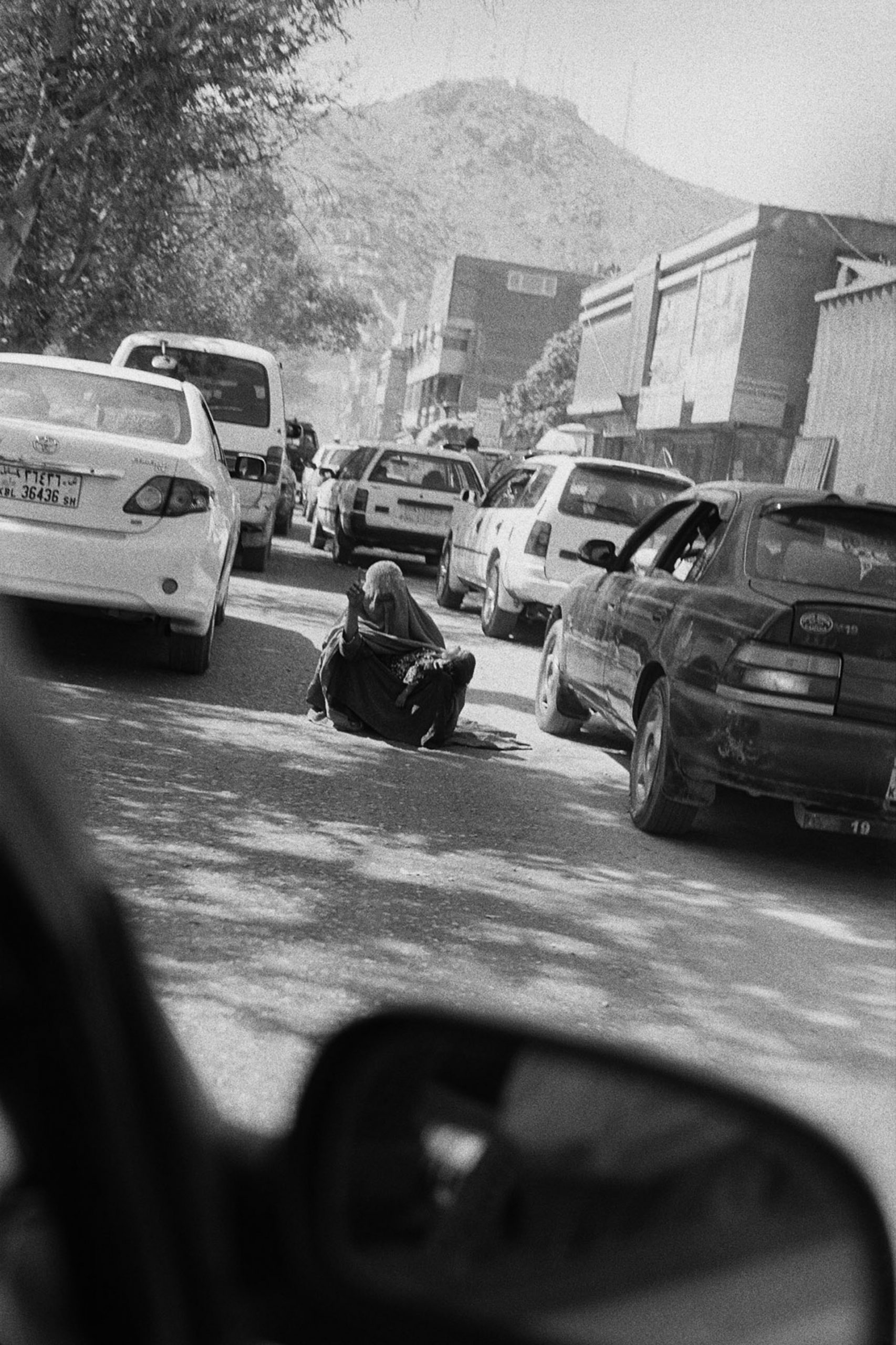
A woman with her child begs amidst cars stuck in the morning rush hour. The forest of masts and antennas on the Asamayi Heights bears witness to almost two decades of attempts at Western cultural re-education. Kabul, Afghanistan. 11 September 2012.
In December 1879, during their siege of the Sherpur Cantonment in the Second Anglo-Afghan War, the tribesmen of Mohammad Jan Khan Wardak gathered on Asamayi Hill. A beacon lit by a cleric on the summit signalled the impending attack by the enormous Afghan army. Bombed by British artillery and pursued by British and Indian cavalry, the Afghans eventually escaped to Ghazni. Today the Heights are known as “Television Hill.”